
#324 – 2022/23 FREE CASSETTES FOR KIDS MOTEZ AKG 75TH ANNIVERSARY ANNUAL GEAR GUIDE REVIEWED: FENDER JOE STRUMMER TELECASTER NEKTAR IMPACT LX MINI UNIVERSAL AUDIO VOLT 476P FOCUSRITE ISA ONE + MORE RED HOT CHILI PEPPERS BANGIN’ THE GONG
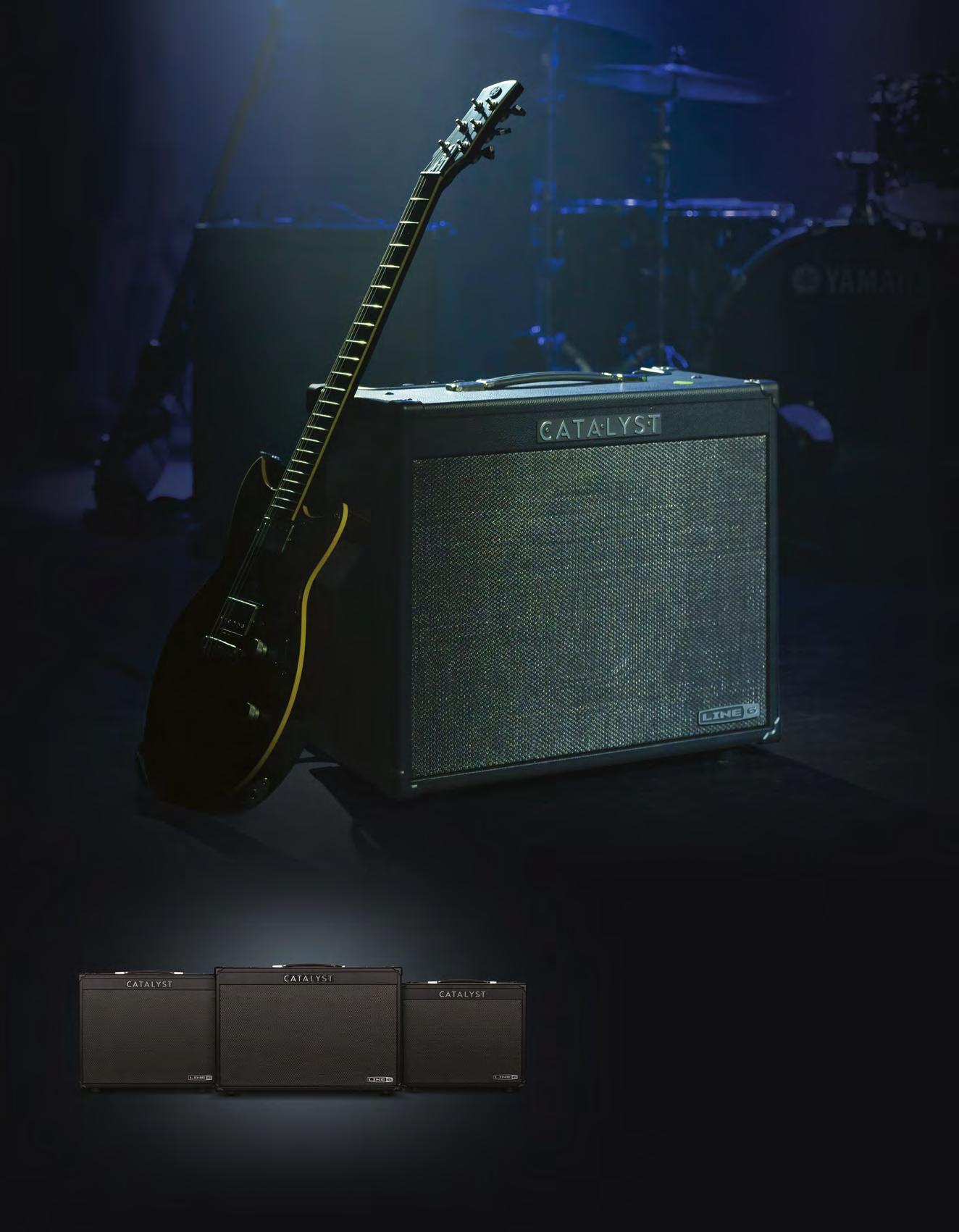
The Sunn O))) Life Pedal V3 circuit has been meticulously tweaked from the original to squeeze every last drop of heavy crushing tone available. The octave section has been finetuned to make it more pronounced without losing the bottom end and we added a third footswitch, utilising Flexi Switch Technology, for the octave to allow an additional method of quick and radical tone shaping.
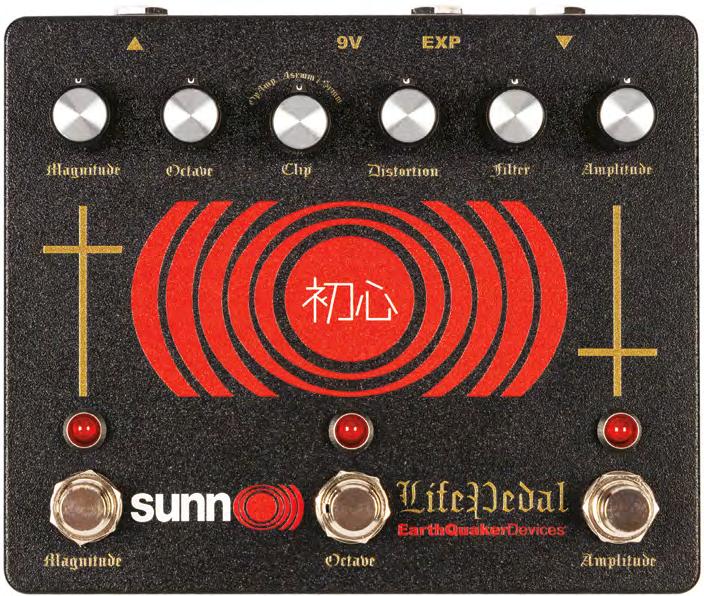 Hand Made Effects Pedals | Akron, Ohio
Hand Made Effects Pedals | Akron, Ohio
O))) Life Pedal
Octave Distortion + Booster earthquakerdevices.com
Available Now See it in action >>>
Yamaha Music Australia proudly distributes EarthQuaker Devices
Sun
V3

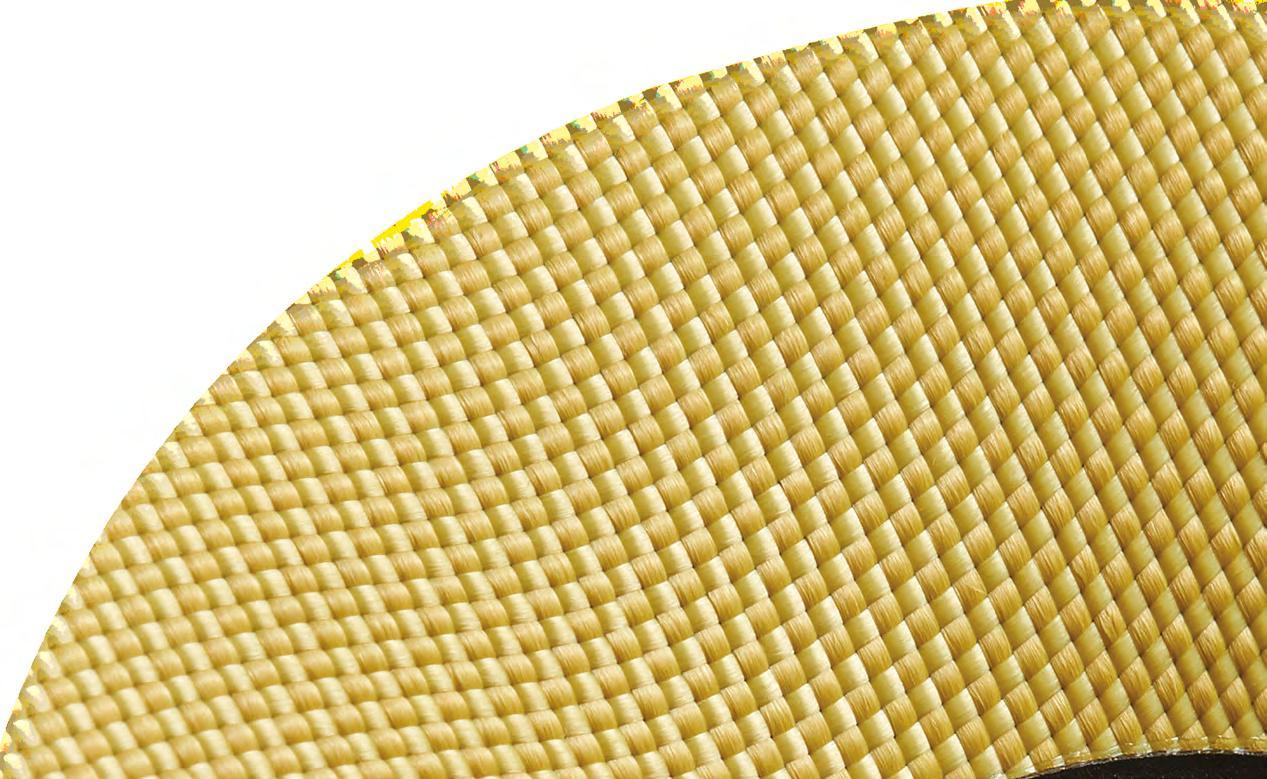

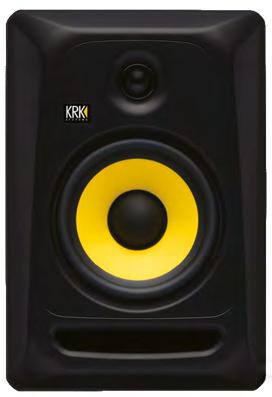
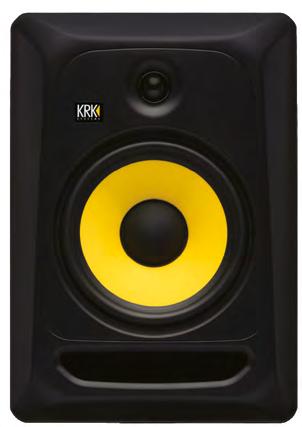


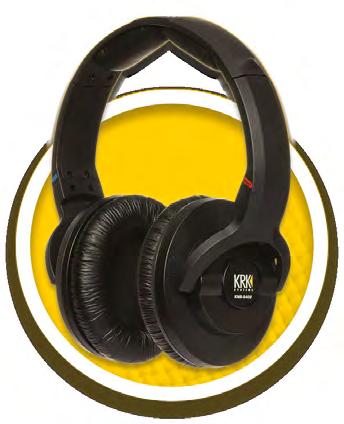
distributed by jands.com.au GoAux 3 GoAux 4
PUBLISHING DIRECTOR Patrick Carr patrick@furstmedia.com.au
CONTRIBUTORS
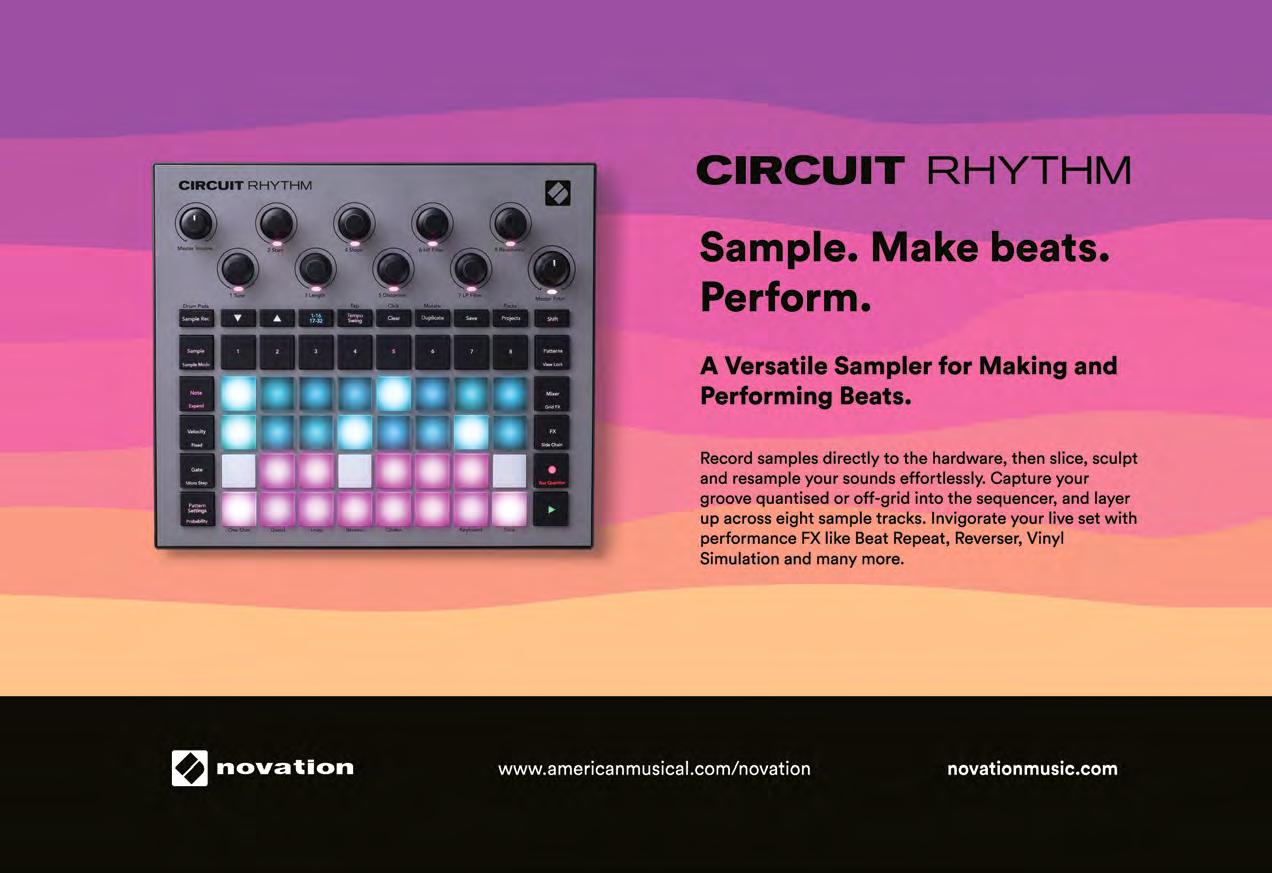

Will Brewster, Nick Brown, James Callanan, Cambell Courtney, Christie Eliezer, Eric Foreman, Rob Gee, Peter Hodgson, Greg Long, Liam McShane, John Tucker, Adrian Violi
FOUNDER
Rob Furst


Cassettes For Kids PG. 14 CONTENTS Product News Cover Story: Red Hot Chili Peppers Cassettes For Kids Brand Spotlight Turramurra Annual Gear Guide Talkin’ Tech Columns Reviews My Rig: Motez / MIXDOWNMAGAZINE @MIXDOWNMAGAZINE @MIXDOWNMAGAZINE MIXDOWNMAG.COM.AU For breaking news, new content Turramurra PG. 25 Red Hot Chili Peppers PG .12 10 12 14 18 25 26 46 48 54 74 PUBLISHER
Media
Weston St
EDITOR
DESIGNER
Furst
A1 1-5
Brunswick VIC 3056 (03) 9428 3600 PRINT
Paul French paul@furstmedia.com.au ONLINE EDITOR Eli Duxson eli@furstmedia.com.au GRAPHIC
Erica May EDITORIAL ASSISTANT Lewis Noke Edwards Andy Lloyd-Russell ADVERTISING MANAGER Paul French paul@furstmedia.com.au




























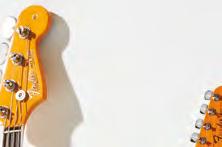


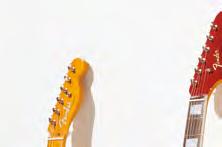
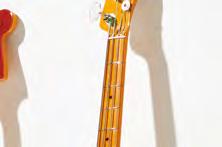
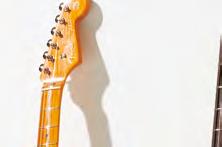
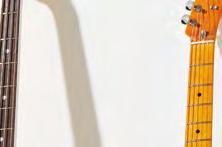


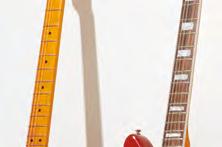





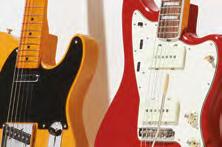


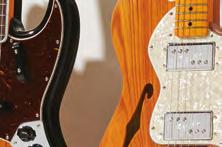
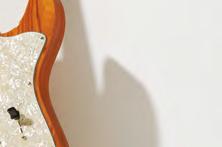


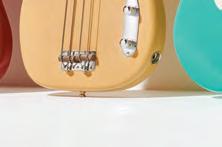
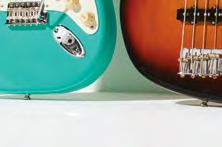

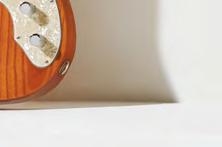



















INTRODUCING THE NEW 1951 TELECASTER ® IN BUTTERSCOTCH BLONDE, THE NEW 1966 JAZZMASTER ® IN DAKOTA RED, THE NEW 1954 PRECISION BASS ® IN VINTAGE BLONDE, THE NEW 1957 STRATOCASTER ® IN SEAFOAM GREEN, THE NEW 1966 JAZZ BASS ® IN 3-COLOR SUNBURST AND THE NEW 1972 TELECASTER ® THINLINE IN NATURAL ©2022 FENDER MUSICAL INSTRUMENTS CORPORATION. ALL RIGHTS RESERVED.
BRAND NEW AGAIN BUILT TO ORIGINAL SPECS. ALL OF THEM.



The Melbourne Guitar Show returns after three years MELBOURNE GUITAR SHOW |
MELBOURNEGUITARSHOW.COM.AU
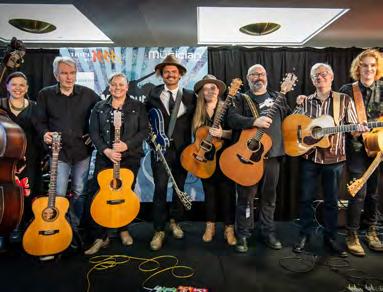
After three long years, the Melbourne Guitar Show is returning in 2023 in all its glory. Happening on March 4 and 5 at the Caulfield Racecourse, guitar fanatics can expect all kinds of retailers from the big boys to the boutiques, over 50 exhibitors, and no doubt some pretty hefty guitar discourse with nearly five thousand dedicated musos and a smattering of information sessions and seminars. And what would a guitar expo be without live music? Musicians of all types will take to the stage over the two days with talent and inspiration aplenty.
Alesis launches new mesh Special Edition electronic drum kit

ELECTRIC FACTORY | ELFA.COM.AU
Alesis has launched two new mesh Special Edition electronic drum kits, the Surge and Command. The more upmarket Command Mesh Special Edition boasts large pads with tightly woven mesh drum heads. The 10” snare and 8” tom pads are all dual-zone, there’s an 8” mesh kick drum pad, and for cymbals there’s a 10” crash with choke, a 10” ride with choke, and a 10” hi-hat that includes an expressive foot control pedal. The Command Advanced Drum Module features 74 kits (54 factory + 20 user) and 671 sounds that span a variety of genres and styles.
Ernie Ball releases ‘Comfort’ range of guitar slides

CMC MUSIC | CMCMUSIC.COM.AU
Upgrade your slide performance with unsurpassed comfort and control. The Ernie Ball Comfort Slide is fitted with a soft inner sleeve for a secure fit, giving you maximum control as you slide up and down the fretboard. The brightly coloured sleeve keeps visibility high in dark environments and provides a soft, cushioned barrier from the slides’ rolled metal edge. Suitable for electric and acoustic guitars, this slide features smooth, durable, black chrome plated brass that allows the notes to ring out with a bright, chime-y tone and maximum sustain. They’re offered in Small (5-7 ring size), Medium (8-10), and Large (11-13).
Lehle releases small footprint active volume pedal
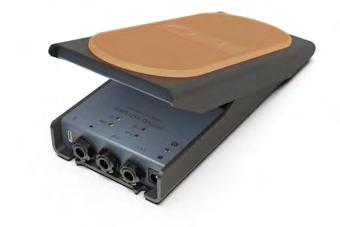
EGM DISTRIBUTION | EGM.NET.AU
Lehle has released the small footprint Mono Volume S pedal. Here, you get an active, durable, and uncompromising volume pedal. Equipped with the same magnet sensor VCA technology of other Lehle volume pedals, you control the volume of your instrument precisely. As it has no mechanical potentiometer, the typical noise, endlessly expensive repairs, and complicated adjustment can be avoided. There is 120dB of dynamic range thanks to the 30V input voltage transforming technology, as well as MIDI via USB for DAW or amp sim connectivity.
FOCUSRITE AUSTRALIA | FOCUSRITE.COM
Sequential has unveiled the last analogue synth created by the late great synth pioneer Dave Smith. The Trigon-6 is Sequential’s polyphonic take on the classic, thick, and creamy, three-oscillatorplus-ladder-filter analog sound that defined the dawn of the synth era. At the heart of the Trigon-6 sound are three newly designed voltage-controlled oscillators (with triangle, saw, and pulse waves) and an enhanced version of the ladder filter that Sequential created for its Pro 3 mono synth. To give even more classic organic warmth to an already classic synth, there’s the vintage knob, which adds voice-to-voice variations in calibration and component behaviour.
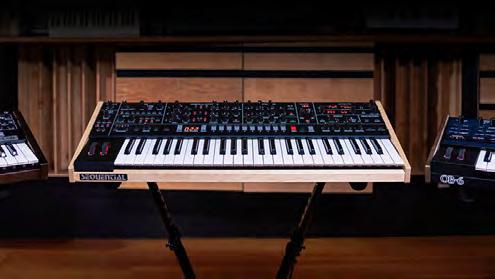
10 mixdownmag.com.au PRODUCT NEWS
Sequential Trigon-6: The last brainchild of the late great Dave Smith
The legendary Minimoog Model D returns to production
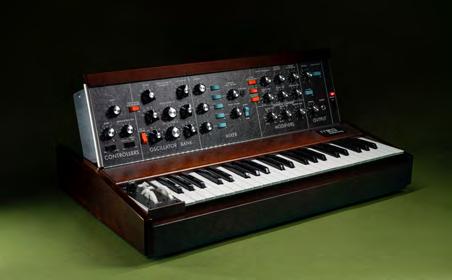
INNOVATIVE MUSIC AUSTRALIA | INNOVATIVEMUSIC.COM.AU
More than a half-century since its invention, the legendary Minimoog Model D is back in production at the Moog factory. The all-analog instrument gained acclaim for combining the sound of the 1960s Moog modular synthesisers with the accessibility of pre-wired modules, meaning that it could be played instantly and intuitively with no patch cables required. The coveted sound engine and audio signal path remain identical to the Model D that Bob Moog and his team engineered in the 1970s. This latest edition of the instrument also includes the series of popular functional modifications from the 2016 production run that expanded this synth’s capabilities.
beyerdynamic introduces detachable PRO X Lightning and USB-C cables

SYNCHRONISED TECHNOLOGY | SYNTEC.COM.AU
beyerdynamic has upped the game for headphone functionality releasing the new PRO X Lightning cables, USB-C cables, and PRO X headphone packs for seamless transitions between devices or cross-checking mixes on the fly while sustaining high audio quality. The Lightning cable enables professional studio quality sound on your iPhone, iPad, or iPod thanks to the plug-andplay functionality of the cable and the built-in, high-end Apple A2M digital-to-analogue converter (DAC). The USB-C cable provides the same functionality to a USB-C port and features a high-quality built-in ESS DAC. The cables are sold separately or with the PRO X headphones.
MESA/Boogie unveils Badlander
25 Head & 1×12 Combo
AUSTRALIS MUSIC |
AUSTRALISMUSIC.COM.AU
MESA/Boogie has unveiled the new Badlander 25 Head and 1×12 Combo to extend the Badlander range. The Badlander 25 Head and 1×12 Combo delivers the Rectifier-inspired voice and performance of the Badlander 100 and 50, offering a fiery-sounding, ultra-portable low-power option for those not needing big horsepower. The same simple two-channel format, each containing clean, crunch, and crush modes repeated, fits perfectly within this small EL84-powered rendering with a fierceness and harmonic complexity all its own. Like all Badlanders, the Badlander 25 1×12 Combo packs their CabClone IR Direct Interface making recording and cabless live capture easy.
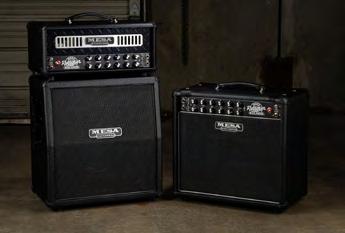
Markbass packs stacks of tone and power in the portable Little Mark 58R

CMC MUSIC | CMCMUSIC.COM.AU
The new Little Mark 58R amp design places all the connections and controls on the front panel leaving only speaker and power sockets on the back panel, offering optimal ergonomics and making everything more practical. This amp features an updated four-band EQ section, a new bi-band limiter paired with a 500-watt MPT power amp, a mute switch, and a threeway rotary-switch that includes the options of flat, scooped, or FSW (footswitchable) EQ, all in a high build quality yet ultralight new ABS chassis. A super portable package that weighs just 2kg.
Lehle extends P-ISO series of signal isolating devices
EGM DISTRIBUTION | EGM.NET.AU
The P-ISO series from Lehle can effectively suppress background noise and eliminate annoying ground loops, while they can also be used in live and recording situations as a handy reamplification tool. Joining the existing P-ISO series are two new signal isolating devices the P-ISO XLR TRS and the P-ISO TRS XLR. At the core of each is the high-end Lehle Transformer HZ, which galvanically isolates the signal, eliminating any possibility of ground loops. The Lehle Transformer HZ was specially designed for use with high-impedance signals but also processes low-impedance signals with “uncompromising” sound quality.

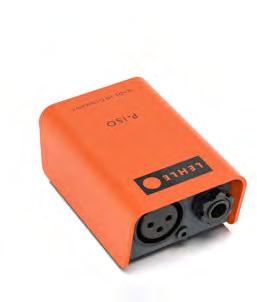
11 mixdownmag.com.au PRODUCT NEWS
Red Hot Chili Peppers

Detroit-drummer Chad Smith was a denim-clad, long hair and bandana type of operator when he moved to Los Angeles in 1988. The antithesis of the Sunset Strip subverters in the Red Hot Chili Peppers.
The Chili Peppers had yet to break through in the sense we know them today and were in the midst of rebuilding, but had gained quite the cult following for their crazy stage antics, high-octane performances, and choice haircuts.
So when Chad walked into the Hully Gully rehearsal studio to audition for the band, he could have never imagined what was to come.
Fast forward 34 years later and that same socksporting fleet of funk-rockers have conquered the globe, releasing two double LPs in 2022, Unlimited Love and Return of the Dream Canteen
“To be still relevant, playing, and making new music with people filling up stadiums all over the world – it’s insane! It is, come on,” Chad exuberantly and laughingly reflects from his Long Island abode in the lead up to Thanksgiving.
“The Chili Peppers?! The guys with the socks on their dicks?! We’re in the fucking Hall of Fame it’s unbelievable.”
Persistence has been a staple of the Chili Peppers through their many iterations, but the renaissance of quartet Smith, Flea, Anthony Kiedis, and wunderkind John Frusciante had fans buzzing.
The famed four made the Red Hot Chili Peppers a household name in 1991 with Blood Sugar Sex Magik, the same album which spawned many of the same writing techniques employed today.
Unable to record the new material for Blood Sugar due to being without a label, producer Rick Rubin implored them to continue writing, refining, and reworking the music. The result was having much more than the album required, but produced the best work they had done so far.
So when the pandemic hit, it’s needless to say the group got to work, got in a room, and just wrote, and wrote, and wrote.
“We all get in a room and just improvise, or somebody has an idea or a part from home,” Chad
explains. “It could be a bassline or a chord progression or I start a drum beat and those guys join in.
“We’ve been doing it long enough where somebody hits on a chord progression or riff or something we all kind of like, we all look at each other like, ‘Keep going, that’s pretty good!’. Anthony’s in the room too and will often go, ‘I can do something with that’.
“It’s always been like that… I think it’s possible that’s why we sound kind of unique because everyone’s involved in the creative process.”
Another aspect of their unique product stems from the dynamics of the band musically, essentially being a trio with Anthony’s vocals over the top which allows for so much space to work in the mix.
“The tendency is to fill it up,” Chad explains. “But I think you learn over time that often the simplicity and the space is what makes things really special.
12 mixdownmag.com.au
“There comes a time when you’re playing your instrument you just want to change up and see what inspires you.”
“Live, we tend to play a little bit more because we’re kind of a bunch of show offs, but on the record, there’s going to be other elements whether that’s John’s guitars, percussion, horns, keyboards, whatever we feel the song calls for.
“Some of our favourite bands were a three piece with vocals, Van Halen, Led Zeppelin, Black Sabbath. There’s no hiding though, you can’t layer a bunch of shit over it, pan seven guitars, what you hear is us playing. I think that connects with people. If you’re a good band and you can play well together, that’ll come across.
“We haven’t lost that perspective in today’s modern day of recording where you can have 64 tracks of shit – it doesn’t make it better.”
Driving that simplistic charge is producer Rick Rubin who has worked with the band on every record since Blood Sugar except for one.
“Often we can go on and on and on, play too much and too long,” Chad laughs. “He’s good at keeping it more concise and finding the thing about a piece of music that’s special or different and honing in on that.
“He hasn’t been writing and working on these songs for six or eight months like us, we’re very close to them, and then he comes in towards the end of the process where we have a bunch of songs and we play them for him. He has very objective ideas about them.
“Sometimes some things we think are really great, he’ll be like, ‘That’s cool, I like it, what else ya got?’ We’re like, ‘No, no! This is the greatest thing ever!’ Then we’ll play something that we jammed on one day and he’ll be like, ‘What’s that?!’. He’s got great ears and knows how to get the best out of people.”
Much is made of the relationship and chemistry Flea and John share with the bass boffin’s work getting him back in the band (twice) and their on-stage jams leading into songs.
Chad sees himself as the canvas for the rest of the guys to paint on top of, giving the Chili’s a solid foundation to support the lyric and melody. But despite the beautiful melodic elements John brings, rhythm is at the crux of it all through Chad and Flea’s masterful interplay.


“There’s no shortcuts in that musical telepathy that you have with someone, Flea and I have played a lot of notes and a lot of rhythms together,” Chad says. “We know each other so well, and the Chili Peppers are so rhythmoriented that it’s important we have an understanding of what’s the best thing for the song.”
While the lineup is back to what so many people fell in love with, there has been a significant change that might have gone unnoticed for many – Chad’s cymbals. His use of Sabian cymbals predated the Chili Peppers as after 35 years, he’s now transitioned over to Paiste.
“There comes a time when you’re playing your instrument you just want to change up and see what inspires you,” Chad explains. “I’ve used Paiste before on Blood Sugar Sex Magik, lots of records, lots of different things. But to use them live on tour, they were thinner cymbals, they weren’t as durable and I’d break them! So that was a bit of a problem.
“They’ve since made them a little more durable, they sound great, it was just time for a change. Nothing political. Some of the greatest rock drummers in the world played Paiste – John Bonham, Stewart Copeland, Phil Rudd, Jim Keltner, Keith Moon. Some of my favourite drummers!”
The latest addition to his cymbal setup is a 52” symphonic gong which has been present on their tour and will assume its position behind Chad when the Chili Peppers head down under in February.
“We love playing in Australia, and Flea is one of your countrymen so it’s special for him and us. I don’t know if we’ve done just football stadiums before!
“We added more shows and we’re going to be well rested to blow the minds of the young Australian people.”
BY ELI DUXSON
KIT:
• DW Collector’s Series maple/mahogany shells
• 16x24 bass drum
• 8x12 rack tom
• 14x14 floor tom
• 16x16 floor tom
• 16x 21 gong drum
• 10” vintage Staccato tom
• 7x12 side snare
• Cluster of 4 6” Rata toms various depths
•
• Remo 10” Rototom
•
•
•
•
•
•
•
•
•
•
•
•
•
13 mixdownmag.com.au
STORY: RED HOT CHILI PEPPERS
COVER
Alternates between 5.5x14 or 6.5x14 DW thin aluminum Snare drums
All DW 9000 series hardware
DW Single 5000 bass drum pedal
PAISTE CYMBALS:
12” 2002 Splash
15”
Signature Power Hi Hat top
15”
2002 Sound Edge bottom
19” 2002 Extreme Crash
20” 2002 Extreme Crash
24” 2002 Ride
24” 2002 Crash
20” PSTX Swiss Medium Crash
Stack 10” 2002 Mini China/12” PSTX Splash
• 10” PSTX Pure Bell
PERCUSSION: • LP Red Jam block • LP Chad Smith Cowbell • LP City Series High Hat Jingle Ring Double DRUMHEADS:
Remo Drumheads
Toms/Rata Toms-Colortone Emperor (Smoke Color) batter side
Clear Ambassador Reso side
CSX Coated snare
• 20” 2002 Spiral Cymbal • 52” Symphonic Gong
•
•
•
•
Ambassador Snare bottom
Powerstroke 3 Colortone (Smoke)
SMITH’S LIVE KIT
CHAD
Up Close and Personal: Cassettes For Kids
My first music memories all began when I was about three or four in my brother’s room listening to Metallica, Nirvana, and Pearl Jam to name a few.
I didn’t realise it at the time, but these were also my first memories of experiencing synesthesia where I was seeing different colours and spaces develop in my mind from the music. As I got older, I got a copy of Ableton 8 after getting inspired from the likes of LA Beat scene artists like Nosaj Thing, Flying Lotus, and TOKiMONSTA.
I had two schools of thought running at this time. On the one hand, I was extremely passionate about guitar/band type music but my mind was starting to open up to all of these experimental beats that I’d never heard anything like before. I kept both passions running, starting up in my first blues/psych band Elephant Ego with a few mates in 2012 and started throwing some beats on Soundcloud under ‘Cassettes For Kids’ around about the same time. The band started kicking off a little, we were playing shows, our first EP went really well and we sparked some momentum in our little scene. I had my eggs in that basket up until around 2014 when I was at a festival with my sister’s mate who told me quite late into the evening that he thought I should take the CFK stuff more seriously.
This kind of knocked me back a bit at the time, but I took his word seriously and put my head down, eventually putting out a track called ‘Enough’ which I entered into a competition to play at Strawberry Fields Festival. I ended up getting into the top 10 which landed me a slot to play. I whipped together a live set for the gig which to this day is the worst gig I have ever played, hands down. The music I had was put together quite haphazardly and I had no clue how to get a crowd to dance. This wouldn’t have been so painful if it wasn’t for the fact that I had my friends along with everyone we were camping with for the weekend (people I had never met) watch me get up there and fail quite miserably.

Right now, what I’m making has been a big diversion away from the dance music I’d made in the past and would now fall under a blend of garage, DnB, and psychedelic electronic. I don’t use much guitar at all in my productions these days, only really using it to figure out progressions and melodies. Nowadays I’d say my main instruments are my laptop and my Elektron Analog Rytm. I find it
much more satisfying chopping up audio on my laptop and writing in sequences with my Rytm for a more tactile experience (not to mention that delicious analog tone). I recently got loaned an Ableton Push 2 which I’ve been enjoying as it’s giving me that immediacy you get from hardware, plus its integration with Ableton is second to none.
I’m moving my music to whatever excites me at the time, be that house, hip-hop or jungle, which is a deviation from how I used to create. I go for whatever is conjuring up the most interesting image in my mind.
I’ve recently started treating studio time much in the same way a chef would orchestrate a kitchen, dividing the day/days into preparation and cooking. I’ll spend my preparation day sampling records, recording weird sounds, making synth patches, and organising folders. This means that once I get to my ‘cooking’ day, everything is already laid out for me to go bonkers on creating without getting bogged down sifting through a totally disorganised mess of files and endlessly tweaking parameters. Being able to separate two different schools of thought (linear/structured & lateral/ expansive) allows you to work more efficiently at both.
For synths, I have a Novation Peak, a Behringer Model D, and a MicroKorg. I have a constant love/ hate relationship with the Peak as it can be quite an overwhelming instrument to sit down with. I’ve found that I have more of an affinity towards the Prophet and Oberheim sound which I’ve been using heavily in VST form (Repro 1+5 and OB-X). The Model D has helped me understand synthesis more than any other piece of gear just because of its simplicity, not to mention the incredible sound coming out of such a pocket rocket piece of gear. The MicroKorg has stuck around purely for nostalgic reasons as it was my first synth. It’s a pain to program and mine is pretty busted, but it has a very powerful sound that cuts through the mix for basslines and plucks.
On top of that, I have a bunch of effects pedals, an AKAI Force and an MPC1000 which I don’t use too much now as I like the immediacy of using a laptop much more.
For my DJ setup, I have a Mastersounds Radius 4 rotary mixer, 2x Pioneer XDJ 700s, a Technics SL1200, an Audio-Technica LP1240, and a Mastersounds FX unit. I love the sound of the rotary but am realising that my style of DJ’ing lends itself to a fader-focused approach. Having said that, there
14 mixdownmag.com.au
is nothing quite as satisfying as slowly blending two vinyls together on that thing. Pure bliss. It’s also just a beautiful piece of kit!
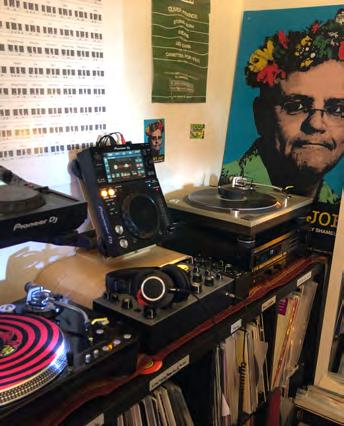
Ableton, my Mackie mixer, and Mixed in Key probably have the biggest influence on my sonic fingerprint. Ableton allows for performative recordings which is integral for me to move away from more cerebral ideas. My Mackie is a dusty crunch box and has made my drum sound what it is today. I am very proud of my drums these days and that sound is in part because of the sound that mixer brings. Mixed in Key is a more recent development in my sound but as I mentioned before, being able to recycle old material that I made instead of trawling through other sample libraries is allowing me to keep my music more personal. With that in mind, I have absolutely no issue with sample packs or apps like Splice and use them very frequently, but there is something to be said for rediscovering some weird sound you totally forgot you made!
I have always used Ableton as it has the power to be brought out for live sets. I haven’t really bothered with other DAW’s and wouldn’t say it’s any better or worse than the rest, I just know it inside out and that speed of use is more important to me than learning another program.
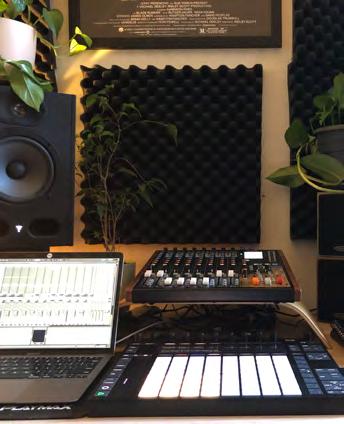
For monitoring, I’m running Focal Alpha 65s, Auratone 5C, beyerdynamic Custom Pros, and Apple Earbuds.
My Focals are maybe a bit too powerful for my room but they sound great. I use my Auratone as a reference speaker to which hyper fixates on the mid-range. I find my mixes sound better after I’ve switched to it which is the whole reason everyone harps on about them. My beyerdynamic headphones are handy for hearing any clashes in the low end (the low end is super hyped up) and then I use my cheap little Apple Earbuds for a lot of mixing since they’re surprisingly flat. I find in-ear monitoring easier to nail than speakers most of the time. If you think I’m talking garbage about headphone monitoring, just ask Andrew Schepp!
I work in bursts for mixing but if I’m onto a good idea creatively in the studio, I’ll often end up doing a marathon. Sometimes my brain is in overdrive and everything comes out quite dramatically. I have the luxury of being able to pursue that to its end, much to the demise of my hydration and blood sugar levels.
I generally start with drums and use this as the anchor point for the rest of the track. After that I will generally find some samples and start chopping them up and start laying down a chord structure for the melodies and bass to bounce off. Once I have a solid foundation of an idea, a B section, and enough elements to move between, I’ll throw it all onto an arrangement which is where everything starts to become more dynamic as I’m able to expand the simple loops I’ve made to make each part modulate and weave better with everything else.
The Fabfilter Pro Q gets the most use out of my plugins – bit of a boring one, but I use this on everything. A super high quality EQ that has a heap of great features like being able to see EQ clashes across multiple tracks, dynamic EQ
(kind of like multiband compression) and an easy-to-use interface. The higher processing modes also means you don’t get weird artefacts from notch EQs which can’t be said for the majority of EQ plugins out there.
I use a few compressors very often for specific uses. I use Ableton’s Glue Compressor or Native Instruments Solid Bus Comp religiously for drums on dance-oriented music. It’s simple to dial in and when you crank it, you get a tasty overdriven signal. For more drums that require more delicacy like in drum and bass, I tend to go for the UAD API 2500 as it has a nice snap which allows for more transients to pop through. For bus compression, I use the UAD SSL G-Bus which adds a little tone and does a great job of lifting less-prominent elements. It has a knob to roll off the bass which is super handy so your whole signal isn’t getting eaten up by those greedy low end frequencies.
Ableton’s Auto Filter is my go-to VST! It’s so underrated but has so much power to make your sounds more analog. The overdrive algorithms have emulations of the Korg MS20 and the classic Moog filter. I put it on nearly everything with a splash of overdrive to bake the sounds in better. There are a heap of possibilities once you start using the LFO and panning features. I love using this on percussion as you can link the LFO to the filter to constantly modulate the filter or pan easily on a track.
I’ve enjoyed using the Valhalla Reverb and delays in the past but I’m often using either the Hybrid Reverb in Ableton or the UAD Lexicon 224 for reverbs and either the Ableton Delay or UAD Galaxy Tape Echo. The Lexicon reverb is a really glorious digital reverb which I use sparingly but when it works, it delivers beautiful soundscapes. I like the Ableton Delay as it’s super simple, you can easily offset the left-right signal to create some nice stereo effects and its filter is easy to play with. I use the UAD Galaxy Tape Echo for more washed out and less precise soundscapes. Popping it on a vocal or synth buss lets the sound exist in a believable space.
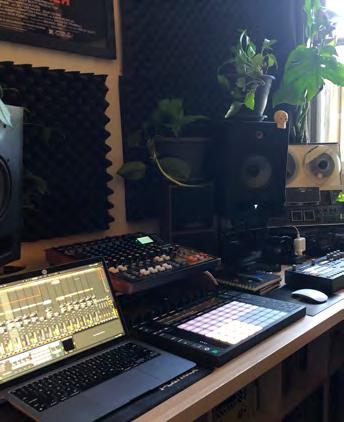
The simple old filter would do me if I could only use one type of effect for the rest of my life. You can carve out some really weird resonances and tones with the right one and it’s easily my used effect in my projects.
I’m DJing, supporting ATET in Naarm / Melbourne Dec 17, Beyond The Valley New Years Eve, and then playing a live set in Eora / Sydney at Civic Underground January 21. Apart from shows, I’m starting my new label, Point of You, which my next release is planned for in February ‘23. I’m heading to Europe in the middle of 2023 with a few shows locked in. I’m very excited for the next few months! :)
15 mixdownmag.com.au
Pedal Partners
The genre of shoegaze feels custom-built to attract a legion of gear obsessives, the kind of players who obsess over obscure pedals and processors and get lost in hour upon blissful hour of pitch-shifted, reverberated, fuzzified exploration.
Which is as good a way as any to describe Pedal Partners. Another good way is in the words of one part of the Pedal Partners duo, Luca.
“We’re very much into shoegaze, as you can probably tell if you have one glance at our YouTube channel,” Luca says.
The other half of that ‘We’ is Paige, who operates a creative collaboration with twin Rebecca under the name Abstract In Sound, while Luca has Violet Oscillation, a separate musical endeavour which also collaborates with Abstract In Sound.
“Abstract In Sound is my twin sister Rebecca and I and I was just really inspired by shoegaze music,” Paige says. “We actually moved to the Thames Valley in the UK where shoegaze was highly associated with in the beginning, so it just came naturally that we spent a couple of years really trying to perfect the sound and the way we wanted it to come across. And as soon as we felt like we got that together, we released our debut single, ‘In Abstract World’. And then just recently we released our newest single, ‘Your Gaze’, which we are very, very happy with.”
As for Luca’s Violet Oscillation, he found himself surrounded by shoegaze, goth, and post-punk music while attending university in Northampton, but also from simply cruising YouTube. “There
was a video on YouTube of the International Space Station and it was soundtracked by Slowdive’s ‘Souvlaki Space Station’. That was a big moment for me, discovering that… to be honest, I was in tears when I discovered that, it was so beautiful. So that’s how I discovered shoegaze, and then it was a matter of discovering the bands who were from where I’m from, which is Oxford in the UK, and Ride was from there, obviously Radiohead, who are not shoegaze but they’re the biggest bands from there. And they were all texture-based bands. Slowdive up the road as well.”
Pedal Partners, then, can be considered a sort of portal to Luca and Paige’s creative musings, together and separately under various guises and multiple media streams, and informed by their mutual love of the shoegaze genre. A big part of it is the Pedal Partners YouTube channel, which serves as a conduit not just for releasing Violet Oscillation and Abstract In Sound music, but also for all sorts of shoegaze-related content, be it gear reviews, documentaries on the genre, or just content that defies categorisation but fits within the general vibe of the shoegaze aesthetic. And like any good shoegaze artist, there’s a lot of talk about pedals. So much, in fact, that Pedal Partners collaborates with various pedal builders to make limited release, bespoke
stompboxes that tend to sell out pretty much instantly.
A recent collaboration with Robert Keeley is one such example, taking the form of the Realizer pedal, a spatial pedal based on the reverb side of Keeley’s Loomer pedal. There were a few production runs of that one, but now the time has come for the appropriately named Violet Oscillation pedal, developed together with Life Isn’t Fair from Cardiff, Wales.

“I think Life Isn’t Fair was the first person to ever send us a piece of gear to put on the channel when we first started it,” Luca says. “We’ve been meaning to do something with them for so long and it just came together perfectly. They’ve done such an awesome job. For five years now I’ve been perfecting how to get the best shoegaze tones out of a guitar and so I put everything I learned into one pedal because I needed the perfect tone for my debut single as Violet Oscillation, and that’s how this pedal came about.”
The pedal is inspired by a range of circuits – there’s a little bit of BOSS HM-2, a bit of Vox Tone Bender, a bit of Roger Mayer Octavia. “So it’s got a variety of stuff,” Luca says. “And then the oscillation part was obviously in the band name so we had to put some crazy oscillations in it. So that’s where things get crazy with the pedal: you turn on the oscillation switch and you can just manipulate the sound to do crazy things. There’s a bass and treble knob and they turn into controlling the pitch of the oscillations. You can get crazy synth-like sounds, glitch sounds, so much crazy stuff. I’m really looking forward to playing live
with it. We’ve got momentary foot switches, so it basically means if I just press the foot switch down for a moment and take it off, I can just do crazy stuff to the notes. Crazy improvised stuff is what we’re about.”
Guitar-wise, Paige and Luca are both fans of Fender Jazzmasters. Paige recently purchased a Fender American Vintage II Jazzmaster, a particularly old-school authentic take on this classic model, but is also known to sling an American Professional II Series Jazzmaster.
Luca is a fan of Kurt Cobain and is never far away from the Cobain signature Jazzmaster with DiMarzio humbucking pickups or a Fender Jag-stang. Paige often borrows the Cobain Jazzmaster too.
Next up for the Pedal Partners creative entity: live shows (Luca is looking forward to returning to the UK and activating an old band under the new Violet Oscillation name), some super secret new pedals, and talking up their new collaboration with Simon Scott of Slowdive, who mastered the Violet Oscillation single ‘A Nation Of Pilots’. “Slowdive is like our favourite band ever, so working with them has just been so, so cool and they’re such nice people as well,” Luca says. “I chased Rachel down the street in Oxford once to give her my band’s CD! She was so lovely. They’re all so nice and it’s great working with them.”
BY PETER HODGSON
16 mixdownmag.com.au

AKG:
Celebrating 75 Years of an Audio Icon
As one of the founding pioneers in critical transducer technology, the Austrian brand has built a reputation for excellence in the space that places them firmly on the Mt. Rushmore of microphone design, becoming both a gold standard across multiple product categories (large diaphragm condenser, small diaphragm condenser, and kick mic, just to name a few), as well as becoming a favourite among the broadcast and content creator communities for their highly touted and instantly recognisable range of headphones.
As the company celebrates its mammoth 75th anniversary, we’re taking a retrospective look into some of AKG’s most famed pieces – the groundbreaking innovations and the important moments that shaped the AKG story and ensured the brand’s ongoing reputation as a bonafide icon of the studio.
Like many long-standing audio companies, AKG came from humble but cerebral beginnings.
Founded in Vienna, Austria in 1947 by two friends, physicist Rudolf Görike and engineer Ernst Pless, the original AKG factory had just five workers manufacturing the first product line to put AKG on the map – the legendary DYN Series of dynamic microphones. Adopting a revolutionary moving coil technology that made use of Görike’s unique understanding of mass load membranes, this select series of microphones featured a breakthrough extended frequency range, offering a level of fidelity that was basically unheard of in
dynamic mics at the time. These were quickly picked up by radio stations, theatres, and jazz clubs all through Europe. By the end of the ‘40s, AKG had become one of the premier microphone companies in the world, a sentiment echoed with the release of the brand’s first headphones in 1949.
Some genuinely revolutionary products were introduced by AKG in the 1950s which included the D12 – the world’s first cardioid patterned dynamic microphone and still a preferred favourite for kick drum in studios around the world. Other classics of the era include the D36 – a dual cardioid capsule dynamic mic capable of multiple polar patterns including cardioid, omni, and figure-eight. But perhaps most famously, it also marked the release of the coveted C12 – the world’s first remotecontrolled multi-pattern capacitor microphone and perhaps AKG’s most iconic mic. As expected, all three of these microphones are incredibly revered in their particular application, but even among such illustrious company, the C12 stands out as an icon, both for AKG and for recording history in general.
Throughout their history, the engineers at AKG have always shown a knack for innovation. The early D series microphones were superbly crafted for low end response, with their “bass response” chamber built into their head assembly; unique to this series of microphone. These dynamics set the standard of low frequency capture and were
extensively used by esteemed engineers, helping shape the sounds of The Beatles, Led Zeppelin, and The Rolling Stones to name but a few. The D12 and the other notable D series mics of the time went on to inspire the now industry standard D112. Say no more.
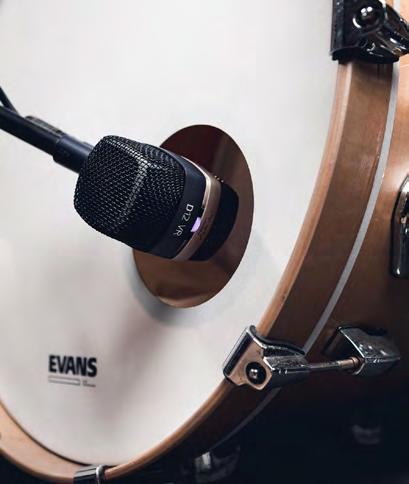
As for the condenser side of things, the C12 brought an open and nuanced character, which up until its release was simply unheard of. With its incredibly flat response, the C12 was able to capture such detail and air of a sound source – it quickly found itself becoming the go-to vocal microphone for many engineers and producers, a mantle it still holds to this day.
The now legendary CK12 capsule was at the heart of the C12, offering constant frequency response and sensitivity across all of its nine polar patterns. This was due to the CK12’s unique dualbackplate design.
The mystique of the CK12 was then passed down through numerous other C series microphones including the ultra rare C24 (a stereo version of the C12) C12A, C12B, and then onto the transistor-based mics such as the C412 and precursor versions of the famed C414.
From the early days of the C12 in the 1950s through to the C414s of the 1970s and ‘80s, these AKG condensers famously captured some of the world’s most iconic singers – from Frank Sinatra to Elvis Presley and most notably the cast of celebrity singers for the ‘We Are The World’ recording in 1985.
As the nature of multitrack recording continued to evolve, so to did the demand for interesting new sonic flavours, and from this, the now legendary C414 came to the fore as one AKG’s most
distinguished (and best selling) mics, going through numerous design changes over its lifespan and becoming one on the most recorded microphones in music history.
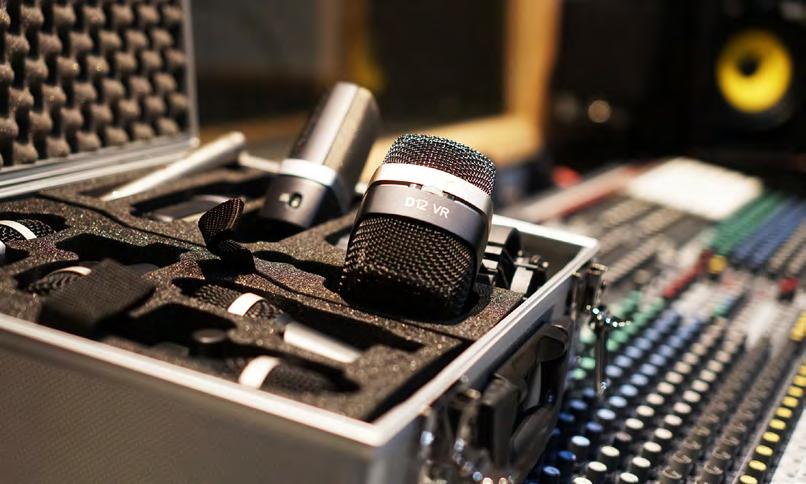
While AKG had continued to make a name for themselves in the world of microphones, concurrently, they were also revolutionising the headphone game, with their first headphone – the K140 DYN being released in 1949. Ten years later, AKG introduced the world’s first over ear open-back headphone –the K50 model.
Suffice to say, the open back and semi-open back headphones are an important part of the AKG story, with the K240 still being so ubiquitous across recording studios and broadcast facilities across the globe. The iconic ‘lightbulb’ headband found on many of AKG’s open-backed offerings has made them an instantly recognisable sight in live broadcasts and in radio stations worldwide, the preferred choice for many of the world’s on-air talent.
Today, models range from the entry level K52s right through to the master reference headphones – the K872.
With such a rich history of products, AKG is showing no signs of slowing down. Still catering to the upper echelons of the microphone and headphone markets, but with an expanded scope that covers both content creation and live performance, it will be fascinating to see what the next 75 years will bring from this icon of the recording space.
BY ANDY LLOYD-RUSSELL
18 mixdownmag.com.au
Few audio brands could boast the kind of seismic legacy that AKG have built over their 75 years as both an audio manufacturer and as creators of some of the most iconic and influential studio and broadcast peripherals ever released.
Tone Shaping with Maestro Electronics
The first run of Maestro range of pedals landed in 2021 and are here to stay. Modelled after the sounds of the golden years, the initial release of pedals featured the Ranger Overdrive, Invader Distortion, Discoverer Delay, Comer Chorus, and the highly revered Fuzz-Tone FZ-M.
2022 sees the release of a new range of sounds from Maestro, building on an already stellar line up, and managing to cover new ground in their effects while retaining the pedalboard friendly, true bypass design of the initial release. The new range has modulation covered with the Orbit Phaser and Agena Envelope Filter, before moving into volume and drive territory with the Mariner Tremolo, Arcas Compressor Sustainer, and Titan Boost.
While the initial run feels like effects and sounds for ear candy, the newest releases are a line of stalwart pedals, ‘always on’ style effects that can reinterpret your tone in their own words.
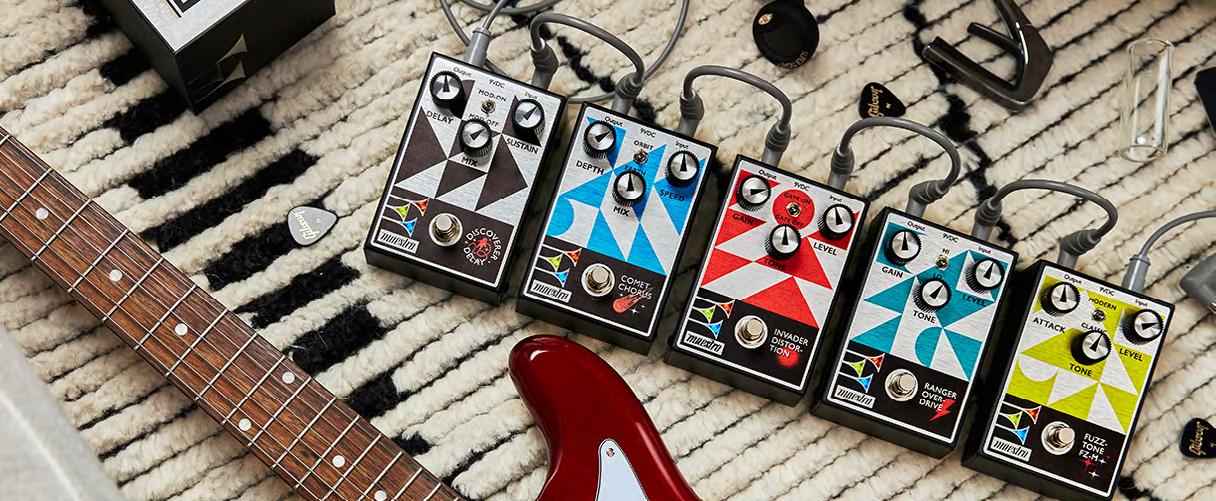
TITAN BOOST
The Titan Boost is a super simple design with Maestro’s now iconic groovy artwork scattered across its otherwise brushed metal enclosure. Coloured with lime green, the Titan Boost is a threeknob boost pedal powered by 9V and featuring a single input and output. There’s a level control for gain, as well as a tone knob that subtly rolls off high end while making the mids and lows more
present while that happens for added warmth. What makes the Titan unique is the high pass filter, which is engaged by switching the HPF/flat toggle on and off. Flat leaves your tone unaffected and acts as a super transparent boost, while the HPF mode allows for the nice low-end roll off that can help a solo cut through while also being boosted.
ARCAS COMPRESSOR SUSTAINER
If you’re beginning to think about shaping your tone to cut through while remaining balanced, a compressor is hard to go by. The Arcas Compressor Sustainer is Maestro’s take on a popular guitar effect, used to both tighten your tone and emphasise your feel and articulation. The Arcas is a pedal simple enough to use, with the sustain knob controlling how much compression is applied – like a combo input/threshold control. The attack controls how fast the compressor kicks in once that threshold is met, and the level adjusts the gain once the compressor is doing its thing. The hi/lo toggle in the middle of the pedal is to set up the pedal for both high output and low output pickups like single coils, actives or humbuckers.
MARINER TREMOLO
Sitting pretty in the middle of the new range of Maestro is the Mariner Tremolo, a bit of a combo gain and modulation
beast. Featuring classic controls like depth and speed, the Mariner also features a shape control to adjust how extreme the effect on the volume is, and a harmonic/ classic toggle to switch between a modulating, dual-tremolo mode in harmonic mode, and a more classic, subtle tremolo in, uh – classic!
AGENA ENVELOPE FILTER
Moving right ahead to one of the more extreme sounds in the range, the Agena is an envelope filter that can move from super modest modulation to full blown warbling rage. The sense knob controls sensitivity, and acts a bit like a mix knob by adjusting how much of your dry signal is fed into the effect before being modulated. Attack and decay act as a way to adjust how fast the filtering effect begins once you hit a note, and then how much it hangs over your playing once the signal has hit threshold. Again, the hi/lo toggles between input types to adjust optimal gain for different pickups.
ORBIT PHASER
Rounding out the new range from Maestro is the Orbit Phaser, a seemingly simple phaser with familiar width, rate, and feedback controls. Where the Orbit deviates though, is in the 4-stage and 6-stage toggle, switching between varying amounts of phase stages for progressively in-your-face phase sounds. For those playing at home, 4-stage phasers are some of the most common and will handle most of your stock standard phaser needs. The 6-stage mode is where you get creative.
And there it is, five new sounds from the recently revived company who may very well have started us all on this pedal chasing journey. Maestro’s fresh range of pedals bring more niche and unique sounds to our boards, and only serve to complement their existing offerings, with both extreme settings and ‘always on’ style sounds available within each pedal. They’re simple, accessible, professional quality, and they look the part. Count us in, Maestro.
BY LEWIS NOKE EDWARDS
19 mixdownmag.com.au
Designed to cover all bases, the Maestro range whips your sound into a frenzy, all with the grit, bite, and mojo of the ‘50s and ‘60s sound that we’re all chasing whether we realise it or not!
In Focus: Arturia’s Desktop Solutions
panel let you keep track of all the action, while a USB hub on the back even lets you hook up a MIDI controller or other device.
effects,
In a world where creators are required to uproot their setup at a moment’s notice to attend a session, it’s crucial for musicians to ensure their studios are as portable as possible.
For maestros of small and mighty, it’s hard to go past the catalogue offered by Arturia. Formed at the turn of the millennium with a mission to create software synths that went the distance, the French company has since asserted itself as one of the biggest names in musical manufacturing thanks to wildly popular products like the KeyStep, MiniBrute, and the omnipresent V Suite of plugins.
A must-have for any portable studio is a malleable MIDI controller, and for this, Arturia’s MiniLab 3 is a surefire solution. It’s tactile, stylish, and incredibly practical, with this latest iteration boasting just the right amount of features to let your creativity shine.
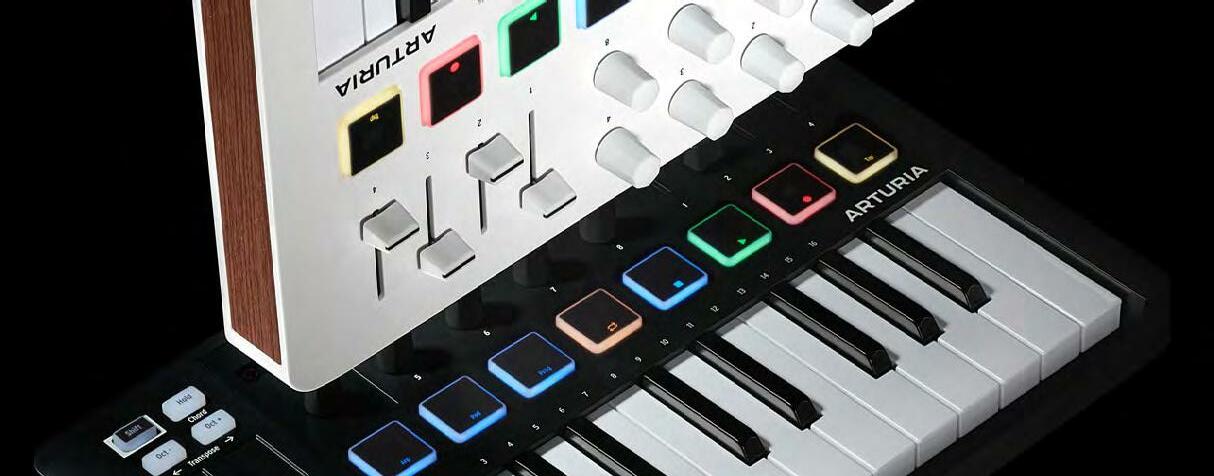
While the MiniLab 3 doesn’t stray too far from the blueprint of its predecessors, there’s a few noteworthy new features. Firstly, there’s the addition of a mini display that visualises parameter changes and helps you navigate sound banks from the confines of the controller, meaning you don’t even need to look up from the keyboard to browse for that perfect snare.
This new unit also features four assignable faders, which work in tandem with eight rotary encoders to allow users to customise various parameters such as filters and envelopes. Previous models only made use of rotary encoders, so the addition of such a malleable feature as a slider is a nice touch.
There’s also the inclusion of an inbuilt arpeggiator as well as a full-sized MIDI out port, meaning you can hook up any other piece of gear and use the MiniLab 3 as a master controller – perfect for compact onstage setups.
Aside from these new features, the MiniLab 3 offers everything that made previous models great, with 25 velocity-sensitive mini keys, eight trigger pads, touch strips for tweaking pitch and modulation, and those sweet faux wooden sides.
Of course, there’s also a massive software suite bundled in to get you started, and if that’s not enough, it’s also made from a minimum of 50 per cent recycled plastics.
Need a solid, lightweight sound card that you can easily bring to sessions? Arturia’s MiniFuse 2 is screaming your name. This 2i/2o, 192kHz USB-powered interface delivers in spades, packing in all the essentials into an incredibly compact package while also offering some powerful software add-ons to boot.
Two combination TRS/XLR jacks on the front panel allow you to plug a microphone or keyboard straight in to record, while each channel also offers a hi-Z switch to suit for DI guitar and bass recordings.
Phantom power ensures the MiniFuse 2 can handle condenser mics for crisp vocal recordings, while the addition of MIDI I/O on the rear makes it all the more versatile.
Elsewhere, backlit controls and LED level monitoring on the front
As with most Arturia products, the MiniFuse 2 is also packaged with a mighty software suite, with the MiniFuse Control Centre offering excellent plugins and allowing extensive control over the unit.
If portability is front of mind but you tend to operate in the hardware domain, you’d be bereft in your duty to not check out the MiniFreak.
A revised take on Arturia’s MicroFreak – perhaps one of the most inspired synths of the 2010s – it’s a forward-thinking, multi-mode digital device that’s abundant in whacky features to broaden your sonic horizons. Eschewing the controversial touchstrips of the Micro for a 37-key velocity sensitive keybed, the MiniFreak offers six voices of polyphony, plus three analogue filter types, envelopes, LFO, and a vast array of modulation possibilities.
It’s powered by two different engines that offer 22 different algorithms, including opensource oscillators that take cues from modular legends Mutable Instruments, letting you traverse virtual analogue, freaky FM, formant waveshaping, and just about everything in between. Such a wide sonic palate allows seasoned synthesists to program mutant sounds of every kind: from pianos and soaring strings pads through to metallic chimes and bizarre contorted howls, there’s nothing this beast can’t handle. There’s a stack of useful and unique presets to get you started on your journey, while inbuilt
The side touch strips to tweak modulation and other parameters are nifty, and the depth of the modulation matrix ensures that you’ll never get bored of programming the MiniFreak.
From audio interfaces to MIDI controllers and beyond, no manufacturer does small and mighty better than Arturia. The MiniFuse 2 is a no-fuss solution to all your soundcard needs, while the MiniLab 3 is about as comprehensive as a compact MIDI controller gets in this day in age.
On the other hand, the MiniFreak is a portable behemoth of a synth that could easily serve as the centrepiece of any cunning producer’s setup. They might be mini in name and stature, but there’s nothing else that’s little about these offerings from Arturia.
BY WILL BREWSTER
20 mixdownmag.com.au
LFO shapers, and a cycling envelope help you add further spice to your patches along the way.
If there’s one thing that all gear heads can agree on, it’s that size absolutely matters.
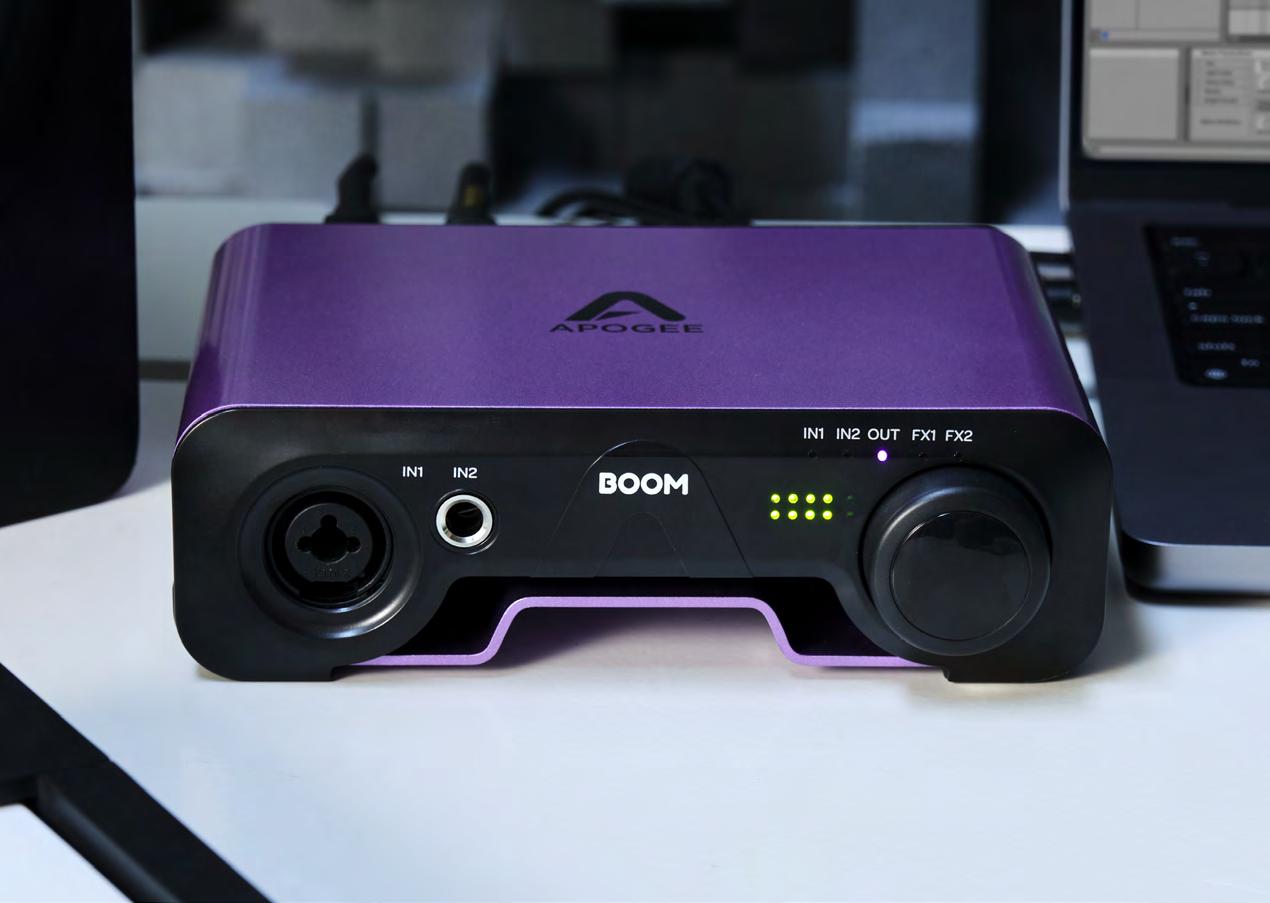


High-end audio now affordable and portable. Start Sounding Pro Introducing Apogee’s newest entry-level interface, BOOM, with pro-level performance. A 2x2 USB-C audio interface with hardware DSP tuned by Clearmountain. Includes Ableton Live Lite, Soft Limit Plugin, and more. linkaudio.com.au | P: +61 3 8373 4817
Riedel Communications: Leading the way in Live Broadcast
The seamless cuts and transitions, the dizzying number of audio feeds being mixed in real time, the crowd noise, the commentators, the onscreen graphics, the ad breaks, the clarity of transmission, the unpredictability of live broadcast in general – it’s a lot to handle.
The vast array of protocols required to work faultlessly for an efficient production can be gargantuan, often requiring hundreds if not thousands of I/O counts, not to mention adequate redundancy within the system.

Like any sporting team, these large scale productions require extensive communication in order to succeed and this is precisely where Riedel systems come into the fold.
As the backbone of some of the biggest events on the planet, including the Formula 1, the Super Bowl, and the America’s Cup to name but a few, Riedel’s real-time networking and communication solutions are the pro choice for these kind of large scale productions, providing seamless and faultless communication for some of the most complex and sophisticated productions on the planet.
One of Riedel’s product lines, the Artist has become the de facto system of choice for the increasingly sophisticated nature of live broadcasts, allowing for multiple feeds and remote communication with a remarkable amount of flexibility.
Jordan Hanna – Riedel Communications Systems
Consultant explains: “The Artist ecosystem of products allows a user to talk and listen on a number of different mediums; for example, a SmartPanel, Bolero wireless beltpack, a 2-way radio or even an old school telephone around the other side of the world!”
These kinds of communications solutions aren’t just reserved for large scale broadcast as well, with Reidel finding a home among Australia’s many theatres and live performance spaces also.
Michael Wade, AV Manager of Queensland Performing Arts Centre (QPAC), recently installed a Riedel system across numerous venues and spaces within QPAC. Suffice to say he was adequately impressed with Riedel’s Micron UHD hardware and MediorNet’s capabilities, particularly when compared to their old system.
“We set up a broadcast facility which is located very close to our concert hall. But we would have to go to another venue that was hundreds of metres away and it was very difficult to get signal to and from there without having to uproot everything and moving it up there. It was very inefficient. So we’re deploying one Micron UHD per venue and the broadcast suite. So the Micron UHDs are taking care of two jobs. They do all the local routing, including conductor view at super low latency, and the broadcast patching. We can control cameras, run DANTE, plus
video signals, plus synchronisation, and we’re converting our analogue 2-wire partyline comms to 4-wire and running them through an AES67 box to the broadcast suite. It’s an awesome setup.”
Having a product such as Riedel’s MediorNet available in today’s demanding media environments not only provides the convenience of signal transport and processing over optical fibre (ideal when integrating into an already existing optical fibre infrastructure), but as it also takes care of signal routing, it’s an industry game changer. This incredibly efficient system was a no-brainer for QPAC, as Michael explains: “When we used to do this (a multiple venue setup and deployment) we would have to do two days of prep. To patch analogue audio through the entire centre, include 15 points of failure, and then there might be some patching that is the wrong way around or something. So all of that communication and labour cost is pretty much now at the press of a button on a computer, it’s amazing.”
With the Riedel system installed, Michael explains what a typical QPAC setup scenario looks like for them now. “Basically we go to MediorNet, select the I/O, we’ve got a comms panel setup so we simply choose whichever venue we’re communicating with. The (Riedel) frames also deliver sync, we can also send return vision (from the broadcast suite) back to that venue if required, or a program feed to the foyer monitors. So rather than the front of house view from a balcony circle front you see the actual broadcast mix. The moment we have those cameras selected and
plugged in, they all just appear in our broadcast suite.”
Not only does the system provide enormous flexibility in operations and routing within the centre itself, but for sending broadcasts out. “Pretty much all of our broadcasts are going out via Ethernet, streaming it out to Vimeo at the moment. We’re often doing regional streaming these days, so we can send audio and vision to regional venues in Queensland.”
Having implemented this new AV system across QPAC, it promises an exciting future for the Arts Centre. “It gives us a lot more agility to do multi venue broadcasts, so more output is the biggest advantage of this system. Being able to just move cameras around and plug and play; so we may be able to do something in the concert hall one day and a different venue the next day because of the ease of this system. So the broadcast and content creation side of things have been taking off the last couple of months.”
BY ANDY LLOYD-RUSSELL
22 mixdownmag.com.au
Given Australia’s endless appetite for televised sport of any kind, it’s sometimes easy to overlook the sheer logistics involved in delivering these kinds of large scale broadcasts to the viewing public.
Warm Audio: Studio-worthy Stompboxes
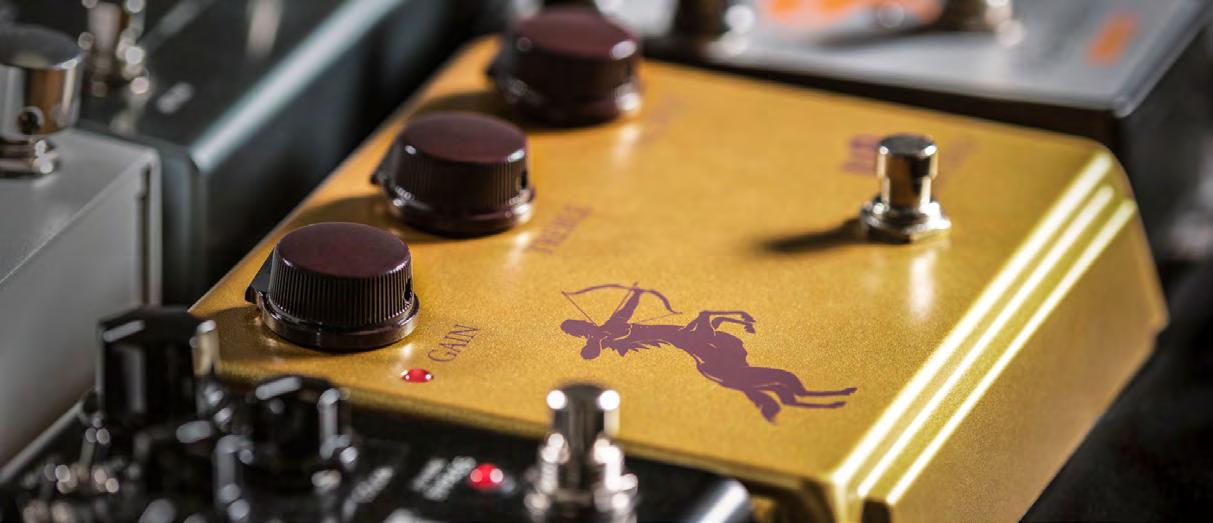
Many people reading this will be more than familiar with Warm Audio.
Their accessible, functional, and affordable studio gear features on more records than we probably know about, from budding bedroom producers to top-tier and tech-savvy engineers working on big budget records. They’ve taken some of the most famous equipment in history and replicated it with shocking accuracy – the shocking part being the price tag when compared to the real deal.
While Warm Audio has risen in popularity thanks to their own Tone Beast preamps, their 1176 and LA-2A-style compressors, as well as Neve and API-style preamp clones, they’ve now turned their attention to pedals, again to pay homage to some of the most famous bits of kit while also putting their own spin on them, making products for the modern musician.
The Centavo takes its cues from arguably the most famous guitar pedal of all time. Made famous by its epoxy-covered circuitry, limited availability, but ultimately fantastically usable and greatsounding effect, the Centavo is Warm Audio’s Professional Overdrive Pedal in an enclosure that’ll have most audience members doing a double take when you’re stomping it on a stage. The Centavo is a transparent overdrive, controlled with gain, treble, and output dials.
Designed to augment a greatsounding amp and guitar combo, the Centavo provides clean gain that reminds us of an amp on the
edge of breakup, before falling into full on overdrive. The gain is loud and rich, while the output is clean to clip your signal as it hits another pedal or your amp. The tone control in the middle is a high roll off, albeit with a mild push and pull of the bottom end as you roll it on and off, allowing you to shape your tone with a single knob. The mod switch on the top of the pedal allows for a low-end boost that’s clear and concise, without feeling blown out or fuzzy. The Centavo is powered by 9V, allowing for either battery or an adapter, and you connect via the ¼” input and output on the top of the pedal. Warm markets this pedal as “unapologetically vintage”, but don’t let this limit you. The Centavo can improve any and every signal it’s a part of.
If it’s overdrive more specifically that you’re after, the Warmdrive might be the option. Tones like this are legendary, and used by some of the best in the game.
The Warmdrive is an overdrive pedal with volume, gain, tone, and voice controls, with the voice control shaping tone before the clipping stage, while the tone control shapes it afterwards for total drive control. Fluctuating between modern sounds with articulate pick attack and fat, vintage tones is simple, both ends of the spectrum being freely available within the Warmdrive, and everything in between being just a few adjustments away.
The Warmdrive is a bit more pedalboard friendly than the Centavo, however because of how great they both sound, you’ll surely be binning a bunch of other pedals anyway, right?
If you’re not ready to bin the rest
of your sounds – Warm has a few more tricks up their sleeve. The Jet Phaser is another vintagestyled pedal, both sonically and aesthetically, the two switches controlling on/off of the effect, and the second toggling between fast and slow phaser modes. The Jet Phaser has simple controls to help you access a famous “jet” phase circuit, with a few different modes available and level, rate, and resonance controls to shape it.
For more extreme sounding gain, the Foxy Tone Box, and with a little research you’ll know to whom and what Warm are tipping their hats to. The Foxy Tone Box is 100 per cent analog, has a fully discrete signal path and NOS 2N3565 Fairchild transistors that were found in the original circuit designs. The Foxy Tone Box is easy to control, with volume, sustain, and fuzz controls making you fuzz aficionados feel right at home. It also has a stomp switch and a quick octave up switch for that super satisfying lead tone.
Warm’s range of pedals leaves many others in their wake. They’ve made their name in pro audio, concocting both their own designs and making increasingly affordable clones of some super famous pieces. This is no different in their range of pedals, taking equipment that’s shaped and moulded some of the most iconic tones, used by some of the most legendary musicians in history, all bundled up into affordable boxes that look the part among their vintage counterparts.
Aesthetics and vintage accuracy aside, the Warm pedals sound great, offering a wide pallet, even among pretty specific sounds and intentions. The Centavo and
Wamrdrive help you achieve really inspiring tones, giving you the feelings you felt when you first heard great guitar tones, whether you knew what gear was being used or not. They help you shape and colour your sound, while making sure you’ve got the control you need over the parameters you need most.
Warm Audio is clearly making products for the player and makers, for those of us looking for great sounds that won’t break the bank. While vintage gear is great and all, Warm is placing these sounds into the hands of the workers who’ll be using this stuff day in, day out, gig after gig, without fear of ruining or wearing out an old, fragile, unpredictable, or unreliable piece of gear.
BY LEWIS NOKE EDWARDS
23 mixdownmag.com.au
Why Power Conditioning is a Must Have for Music Studios

Unless you are actively involved in the playing of (and not the recording of) pre-war blues, acoustic folk, or unamplified chamber music, chances are that you are probably incorporating electricity into your music making process, in some way, shape or form.
Whether you are completely cognisant of it or not, in this day and age, it’s practically unavoidable.
But what happens when the cart develops quicker than the horse? When the technical capabilities and sonic quality of our electric instruments, powerful recording/ playback devices and digital signal processors distinctly follow Moore’s law of technological advancement, while the electrical source we continue to draw from is still roughly the same as it was 100 years ago?
Jeff Mackenzie, engineering and training manager for Jands (Australia’s home to leading power conditioner brand Furman) explains.
“When the grid system was first established, electricity was still in its infancy. It was designed for simple domestic use. Heating kettles and lighting houses— applications that were much more tolerable to random fluctuations and swings in nominal voltage,” he says.
“Never could they have imagined we would be using grid power the way we are today in the studio and live audio industries. Now we are in a situation where the power supply we have is archaic and suboptimal to our needs.”
Mackenzie is not being precious either. Take one look around and the telltale symptoms of dirty power are all around us: in the whistling of a guitar amp, the buzzing of a playback monitor,
the clicks and pops on a digital recording or in the worst case scenario, in an unexplained fire or blown piece of gear.
Suffice to say, the recent boom in consumer and prosumer recording has been anything but smooth sailing down here in Australia, a perfect storm typified by cheap aftermarket power supplies, equipment originally intended for overseas markets and some uncharacteristically loose governance of the local power grid, allowing for a surprising amount of leeway between nominal (average) and maximum voltage (and with very little parity from state to state).
“This inconsistency is at the heart of many of the issues that we as the audio community face here in Australia,” Mackenzie explains.
“For normal use, it’s fine, but for someone operating a PA or sensitive recording console, the difference between 220V in Sydney and 250V in certain parts of Western Australia can be devastating.”
This is at the heart of why power conditioning devices (like Furman’s Classic Series-Export or AC-201AE) make so much sense in this part of the world. We have a particularly unique power situation that needs regulation, be it through legislation or through rack gear.
Furman’s high quality offerings incorporate features like MultiStage Protection (SMP), Linear Filtering Technology (LiFT), and
Extreme Voltage Shutdown (EVS), features that are perfectly in line with our particular predicament, here down under.
“On the one hand, power conditioners serve as a buffer that ensures your power source is brought back to nominal, filtering out nasties and ensuring the consistent and predictable operation of critical audio equipment,” Mackenzie explains.
“The other side of the coin is protection for yourself and your gear, against a whole host of potential power hazards— everything from a lightning strike to a random 3000V spike in the network. Furman units are a great insurance policy in that regard.” Hearing Jeff put it in such simple terms is something of a revelation to someone like me who has always eschewed the sparkier elements of audio theory. The longer we talk the more it becomes apparent that it’s not only pro audio boffins, commercial integrators and studio types who can reap the benefits and peace of mind that comes from good, clean power. These days, we are seeing more and more guitarists turning to power conditioners to cure their tonal woes or protect their precious touring rigs.
“Guitarists are particularly vulnerable to dirty power as they are constantly adding gain devices and additional power supplies into the equation,” Mackenzie elaborates.
“This in turn brings up the noise floor through every pedal or amplification stage. Before you know it, you’ve compromised the lion’s share of your tone, not to mention boosted any other artefacts that might be present in the signal.
“By regulating the nominal voltage of the grid power in whatever city you are playing, power conditioners can filter out these nasty artefacts before they leave their imprint on your sound, not to mention protect your equipment from whatever power they happen to be running in that part of the world.”
As we continue our conversation, I find myself asking a lot of big questions. Technical audio questions, internalised questions about infrastructure and geography and circumstance and the influence this kind of banal utilitarian stuff can have on artistic process and workflow.
As someone who has spent an inordinate amount of time trying to locate buzzes and interference within the recording chain, as well as having fallen victim to mild electrocution on multiple occasions, this conversation has definitely struck more of a chord in me than I first anticipated.
I ask Jeff if he can think of any hotspots for dirty power here in Australia, any areas that could really benefit from power conditioning. His response is enough to make me want to cry in frustration.
“I think of places like Brunswick in Melbourne or Ultimo in Sydney –places that were historically heavy industrial areas, but ended up being home to a heap of recording studios, multimedia spaces and music venues. I hate to think how much time might have been spent troubleshooting every link in the recording chain, when it was the mains all along.”
Touché, Jeff.
BY PAUL FRENCH
24 mixdownmag.com.au
New Era For Turramurra Music After Extensive Renovations
& KH150, Barefoot Footprint 01, PS1 A21, Yamaha HS8, Avantone Mixcube, and KRK V8 S4.
The business, which started in 1976 by Rob Stevens as a small shop in Sydney’s North Shore selling records and equipment. A 21-year-old touring musician, he had minimal business knowledge and even less money. But what he had was a lot of passion for music, and instinct for what musicians and music fans – experienced and newcomers –wanted.
Turramurra Music then focused on guitars, synthesisers, keyboards, drums, bass, recording software, and pro accessories – and gradually expanded to the two stores next door.
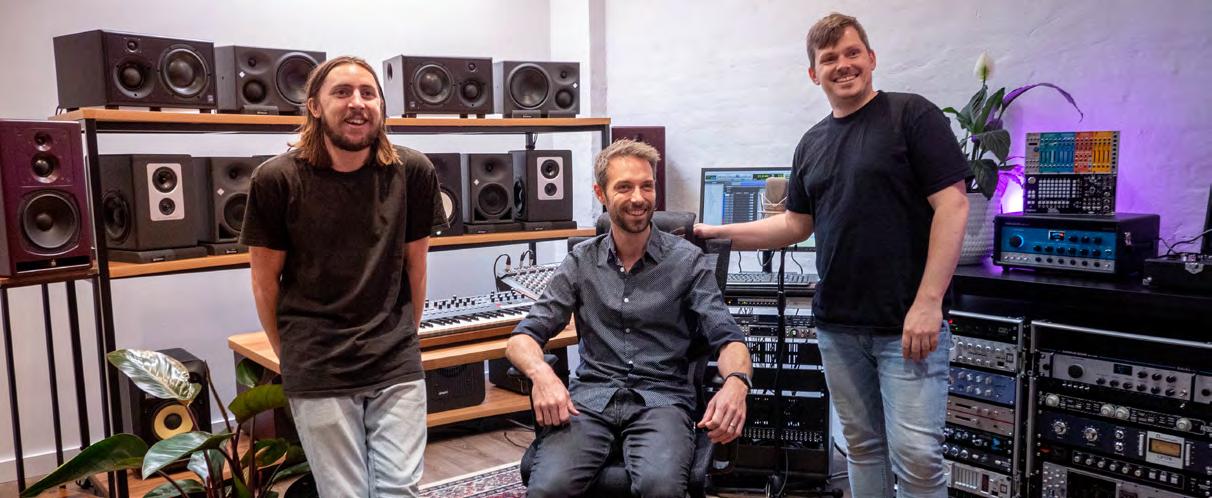
“We had the vision for the renovations about 10 years ago,” says managing director Mat Stevens, Rob’s son, and also a musician.
“The renovations started about five years ago. It was getting close to being ready when COVID hit which created problems with getting building materials, stock and (construction) workers. We’re so excited that it’s finally over.”
The amalgamation of the three stores gives a space of 871.46m², which means space for four times as much stock. For instance, there are 700 guitars with 327 guitars on the floor to try out, and 800 guitar pedals with 450 unique pedals.
The revamps were driven by key staff in different product divisions –like what gear they would have on display and how they would wire it up. Feedback from customers included: “Wouldn’t it be great to have a ton of mics to test, or be able to switch between speakers in real time to compare.”
The financial and emotional investment in the expansion goes back to what drove the business when it started 46 years ago.
“Our core vision is to give our customers the very best instore appearance in Australia,” Mat emphasises. “People are obviously shopping online these days and we sell a lot of stuff online ourselves, we put a lot of investment in our website and online sales team.
“But with music gear it’s more special to come into a store, be able to try out the gear, look and compare, have a chat face-toface with an expert, and work out what’s the best for them to get.
“For example, with mics, everyone has a different voice. Every guitar feels different and responds differently to someone’s playing, and it’s hard to buy one based on an online review.
“The whole renovation was done to give customers a reason to drive all across Sydney to visit our store, and make sure they have such a great experience that they can’t wait to come back.
“Or they’ll tell their friends, ‘If you want to get a guitar or a keyboard or microphone, you have to go to Turramurra Music because it’s a fantastic place and it’s worth the drive.”
A key piece of the puzzle is the Studio Room, a dedicated space away from the sales area, and set up to look like a recording studio. But where a studio would have barely a handful of monitors, the Studio Room has a wall of them – ATC SCM25, Neumann KH310
For signal processing, there are 2x Avalon 737, Neumann V402, Peach Audio M196, API The Channel Strip, Warm Audio WA73 EQ, Emperical Labs Fatso Jr, Lindell LIN76, Warm Audio Bus Compressor, and Echofix EF-X3R and EF-X2
The microphone collection includes Neumann, beyerdynamic, Universal Audio, RØDE, Soyuz, Austrian Audio, Shure, Warm Audio, and Sennheiser.
“I don’t think there’s any other place in Australia where you can try out this amount of the gear we’ve put in that room,” Mat suggests.
“Customers can try these out with an expert to guide them through with the set up and everything. It’s a unique experience you can’t get anywhere else.”
The new expanded space means more in-store events for product launches and masterclasses.
Turramurra Music hosted the launch of the Moog Mavis on its global day, with a demonstration from a Moog representative on a product no one had seen in Australia.
The store most recently hosted a showcase for the DiGiCo Quantum 225 mixing console, following it up with one for the Midas Heritage-D HD96 on Wednesday November 30.
With the chance to test these hands-on and with extra tech info from brand reps and Turramurra Music staff, customers can work out how suitable these are for themselves
has a strict policy.
“They have to be musicians, of course. But they must just as much be friendly, reliable, and grow relationships with people who walk in through the doors.
“The wider industry has this caricature of guitar stores with an intimidating sneering scruff on the front counter, and we’re trying to blow that stereotype away. Yes it’s important to know your product, to be able to tell a customer, ‘I use one of these myself’ rather than quote from the brand’s website.
“It’s always been about giving customers the greatest experience and providing the best support. If we look after people so well from the first time we meet, they’ll always want to keep coming back.
“It’s never about being pushy and selling things to customers, it’s about looking after them really well, and at some time if they want to buy something, then that’s cool.”
Long time customers have been The Angels (who played at Turramurra Music’s 30th birthday party), INXS, Midnight Oil, The Wiggles, Gordi, and Flume.
“Some customers from the ‘70s are still coming back, some with their kids and grandkids. We know them personally and they’re regarded as extensions of our broader family.”
Turramurra Music is located at 1267 Pacific Highway in Turramurra.
Phone: (02) 9449 8487 Website: www.turramusic.com.au
BY CHRISTIE ELIEZER
25 mixdownmag.com.au
Many Turramurra Music staff are key experts in their fields as producers, mixers, and players. But Mat
It’s a new era for Turramurra Music, after extensive renovations have finally been completed.
Squier 40th Anniversary Strat, Vintage

DISTRIBUTED
Edition
 BY: FENDER MUSIC
BY: FENDER MUSIC
AUSTRALIA | PRICE: $999
RECOMMENDED FOR: Players outgrowing their first electric guitar or more advanced players looking for a quality, affordable Strat.
FEATURES: Everyone loves a Strat. Even if you don’t own one, you’ve surely got into records that a Strat has featured on. Fender Strats were made more affordable when Squier began producing them in the ‘80s, and this 40th Anniversary Stratocaster pays homage to them by putting guitars in the hands of more players.
The Vintage Edition Squier 40th Anniversary Stratocaster features a satin finish over the nyatoh body and tinted maple neck. The hardware has an aged chrome finish, and what helps these Strats stand out is the anodised aluminium pickguard adding both a visual and sonic value. The Vintage Edition Squier 40th Anniversary Stratocaster is available in a few colours, all with the classic triple single-coil set-up of a classic Strat.
OVERALL: These Strats are great for players of any level, and their price point makes them available to more people than ever. The quality for the price is impossible to beat, Squier offering everything from super basic beginner guitars right up to Strats like this, a professionally spec’d guitar for any and everyone. They play great, do that Strat sound, and won’t hurt your bottom line.
Squier moved to pay tribute to their beginnings with the whole range of 40th Anniversary guitars, the Strat just being one of them. For the price and quality - why not?
Strymon Flint 2 Tremolo and Reverb Pedal
DISTRIBUTED BY: AMBER TECHNOLOGY | RRP: $719
RECOMMENDED FOR: FX wizards, surf dads, shoegazers
FEATURES: SInce first arriving on the scene in the early ‘60s on many of the iconic amp circuits of the era, the foundational effect of tremolo and reverb have always shared a uniquely symbiotic relationship, full of interplay and harmonious co-existence. The new Flint 2 from Strymon takes this natural kinship and explores it to its full potential.
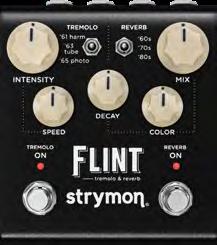
On the tremolo side, we have a plethora of classic sounds, from the sonically rich ’61 Harmonic Tremolo, the swampy and sultry ’63 Power Tube Tremolo, and the sharp and balanced ’65 Photocell Tremolo. On the reverb side of the coin, we have emulations of everything from ’60s Spring Tank Reverb, to inventive ’70s Electronic Plate Reverb, right through to the nostalgic ’80s Hall Rack ‘verbs and more, all the classics are there and they all sound sublime.
With nine parameters to tweak, you get extensive control over the tremolo and reverb characteristics. The ability to hone in everything from relatively subtle, dry pulses to all out sonic freakery gives this pedal plenty of tonal scope to keep you busy for all of next year and beyond.
OVERALL: The ability to mix and match between classic tremolo and reverb sounds here really can’t be overstated, especially for the sounds that emulate circuits found onboard iconic amp models from various rival manufacturers, thus creating combinations that previously wouldn’t exist out in the wild.
26 mixdownmag.com.au PAGE HEADER
Epiphone SG Special E1 WCH Electric Guitar w/ Crush & Access
Sterling by Music Man SUB StingRay Bass
DISTRIBUTED BY: CMC MUSIC | RRP: $995
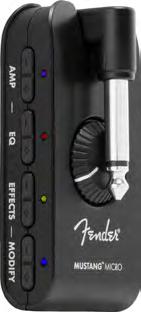
DISTRIBUTED
BY: AUSTRALIS MUSIC | ENQUIRE FOR PRICING
RECOMMENDED FOR: Future rockstars.
FEATURES: There’s nothing more iconic than an SG through a big, loud, British style amp – and that’s exactly where you’re headed with this pack from Epiphone. This player’s pack features an Epiphone SG Special E1 in the classic Worn Cherry finish, as well as an Orange Crush 12 amp, and all the cables and straps to be playing guitar in no time.
The Crush 12 itself features a Custom 6” Voice of the World Orange speaker, overdrive, and EQ control. It’s also got a cabsim output for silent practice or recording! A must for gift givers who don’t need to hear their loved one struggling through ‘Smoke on the Water’ a thousand times!
OVERALL: The Epiphone SG Special E1 WCH Electric Guitar w/ Crush & Access pack is a great first step for someone who’s never played guitar before, or
who wants to take the plunge from acoustic guitar into electric. The included Armour gig bag will protect your SG once you’re ready to start gigging, and the Crush 12 will always come in handy as a practice amp or secret studio weapon, no matter how your rig changes as you learn.
This pack is classic rock ‘n’ roll tone in a box. The SG Special has humbuckers, a three-way switch, and a satin finish to keep you playing at blistering speeds. It’s classically styled and packs a punch when paired with the Orange Crush 12.
RECOMMENDED FOR: Bass players looking for an upgrade, producers, those who’ve heard about Music Man’s quality.
FEATURES: The SUB StingRay Bass is one of Music Man’s most popular designs, and for good reason. The single humbucker provides big, clean tones, adjustable by the active preamp with volume and tone shaping controls. The humbucker helps with grittier tones without introducing too much noise once you start to push the gain.
It’s a standard scale length sitting at 34”, and the comfortable neck shape is assisted by the satin neck finish over tinted maple which looks as good as it feels. The SUB StingRay’s body is built from hardwood, and features easy bridge and truss rod adjustment access to really help you feel at home.
OVERALL: The SUB StingRay is a great bass at a great price, featuring Music Man’s unparalleled
quality in designing, building, and producing consistent sounding and feeling instruments. While the prices place the Sterling range in the middle of the market, the quality is beyond what you pay, borrowing a little from Music Man’s more upmarket USA models and Ball Family Reserve instruments.
The SUB StingRay is an even and balanced sounding bass that can handle different tones, styles, and players, from jazz to metal. The curves and contours of the body itself allow for a comfortable playing experience, and even the flattest tone from the output is entirely usable, even more so when shaped by the onboard active preamp.
Fender Mustang Micro
DISTRIBUTED BY: FENDER MUSIC AUSTRALIA | PRICE: $199

RECOMMENDED FOR: Guitar players, bass players, encouraging parents and loved ones of musicians looking for the perfect gift.
FEATURES: The Fender Mustang Micro is the micro version of Fender’s top-selling Mustang amp, an all-in-one amp solution with onboard effects, processing, and EQ controls. The Mustang Micro is a headphone amp version with Bluetooth for jamming along to your favourite songs and jam tracks.
The Mustang Micro features controls to adjust amp, EQ, and effects, allowing you to cycle through 12 amp models, 12 effect combinations, and adjustable EQ to get the signal sounding right out of the 1⁄8” headphone output. What’s more, you’ll be able to update firmware as Fender’s technology progresses via the USB connection.
OVERALL: The Mustang Micro is a great option for musicians of any level. It’s great for silent practice, and easily fits into your bag or
case for warming up before a gig or in the studio before it’s your turn to lay down your tracks. The amp models are accurate, featuring the same technology as the Mustang series of amps, but with added cab simulation so you feel more like you’re playing through a real amp with headphones.
The parameters and settings are easy to adjust, and you can take the Mustang Micro anywhere as it’s conventionally small, as well as being powered by a USBchargeable battery.
Ibanez RX40MGN Guitar Pack w/ Crush & Access
DISTRIBUTED BY: AUSTRALIS MUSIC | ENQUIRE FOR PRICING
RECOMMENDED FOR: Beginners with an interest in modern rock and metal.
FEATURES: The Ibanez RX40MGN Guitar Pack is a great gift for someone (maybe yourself!) if you’re interested in learning some more modern metal and rock. Ibanez are known worldwide for producing high performance guitar and basses at the highest level, and this trickles down to the more accessible instruments like the RX40MGN.
The Ibanez RX40MGN itself is a six-string electric guitar with two single coil pickups and a humbucker in the bridge position. It has a tremolo, volume, and tone controls and a five-way switch so you can coax interesting tones from the get go. Pair this with the included Crush 12 amplifier and you’re off to the races – the onboard overdrive, EQ, and Orange 6” Voice of the World speaker providing great grit and
distortion when you need it, or dynamic attack for cleaner solo passages.
OVERALL: The Ibanez RX40MGN Guitar Pack w/ Crush & Access includes an Armour gig bag and lead so you’ll be ready to play without having to buy any other accessories. As you progress, the Orange Crush 12 can grow with you, serving as a quiet practice amp or an extra distortion option in the studio.
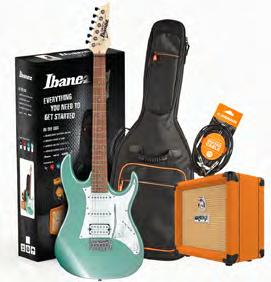
It’s hard to go past such a complete package, and when you’re getting a deal with some of the biggest names in musical instruments – why would you? The Ibanez RX40MGN Guitar Pack is the real deal.
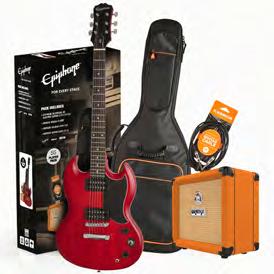
27 mixdownmag.com.au PAGEGEARHEADER GUIDE
G6 Series Solid Top Dreadnought Cutaway w/ Fishman EQ

DISTRIBUTED
| RRP: $899
BY: EGM DISTRIBUTION
RECOMMENDED FOR: Acoustic players, singer/songwriters, producers.
FEATURES: The G6 Solid Top Dreadnought from Recording King is a, pardon the pun, really solid acoustic guitar for a player of any level. The solid spruce top helps sound and acoustic energy to vibrate around and out the sound hole, rather than getting lost and fizzling out in the wood joints. The spruce gives a bright attack, while the mahogany back and sides provide a warm harmony to the whole instrument. The G6 Solid Top Dreadnought also has a Fishman Presys pickup, with a built-in tuner and tone shaping.
Aesthetically the G6 does it like a G6, with tortoiseshell scratch guard and binding adding a touch of class to the clean spruce top and mahogany sides. The headstock is inlaid with the Recording King logo in Pau Ferro, and pearl dots litter the fretboard.
Recording King overall is a stellar company producing great-sounding instruments at an accessible price. The G6 Series Solid Top Dreadnought is no exception, providing a great sound acoustically that’s only augmented by the Fishman pickup onboard. The neck is comfortable and the cutaway provides great access, while the bone nut and revebond bridge provide bright attack at either end of the guitar. The “C”shaped neck tapers out towards the dovetail neck joint for supreme comfort, and internal X-bracing makes for a solid construction without inhibiting the acoustic qualities of the guitar.
The G6 Series Solid Top Dreadnought is a pleasure to play, record, and hold, serving as a great all-rounder acoustic guitar for anyone.
Ashton + Crush Mini Guitar Pack
DISTRIBUTED BY: AUSTRALIS MUSIC | ENQUIRE FOR
PRICING
RECOMMENDED FOR: Entry-level players, future rockstars.
FEATURES: Ashton produces a huge range of accessible instruments like guitars, basses, and amps. The Ashton Electric Guitar with Crush Mini pack contains an electric guitar in your choice of Trans White, Metallic Shell Pink, Metallic Seafoam, or Metallic Gold as well as an Orange Crush Mini amp to get you started.

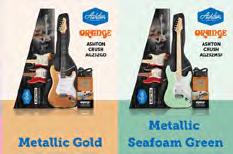
The pack includes a strap, gig bag, and lead to start playing immediately, a surefire success when buying this for yourself or someone else. This pack also includes an Ashton AG232 electric guitar, Ashton’s nod to the famed Stratocaster design. It has a basswood body and gloss finish, while the smartwood fretboard and 22 frets will have you noodling across a few octaves. The addition of the humbucker makes for a very versatile palette of tones, from big punchy chords to smooth, foot tappin’ jazz.
OVERALL: This guitar pack is a surefire way to set someone on the right path. For the family of a budding musician, it can be difficult to know what to buy, and this pack contains everything you need so there’s nothing to worry about. There’s no missing cables or adapters or pieces, so it’s one thing less on your plate, and the combo of the guitar and Orange Mini Crush sounds great!
For future proofing, the Mini Crush can also be plugged into larger speaker cabinets for progressing to gigging and recording in professional settings.
IK Multimedia Amplitube X-Drive pedal
DISTRIBUTED
| RRP: $769.99
BY: SOUND AND MUSIC
RECOMMENDED FOR: Guitar players, studios, producers, sound designers
FEATURES: The X-Drive Pedal from IK Multimedia is a stompbox-style processor with 16 overdrive and distortion effects available and three stomp switches to control them with.
The sounds themselves are created by the same company that brought us AmpliTube, a stalwart of guitar tone since its introduction to the market in plugin form. The X-Drive includes cabinet simulation for recording or gigging direct to front-ofhouse, or a standard 1⁄4” output for connection to a power amp or head. For practising at home there’s also a headphone out.
OVERALL: The X-Drive is a great tool to have around. You can tweak tones away from the pedal with the included AmpliTube 5 SE plugin and import them via USB. The 50 factory presets are entirely usable and really show off the
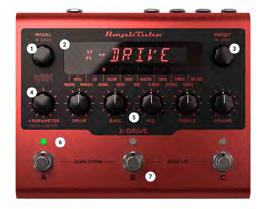
ability of the X-Drive, while you can have up to 300 presets stored for multiple tones throughout a set. The X-Drive offers all kinds of gain, from subtle boost to all out fuzz and everything in between – a tool that won’t go unused as a gift for any musician.
The connectivity options allow for multiple signal flows, and the MIDI I/O takes the X-Drive to another level when we start to discuss patch changes, tempo adjustments, and automation via MIDI. The AmpliTube plugin has been used at the highest level, so why not bring that to the stage or studio with the X-Drive?
Warm Audio Centavo
DISTRIBUTED BY: STUDIO CONNECTIONS | ENQUIRE FOR PRICING
RECOMMENDED FOR: Guitar players, tone snobs, pedal historians
FEATURES: The Centavo is an all-round boost/overdrive pedal that’s based on a famous Centaurfocused pedal. Aesthetically it’s very close, and audibly it may be even closer, but with Warm Audio’s sonic stamp across the whole design. The Centavo is a guitar stompbox powered by 9V with a single 1⁄4” input and output and a mod switch to toggle between a flatter, traditional response and a bass boost. The enclosure features three controls for gain, treble, and output.
Gain controls the gain added after the input, while treble acts as a tone control to roll off high end or introduce a little extra sparkle. The output control offers massive amounts of clean gain, or an opportunity to clip the signal when you’re driving the gain hard.
OVERALL: Unironically, the Centavo is a beast of a pedal. Warm’s take on a classic design
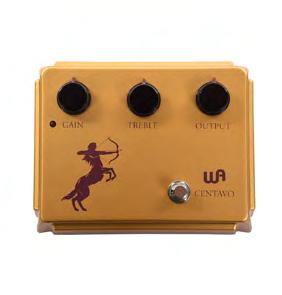
comes after years of consistently good products in the pro audio world, and their step into stompboxes is no different. The Centavo augments what you’ve already got, both shaping and pushing your tone into new territories without ever being overkill. As a boost it adds harmonic content for a present and fat, warm sound, and as an overdrive it’s crisp without any harshness at all.
The Centavo is a welcome addition to anyone’s pedalboard, even if they own a handful of similar pedals as Warm’s design brings something unique and modern to the table.
28 mixdownmag.com.au PAGE HEADER GEAR GUIDE
PRS Mary Cries Optical Compressor
DISTRIBUTED BY: ELECTRIC FACTORY | ENQUIRE FOR PRICING
RECOMMENDED FOR: Guitar and bass players who want a transparent compression option.
FEATURES: PRS are reigning royalty of guitar and bass making. Paul Reed Smith himself is very involved in the process of design, building, and delivery to their artist list, a real who’s who of guitar, so it’s no surprise that their new range of pedals hold up under the spotlight. One of these new pedals is the Mary Cries, an optical compressor pedal, meaning your signal adjusts a light emitting diode that controls how much and when compression is applied. Traditionally, optical compressors are slower to act than their VCA and FET companions, but this makes a perfect pairing with a guitar where you want the attack to poke through while the woof and mud is controlled.
The Mary Cries is a single input, single output optical compressor that’s controlled by two knobs – a compression knob that controls how compressed your signal is, and an output knob that adjusts your

Boveda Humidification Starter Kit

DISTRIBUTED
| RRP: $39.95
gain after compression is applied.
OVERALL: This is a great pedal, it simply is. Compressors can be overwhelming to those who don’t exactly understand what they’re doing, and their effect can be subtle until you’ve gone too far. The simplicity of the Mary Cries is what sells it, and you only really hear its effect once it’s missing and your tone feels lacklustre.
The slow attack of the optical style of compression means that the compressor won’t kick in until after your pick attack, so it’s great for percussion, funky playing, as well as modern metal, rock, and blues where the bark and bite of your playing needs a kick, while the rest of your tone can remain controlled and balanced.
Pedaltrain Classic JR with Soft Case

DISTRIBUTED BY: EGM DISTRIBUTION | RRP: $339
RECOMMENDED FOR: Gigging musicians, pedal aficionados, budding guitar and bass players.
FEATURES: Pedaltrain has earned themselves a spot at the top of the pedalboard market, having made quality pedalboards that are used worldwide by the biggest and smallest names in music alike. You’d be hard pressed to go to a show anywhere and not see a Pedaltrain on the stage at some point, and one of their best sellers in the Classic Jr.
The Pedaltrain Classic Jr is a medium-sized board, designed for users of 8-10 standard size stompbox pedals, with a little elevation to help reduce glare on the screens and controls of your pedals. It’s built from robust, welded metal and weighs just 1.18kg, so it’s perfect for travelling and flying, preserving your checked baggage for more important stuff. The soft case provides protection when travelling, as well as having an accessory pouch for cables, picks, and other essentials.
Peterson StroboStomp LE
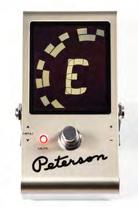
OVERALL: The Pedaltrain Classic is a great pedalboard for any player. It has space for a really solid signal chain, and accessories like power supply cradles are an easy upgrade. The board itself comes with all the hook and loop you’ll need to secure your pedals, as well as cable ties to keep it all tidy.
The weight to size ratio is unparalleled, and the soft case provides a great way to get your board from gig to gig. The layout of the four rows of welded metal allow for different routing and arrangement options, depending on what you need and where you need it.
BY: CMC MUSIC
RECOMMENDED FOR: Any and every musician who stores their instrument someplace, somehow between playing it (that’s you).
FEATURES: Many instruments are made of wood which is very susceptible to changes in humidity. The Boveda Humidity Control Starter Kit is a great way to dip your toe into an extra level of care for your instrument. Australia alone has some pretty wild swings in weather, humidity, and temperature, and this is before you even think about travelling overseas for gigs.
The Boveda Humidity Control Starter Kit takes the risk out of this, helping you to store your instrument at the optimal 45-55% RH (relative humidity) while it’s not being played (the humidity at your next sweaty, sold out gig is a problem I’m sure you’re happy to cop on the chin!). The starter kit contains two Boveda humidity control packets and a branded pouch to secure the packets to your strings.
OVERALL: Humidity is something we largely don’t worry about, but can do some real damage either over long periods of fluctuating humidity or sudden and rapid changes when travelling or in extreme weather. Hard cases are generally reasonably airtight, but this doesn’t mean that moisture and temperature fluctuations can’t creep in and throw things around a little.
Companies like Boveda recognise this and help us focus on our playing, rather than having to work around changing temperatures that affect the tuning and playability of our precious instruments. The Boveda Humidity Control Starter Kit is a great gift for yourself or another musician.
DISTRIBUTED BY: AMBER TECHNOLOGY | RRP: $339
RECOMMENDED FOR: Stringed instrument gurus, pitch perfect fanatics, strobe enthusiasts, tuna fish
FEATURES: With one of the largest displays on any stompbox tuner available today, Peterson’s StroboStomp LE offers something particularly special with this 75th anniversary Limited Edition version of their iconic StroboStomp range. Boasting 10 display colours, 100% pop-less True Bypass and buffered output modes of operation, as well as numerous other customisable features, Peterson offers a truly professional and unique tuning experience with incredible accuracy (true Strobe 0.1 cent accuracy to be precise).
A standard 85mA current draw allows additional pedals to be powered from the StroboStomp LE and with an array of Sweetened Tuning included as standard, allows for numerous stringed instruments to be quickly and easily tuned up, specific to that instrument or type of tuning, no
more guesswork required. What’s more, custom colours can be assigned to different tunings so visual distinction can be made between various tunings. A transposition range of -6 to +5 makes a wide range of instrument tunings (or drop tunings) all too easy. The StroboStomp LE’s frequency response range goes far beyond those of other tuners on the market and the stainless steel construction, solid 1/4” input and output connectors, and micro USB connector makes for a worthy companion for the most demanding playing conditions.
OVERALL: Those wanting to step up their tuning game need look no further. A true icon of tuners, this limited edition anniversary StroboStomp LE is impressive, sporting all the Peterson bells and whistles.
29 mixdownmag.com.au PAGEGEARHEADER GUIDE
Gravity Picks Coloured Gold Series
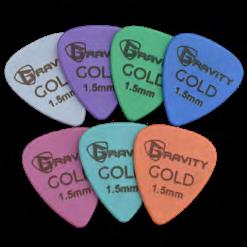
DISTRIBUTED BY: EGM DISTRIBUTION
| RRP: $11.95
RECOMMENDED FOR: Players looking for a new sound, recording studios, makers, creators, and sound designers.
FEATURES: Gravity Picks are just one of a handful of makers who focus their energy on making plectrums. We all use them, but often take for granted how the feel, texture, grip, and material affect our playing and sound. The Coloured Gold Series from Gravity Picks are Gravity’s top selling Gold Series material, now available to custom order in different thicknesses and colours.
Available with Mega Grip, Wave, or Standard grips, you won’t lose your Gravity Pick on a dark stage, and if none of those take your fancy, custom grips are available as well for your grip to be as complex or simple as you need it to be.
OVERALL: Gravity Picks remind us what an important part of our sound it is to strike the string in different ways with different
Fender Amperstand Guitar Cradle
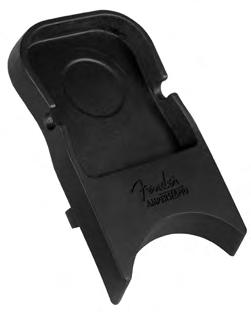
DISTRIBUTED BY: FENDER MUSIC AUSTRALIA | PRICE: $35
RECOMMENDED FOR: Stringed instrument players using any sort of amp.
FEATURES: The Amperstand is both a great play on words and the accessory you never knew you needed. Gone are the days of risking a guitar slipping when leaned against an amp, taping your picks to a mic stand or amplifier head, or losing the end of your cable behind the bustling backline of a small venue.
The Fender Amperstand is a simple rubber bowl with an indented crescent designed to cradle your guitar’s neck when the Amperstand is sat on top of your amp. With the Amperstand are both a shallow indent to store your picks, and a cable holder, ensuring nothing moves between soundcheck and that first count in.
OVERALL: The Amperstand is a great gift for a guitar player, ensuring they always have a lead and some picks around the house, and can quickly set their
materials. The tone of the pick is warm but articulate, bringing forward some of the punch and clarity that we lose when using the wrong pick. String noise is minimal, and the picks feel solid and the edges don’t wear like some with constant chugging.
Sonics aside, the texture, feel, and grip of the picks is great and what’s more, they’re available in custom designs if need be. You can order custom colours to match or offset your style, with colours ranging from Purple to Seafoam or a more subdued Grey. Often (literally) a throwaway item, Gravity Picks bring tone back into the hands of the player.
D’Andrea USA Ace Vintage Reissue Straps
DISTRIBUTED BY: EGM DISTRIBUTION
| RRP: $72.99
RECOMMENDED FOR: Guitar players, bass players, friends of bass players, family of guitar players, friends of... you get it.
FEATURES: Looking for an easy gift for a musician? Straps never go astray, least of all a great looking one. The right strap can really compliment a nice guitar, and D’Andrea makes some of the best in the biz. The Ace Vintage Reissue straps feature embroidered finishes, leather ends and a stitched vinyl interior for supreme control. They’re 2” wide with adjustable length.
OVERALL: There’s something about photos of legends like Jimmy Page, Sister Rosetta Tharpe, or Jimi Hendrix with guitars strung across their shoulders. Their style and presence is undeniable, and these three, as well as any others can be seen with classic embroidered designs on their straps that D’Andrea goes to great lengths to reproduce and pay tribute to. The
designs can be as simple as you like with the Big Sky or Summer of ‘69, or make a statement with the Peace & Dove.
The straps are comfortable, and the well-made leather ends ensure they won’t be slipping off your strap buttons. The straps themselves are slim with a thin design, but the extra layer of padding beneath the embroidery really does make a difference, being comfortable for hours at a time.
D’Andrea makes a huge range of straps in different styles, designs, lengths, and widths, but the Ace Vintage Reissue are some of the best looking, that’s for sure. A great gift to yourself or others!
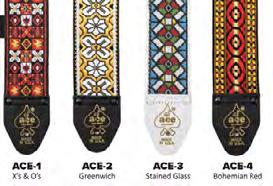
Melbourne Guitar Show tickets
DISTRIBUTED BY: MELBOURNE GUITAR SHOW | ENQUIRE FOR PRICING
RECOMMENDED FOR: Guitar nerds, tone shapers
FEATURES: Happening on March 4 and 5 at the Caulfield Race Course, it’s the event’s first time back in three years, so guitar fanatics will surely be itching to get their hands on some new equipment.
guitar down for a quick break or more permanently, the rubber cradle firmly gripping your guitar’s neck and preventing those strap buttons or glossy finishes from sliding on a hardwood floor or carpet.
It’s the little things that make music more enjoyable, and the Amperstand is a little luxury that everyone can find a use for, whether you’re giggin’ to thousands, taking a break between recorded takes, or noodling on a sunny Saturday afternoon.
Featuring all kinds of retailers from the big boys to the boutiques, the expo gives guests the opportunity to try before they buy, so they can make sure the sound, feel, and general vibe of their new instrument is just perfect. There are over 50 exhibitors expected to show their wares, so the selection of acoustics, electrics, and electro-acoustics will beat heading down to your local music shop by a mile. There will be guitars, of course, but all the fixings as well – effects pedals, amps, capos, straps, and a host of other quirky toys.
But it’s not just a place to shop. The Melbourne Guitar Show is a gathering of nearly 5000 of the city’s most dedicated musos, so it’s a great place to meet new people who share the love of the craft. There will also be information sessions and seminars for those interested in hearing about all the ins and outs of their favourite instrument.
And what would a guitar expo be without live music? Musicians of all types will take to the stage, gracing event-goers with blues, metal, jazz fusion, classical, and good-old-fashioned rock ‘n’ roll.
OVERALL: If you’re an axe-head and live in, or are able to get to Melbourne, you won’t want to miss this.
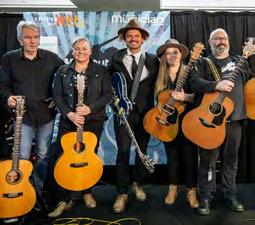
30 mixdownmag.com.au PAGE HEADER GEAR GUIDE




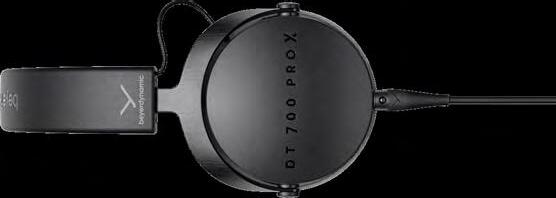
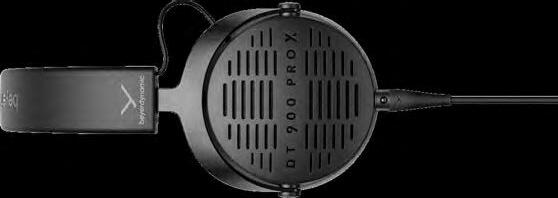



PRO X LIGHTNING CABLE & PRO X USB-C CABLE EXCEPTIONAL SOUND QUALITY ACROSS A WIDE RANGE OF PLATFORMS With the new PRO X cables and headphone packs, it’s now possible to change between different devices while maintaining a consistently high audio quality. Smart features include: CREATE THE AMAZING Integrated (DAC):Lightning® cableApple A2M USB-C cableESS ES9280A PRO High quality condenser microphone In-line remote for volume & track playback Cables feature aluminium housing & IP64 certification beyerdynamic.com.au/pages/pro-x Lightning® USB-C
Arturia MiniFreak
DISTRIBUTED BY: CMI MUSIC & AUDIO | ENQUIRE FOR PRICING
RECOMMENDED FOR: Synth lords, oscillating wizards, noise freaks.
FEATURES: In classic Arturia style, the MiniFreak Spontaneous algorithmic synthesiser is something rather weird and wonderful. Its bold design and rich-sound scaping palette allow users to explore and refine the strangest of timbres with its powerful two engines, six voices and its (behemoth) 22 oscillator modes. Cleverly blending the beauty of the analogue and digital worlds, MiniFreak is near boundless in its expression, ranging from FM to Virtual Analogue and much, much more – create luscious pads, blistering leads, crunchy sawtooth sonic mayhem, or spooky vowel-like voices. Aside from lush oscillators and LFOs, MiniFreak packs in a glorious polyphonic analogue filter with HPF, BPF, and LPF types available, as well as a cycling envelope for unique modulation shaping and a packed to the brim sequencer and arpeggiator for creative stepped
and rhythmic possibilities. To top off the insanity of MiniFreak, three stereo FX engines can be called up, with a massive range of flavours to choose from – deep modulation, trippy delay, and reverb, pulverising distortion and bit-crushing as well as EQ and compression. Every possibility is covered to allow one’s inner freak to shine bright.
OVERALL: MiniFreak continues on from where the famed MicroFreak left off – taking sonic possibilities to a whole new level of potential exploration. The depth of the engines and detail of the voicing and effects are inspired, sure to leave users getting lost in their own creative dreamscapes.
Nektar Impact LX Mini
DISTRIBUTED BY: SOUND AND MUSIC | PRICE: $269.99
RECOMMENDED FOR: MIDI masterminds, production novices.
FEATURES: Packed with tactility and an intuitive layout, the Nektar Impact LX Mini is a MIDI controller keyboard with a lot on offer. 25 velocity-sensitive minikeys with a choice of four velocity curves make tailoring the feel of the Impact LX Mini’s keyboard easy, and the dedicated octave buttons quickly expand the range of the keyboard, whilst the joystick boasts four modulation controls in one. When used with a DAW, the Impact LX Mini’s seven transport buttons spring into action, and as all buttons are MIDI-assignable, using the shift button doubles the number of assignments, and with Nektar DAW integration, up to 21 pre-mapped assignments can be made.
Each of the Instrument, Internal and Arp/Repeat mode buttons instantly assign the panel to corresponding features, with the Instrument Mode button
allowing the LX Mini to feel and operate like a hardware synth with its assignable buttons. Part 2 is a unique feature of the Impact LX Mini and allows users to, for example, momentarily jump up an octave and play a lead line while still retaining a bass part held down by the first layer. The eight velocity-sensitive pads round out the Impact LX Mini’s feature set.
OVERALL: A great option for those just getting into the world of MIDI controllers and DAWbased production and workflow. The tactile and easy to navigate layout makes for quick learning and encourages on the fly creative flare.

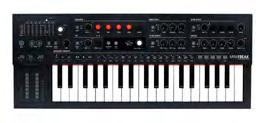
Numark Mixstream Pro
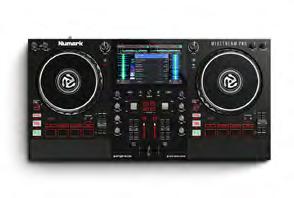
DISTRIBUTED BY: ELECTRIC FACTORY | RRP: $1,199
RECOMMENDED FOR: Budding to experienced DJs, producers, small club venues.
FEATURES: With the sheer power and ease of use all-in-one DJ controllers are able to pack into one conveniently sized package, it’s no wonder many DJs are making the jump away from the formats of old. The Numark Mixstream Pro is a fine example of such a commanding device, with a wealth of input flexibility, deluxe screen size and built-in wi-fi for easy, onboard streaming access make this portable DJ controller very alluring indeed – to DJs both experienced and those on the way up. The intuitive touchscreen workflow makes navigation a breeze, saving those valuable seconds during a set, while the overall quality, feel, layout, and tactility of the Mixstream Pro with its 6” scratch wheels make for a very satisfying overall experience, both hands on and when diving deep through the touch screen. If the audio side of things wasn’t enough, the Mixstream Pro
also has full DMX functionality, allowing for the control of DMXequipped light, a true house party workhorse.
OVERALL: The quality, feel, and overall presentation of the Mixstream Pro leaves other lower spec’d controllers in the dust – this is just a cut above the rest in terms of quality and performance. From the platters to EQ and FX buttons and knobs, and of course the touch screen, the Mixstream Pro provides the goods. And for those enjoying the luxuries of Philips Hue Smart Home, this powerful controller interacts with this too.
Novation Circuit Rhythm
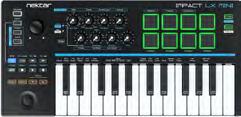
DISTRIBUTED BY: FOCUSRITE AUSTRALIA | ENQUIRE FOR PRICING
RECOMMENDED FOR: ITB composers, sample-based production types, beatmakers.
FEATURES: With the Circuit Rhythm, recording samples to hardware is easy. Its pad based workflow is fast and flexible while noticeably missing a screen which has become commonplace on hardware samplers, in turn making for a much more tactile and intuitive user experience. With 10 knobs along the top allowing for plenty of tweakability of all the important parameters – volume, tune, filters, and distortion just to name a few, the Circuit Rhythm’s layout is equal parts controller and sample/sequencer. There’s a bunch of easy to implement effects as well on the sampler including lo-fi tape, beat repeat, delay, reverb, and sidechain available on every channel along with a master compressor. You can change up your beats in other ways too, like utilising the probability and pattern mutate features. Connectivity
wise, there’s MIDI in, out and thru for connecting to hardware synths and the like, two inputs for sampling, two 1/4” outputs and a headphone jack for making music late at night and on the go. There’s a MicroSD for saving samples and projects to and can connect to both Mac and Windows via USB-C to utilise their Novation Components software. This software allows you to load and backup packs, samples, projects, and grid FX.
OVERALL: All in all, the Circuit Rhythm is a superb, small form factor, standalone sampler that allows you to chop up and make beats, with an easy to use interface that lends itself to boundless creativity.
32 mixdownmag.com.au PAGE HEADER
GEAR GUIDE
Alesis Harmony 61 Pro
DISTRIBUTED
| RRP: $399
BY: ELECTRIC FACTORY
RECOMMENDED FOR: Keyboard enthusiasts, beginner Beethoven’s
FEATURES: True to the Alesis aesthetic, the Harmony 61 Pro packs a lot of features into one package – with 61 touch-sensitive keys, a mammoth sound library, and all the bells and whistles for hands-,on creative control, including pitch-bend wheel, X/Y performance touch pad and DJ-style effects providing all the vibe! Aside from the wealth of sounds (580 to be precise), the Harmony 61 Pro also packs some rather inspiring additional modes, expanding the possibilities of creative expression. The DJ-style Mix Mode packs 30 unique styles, with 5 sections each, and the build-in sampler allows for creating fun and interesting arrangements on the fly – being able to take instruments in and out while playing, the ultimate composition companion! What’s more, the built-in microphone allows for sampling of one’s own sounds for further creative expression. Those wanting more practice tools, 177 built-in songs are provided with
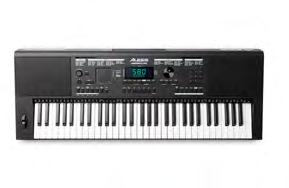
Chateau Valencay CAS-22
Alto Sax
DISTRIBUTED BY: KJ MUSIC
| PRICE: $1,595
RECOMMENDED FOR: Beginner to intermediate saxophonists and students.
FEATURES: The perfect introductory sax, the Valencay CAS-22 Alto boasts a ribbed construction which heightens the overall strength of the saxophone making it ideal for the daily haul from locker to school bag. Visually, it boasts a striking gold lacquer finish providing that classic brass look, an engraved bell and body with the Chateau logo featuring on the bell, and mother of pearl finger buttons to avoid your fingers heating up while playing as some plastic finger buttons will do.
Internally the sax boasts the superreliable Pisoni pro pads to prevent air leakage, and Italian blued steel springs to ensure attentive response. This alto sax is in the key of Eb and features a high F# to extend the player’s range meaning even more versatility in the hand.
Like Chateau’s equally cool Chenonceau Alto, the Valencay
step-up lesson functionality, and being able to record performances to the SD input allows for even further possibilities. An abundance of onboard FX including reverbs, modulation, and slicer effects help create further depth and expression to users sounds and can be heard through the powerful 30-watt inbuilt stereo speaker system, headphones in or out to an external sound system via the 1/4” output. There isn’t much the Harmony 61 Pro doesn’t cover for the price.
OVERALL: A feature-packed keyboard covering all the sounds and creative tools one could possibly need in a keyboard in this range. Perfect for beginner players through to the more experienced keyboardist.
Chambord CAS-50 Alto Sax
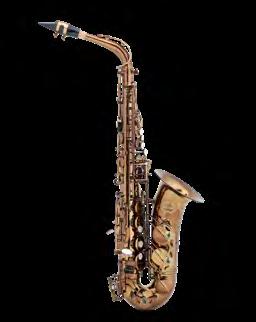

DISTRIBUTED BY: KJ MUSIC
| PRICE: $1,995
RECOMMENDED FOR:
Intermediate saxophone players, experienced players looking to make the move to alto.
FEATURES: The Alto Sax is an important part of an orchestra, the richer timbre filling in the middle ground between the high-pitched tenor horns and big, boomy, bombastic low end instrumental like tubas. The Chambord CAS50 Alto Saxophone with High F# offers a superior range from low, brooding notes to dynamic, emotive highs.
The Chambord CAS-50 Alto Saxophone, finished in classy Cognac, is a great option for someone looking to upgrade their alto sax. The bigger bell across the whole Chambord CAS-50 provides a louder tone with more resonance and harmonic information for impact and balance in all the right areas. The CAS-50 is made of brass, features a ribbed construction, double arms on bell keys, and Pisoni HT Pads for precise intonation.
Mapex Mars Maple and Mars Birch
DISTRIBUTED BY: ELECTRIC FACTORY | RRP: FROM $999
RECOMMENDED FOR: The drummer’s drummer, studio or live player, backline hire
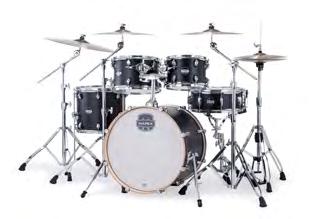
OVERALL: Chambord CAS-50 Alto Sax would be a welcome gift for someone looking to take their playing to the next level. It’s a great step up from entry level saxophones, and would see a player being able to push their limits thanks to better construction, and a more refined design for pitch perfect playing.
Mother of Pearl buttons are a welcome addition as they provide a great look but a smooth touch for the player. The CAS-50 is available in a few different finishes depending on your preference, most of the CAS-50s featuring a beautiful engraved design to cap it all off.
zippered backpack case, mouthpiece, cap, and ligature to attach the reed to the mouthpiece.
OVERALL: This saxophone will be a great gift for intermediate saxophonists or music students looking to be introduced to the wonderfully slick instrument. Its playing features instils reliability to those looking to take the next step in their sax playing, while ultimately acting as the perfect introduction with its durability and strength with the playing quality a bonus.
If your child thinks they want to learn a different instrument to be ‘cooler’, just get them to check out saxophonists in any jazz ensemble, the coolest cat there!
FEATURES: Having continually defined the benchmark of what a mid-range kit should offer, the updated Mapex Mars series once again sets the standard of a world class mid-range kit, with both 100% 7-ply European maple and 100% 6-ply birch offerings within the ever-popular Mars range. As expected, the proprietary Mapex SONIClear-bearing edges come as standard, increasing head and shell contact for clear and defined tone and allowing for a wide tuning range. The tom holders are also equipped with the SONIClear suspension system, providing maximum sustain and projection. With gorgeous lacquer finishes on the Maple and four new sparkle-wrapped finishes for the Birch versions, these freshly updated finishes are sure to entice even the most discerning of drum fanatics. Coming in a variety of configurations and sizes, both the Mars Maple and Birch comfortably
cover the requirements of any user, whether it be for studio or live, from jazz to rock or metal.
OVERALL: An impressive mid-tier option with superb shell quality, construction, and tone. Packed full of Mapex character and features, the updated Mars Maple and Birch kits are certainly worthy of any player, whether it be for touring, sitting in the studio or anywhere in between. As with anything Mapex, one can expect reliability and quality – a gift worth its salt in any discerning drummer’s eyes.
33 mixdownmag.com.au PAGEGIFTHEADER GUIDE
Yamaha AG03 MK2 Live Streaming Pack
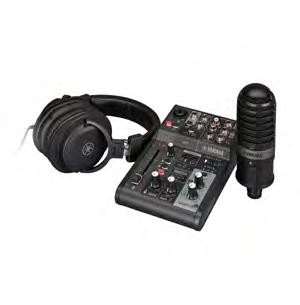 DISTRIBUTED BY: YAMAHA MUSIC AUSTRALIA | ENQUIRE FOR PRICING
DISTRIBUTED BY: YAMAHA MUSIC AUSTRALIA | ENQUIRE FOR PRICING
RECOMMENDED FOR: Streamers, gaming, live online event hosts
FEATURES: Yamaha has a small range of AG mixers that has recently grown with the Yamaha AG03 MK2. Designed as a streaming mixer, the AG03 MK2 has multiple inputs designs for voice, instrument, and other sources, all routed with their own gain and volume controls before monitor and headphone outputs allow to hear back what you’re streaming. The AG03 has USB connectivity, limiting so you won’t send distorted and unclear sound to your audience and multiple input types like 1/4”, RCA and USB so you’ll be sorted no matter what other gear you’re working with. Better yet, the mixer is teamed up with a YCM01 cardioid condenser microphone and a pair of YH-MT1 headphones.
OVERALL: The AG03 is a really simple solution to a possibly technical nightmare of sources,
Audio-Technica AT2020USB-X
DISTRIBUTED BY: TECHNICAL AUDIO GROUP | PRICE: $269
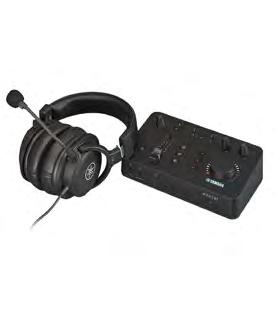
RECOMMENDED FOR: Podcasters, streamers, gamers, musicians, on the go recordists.
FEATURES: Having always been a company to embrace technological advancements, consistently packing innovation into their products, the AudioTechnica AT2020USB-X is no exception. Taking everything users have come to know and love about their superb AT2020 condenser mic and making it an even more powerful entry-level condenser just makes sense –allowing direct connectivity to a computer, albeit not sacrificing quality. An absolutely no-brainer plug and play experience, the AT2020USB-X puts users immediately at ease with its USB-A or USB-C connectivity options, with connectors located at the bottom of the mic. Being able to record at 24-bit and at a sample rate of up to 96kHz means incredibly detailed capture of a mic in this class – directly in a DAW. The included mount is solid and looks the part, and
latency, and signal flow. The AG03 MK2’s small footprint means you can take it anywhere, an increasingly important addition in the modern world where content creators can be making video, streaming or recording multiple sources from anywhere in the world.
Your gain and output controls are all within reach, as well as handy mute buttons for different sources, phantom power onboard and a footswitch input to control different parameters if need be. Onboard DSP processing allows you to adjust and effect signals before it’s played back for yourself and your audience.
Zoom PodTrak P4
DISTRIBUTED BY: DYNAMIC MUSIC | ENQUIRE FOR PRICING
RECOMMENDED FOR: Podcasters, mobile broadcasters, travelling musicians.
FEATURES: Featuring four XLR inputs and four individual headphone outputs with individual volume control, gain control knobs, and mute buttons for each input, all in an extremely compact footprint. The P4 is also a two-in and two-out audio interface, allowing you to record directly to your computer, Android, or iOS device. Additionally you can stream your podcast.
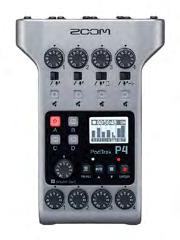
Accounting for mics of all denominations, there is phantom power for all XLR inputs, with all input sources having the ability to be recorded on separate tracks to give you that bit of freedom in post-production. If you can’t use your Zoom P4 in person and need to rely on the online Zoom call, you can connect your phone to the P4 with a TRRS cable (adapter may be required), or connect to your computer via USB. The P4’s built-in mix-minus feature means
distracting echo and feedback will automatically be eliminated.
Additionally, you can trigger sound effects using four assignable sound pads with 11 preset sounds. You can export in 16-bit /44.1kHz audio WAV, as you record directly to SD, SDHC, and SDXC cards up to 512 GB. It boasts up to four hours of use with just two AA batteries or a USB power supply.
OVERALL: The PodTrak P4 is your one-stop-shop to record your podcast whether your setup is stable or mobile, boasting all the features you need to tidy up your recording and editing process.
the included cable gives plenty of length for those wanting to operate the mic further away from their computer. Direct monitoring via the headphone output on the side of the mic is all too easy, as is volume, mix adjustment and muting of the mic (which even glows red when muted). The 20Hz-20kHz frequency response means every detail is captured at studio quality resolution.
OVERALL: It’s Audio-Technica and a modern update on their now iconic 2020 condenser mic, say no more! For those wanting to get into podcasting, streaming or just looking for an easy, hasslefree recording solution, the AT2020USB-X provides a top quality solution that doesn’t break the bank!
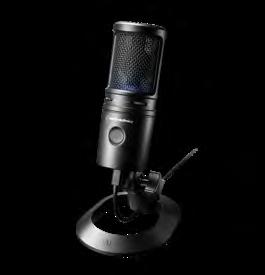
Yamaha ZG01 Game Streaming Pack
DISTRIBUTED BY: YAMAHA MUSIC AUSTRALIA | RRP: $699
RECOMMENDED FOR: Gamers, streamers, Twitch types.
FEATURES: Getting into the world of gaming is one thing, but figuring out how to stream video as well as audio from a few sources can be a whole other world of tech. Introducing the Yamaha ZG01, the first audio mixer designed specifically for streaming.
The ZG01 is a mixer with connectivity for your mic and headset, voice chat, and game audio all in one, with a big master volume to control your overall volume. This way you can stream your own voice as well control your headphone output, speak to others, and mix the audio of the game and other streamers so you can focus on the content and not the creating.
OVERALL: Yamaha are clearly listening to the market with their ear to the ground. The ZG01 features everything you need to start streaming, and without
clunky tech to interface multiple mics and sources together, to be summed at a final output. The ZG01 handles the routing and interfacing, allowing you plug and play, with good quality audio and ease of access to controls if you need to adjust them in the middle of a stream.
Diving deeper into the layout of the ZG01 only allows you to customise your listening and recording environment further, for clarity of source material and routing. The ZG01 is an all in one solution without the latency, interfacing and compatibility issues of running multiple inputs and outputs.
34 mixdownmag.com.au PAGE HEADER GEAR GUIDE
Focusrite Vocaster One
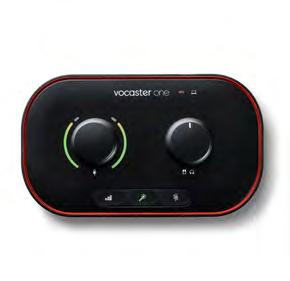 DISTRIBUTED BY: FOCUSRITE AUSTRALIA | RRP: $299
DISTRIBUTED BY: FOCUSRITE AUSTRALIA | RRP: $299
RECOMMENDED FOR: Podcasters, conjurers of content creation, streamers.
FEATURES: There’s never been a better time to explore the world of dedicated audio interfaces designed to meet the needs of podcasting and content creation. Focusrite has earned a solid reputation for their audio interfaces over the years – matching simplicity and quality in their products, and the Vocaster One is no exception. Layout, connectivity, and overall functionality of the Vocaster One couldn’t be easier to understand and operate. One XLR input for connecting a microphone (48V being available for condensers of course), one 1/4” TRS output for headphones, 1/4” outputs for connecting to monitors, and two 3.5mm inputs for connecting a phone and camera complete this delightfully simple interface. A whopping 70dB of gain is available on the microphone input, with auto gain functionality taking the guesswork out of the equation for setting optimal record levels,
as well as a handy mute button and four on-board voice presets to get things started. The two large knobs on the top face of the Vocaster One couldn’t be easier to adjust and operate making professional quality recording a breeze. The two built-in stereo loopback paths make for easy streaming and seamless transitions for any session and round out this professional package.
OVERALL: A charming little interface for a simple, hassle free setup and operation for any setup. A perfect companion for the budding podcaster, content creator, or otherwise. It’s Focusrite – you can’t really go wrong.
beyerdynamic DT 900 PRO X Lightning Pack
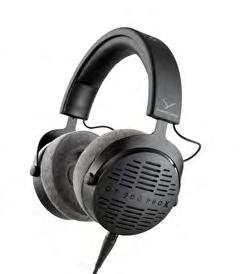
DISTRIBUTED BY: SYNTEC RRP: $499
RECOMMENDED FOR: Studio maestros, audiophiles, content creators, DJs, Apple enthusiasts
FEATURES: How too often we get caught out wanting to listen to some tunes on a walk, public transport or alike but sure enough, the damn Apple Lightning adaptor is nowhere to be found! But fear no more friends, beyerdynamic have us covered. Included in the DT 900 Pro X Lightning Pack is a Lightning cable with integrated Apple A2M DAC and an inline remote and mic. No need for holding onto all the adaptors or having multiple different headphones crammed into ones’ backpack, just a pair of DT 900 PRO Xs, please and thank you. This handy little addition to these already ubiquitous headphones takes them out of the studio and onto the heads of users from all walks of life. With a monstrous 5Hz-40kHz frequency response, all-too-suitable 48 ohms impedance, and insane comfort to match, the DT 900 PRO X
Lightning Pack is perfectly pitched for both the studio recluse and on-the-go user. The STELLAR.45 transducer driver throws out a huge sound with an extended, punchy low end, crystal clear highs, and delectable midrange detail. A vigorous spring steel adjustable headband makes for extended listening sessions a breeze, with all parts replaceable – making an overall sustainable design, matching the expectations of headphone users in 2022.
OVERALL: A superb pro studio quality headphone now with a dedicated Apple Lightning cable with integrated DAC, remote, and microphone. The perfect gift for any discerning studio boffin, gamer, or avid music listener. Enough said.
Audio-Technica AT2040
RECOMMENDED
FEATURES: If you are at all interested in the above applications, it’s hard to look past the AT2040 podcast microphone from Audio-Technica. It’s a dynamic, large diaphragm, end address microphone with a hypercardioid polar pattern, that comes housed in a sleek, all metal enclosure. It uses a professionalgrade XLR output and requires no phantom power to run on account of it being dynamic. There’s an integrated shock mount present here which reduces noise travelling through the mic stand, as well as a multi stage wind screen consisting of a nonwoven filter and foam mesh to tame plosives (think boomy p’s and b’s) from reaching your recording. A doff of the hat to broadcast mics past, the Audio-Technica AT2040 comes with a mount attached to the mic for easy manoeuvrability. This will also screw onto basically all microphone stands courtesy of the 5/8”-27 to 3/8”-16 threaded adapter. For transporting this

microphone, there’s an included soft protective pouch to ensure your AT2040 stays in good nick while on the move, and at 615g, it won’t weigh down your microphone stand, while still being solid enough to take a knock due to its all metal enclosure.
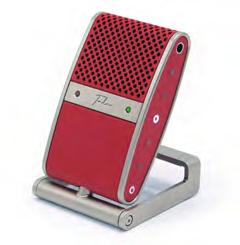
OVERALL: With content creators likely wanting to have an all-in-one solution available and not have to purchase extra accessories, this fits the bill. With its affordable price tag, robust construction, and great sounding, noise rejecting qualities, the AT2040 is sure to be a hit for online content creators –keep your eyes peeled for it in the next YouTube thumbnail!
Tula USB Microphone
DISTRIBUTED BY: STUDIO CONNECTIONS | ENQUIRE FOR PRICING
RECOMMENDED FOR: Podcasters, content creators, mobile recordists, those in vogue.
FEATURES: From podcasters and content creators, through to being able to comfortably capture a full band rehearsal or be used as a mobile recorder (with its rather handy 8GB of internal storage) – the Tula USB Mic is an ideal companion for many users, sporting numerous features many other microphones of this type simply cannot tout. Its high quality build features Burr-brown op amps, a frequency response of 50Hz-20kHz and is capable of recording at 16-bit and 48kHz. Real-time monitoring is conveniently located via the 3.5mm headphone jack on the side of the mic, and this also doubles up as a lav mic connector. The cardioid and omnidirectional capsules offer plenty of flexibility depending on the desired use and response from the mic – ideal for capturing a single voice of a whole ensemble if required. The active noise cancelling from Swedish
company Klevgrand is something to marvel at in a little pocket-sized mic like this, helping alleviate extraneous noise from recordings – fantastic for things like noisy air conditioners and alike in less than ideal recording environments. The USB-C port allows for quick connection and data transfer to a computer so editing and mixing of recorded material is a breeze.
OVERALL: A superb little microphone that not only looks stylish, but packs the features and build quality one might not even realise they needed. What’s more, you can get a free Black Nylon Case in December with any Tula Mic bought.
35 mixdownmag.com.au PAGE HEADER
DISTRIBUTED BY: TECHNICAL AUDIO GROUP | PRICE: $169
FOR: Podcasters, content creators.
GEAR GUIDE
Audio-Technica ATH-M20xBT
DISTRIBUTED BY: TECHNICAL AUDIO GROUP | PRICE: $169
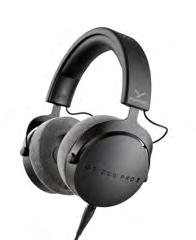
RECOMMENDED FOR: Budding producers, musicians on the go, students, music lovers.
FEATURES: Already an industry standard and one of AudioTechnica’s most popular products, the ATH-M20x now comes in a Bluetooth enabled pair – the ATH-M20xBT. Mentioning the non Bluetooth version here is for good reason, as these headphones have embedded themselves into the mainstream of studios, classrooms, and audio installations the world over, and this is by no mistake. These affordable, high quality headphones set an astoundingly high quality standard for an entrylevel headphone, and offering this model with Bluetooth seems like a no brainer really. Touting a whopping 60 hours of battery life, a frequency range of 15Hz20kHz and intuitive, conveniently located connectivity makes the ATH-M20xBT for a wide variety of users who demand high quality audio, maximum comfort, and reliability in the one package. One of the niftiest features of all though
beyerdynamic DT 700 PRO X USB-C Pack
DISTRIBUTED BY: SYNTEC | RRP: $499
RECOMMENDED FOR: Studio maestros, audiophiles, content creators, DJs
FEATURES: If ever there was a time to have a pro, studio-quality headphone to come with all the essential accessories, it would be right here and right now, in 2022. Thankfully, beyerdynamic are all over it, covering all the possible angles of how their famed DT 700 PRO X headphones might be getting used. This USB-C Pack edition includes (you guessed it) a more than useful USB-C cable with integrated ESS DAC and an inline remote and mic. “You mean I can enjoy high fidelity phone calls and be able to make on-the-fly voice memos directly to my connected smart phone or other such device?” Yep! This nifty addition to these already crazy popular headphones expands the format of use, all the while enjoying the whopping 5Hz-40kHz frequency response, user-friendly 48 ohms impedance and other great features, perfectly pitched for both the on-the-
is the headphones multipoint pairing feature. This allows for the ATH-M20xBT to be paired to multiple devices simultaneously, for lighting fast change over from laptop, to phone, and back again – no disconnecting, reconnecting, and waiting to pair time here. This alone is worth it!
OVERALL: An already wellestablished headphone, the ATH-M20xBT works off a solid reputation with a superbly integrated Bluetooth system that goes above and beyond what most would expect. As expected from Audio-Technica, these headphones are made to the highest quality and just work as they should. A superb gift for those who love quality sound and the convenience of Bluetooth.
Steinberg UR22C Recording Pack
DISTRIBUTED BY: YAMAHA MUSIC
AUSTRALIA | RRP: $569
RECOMMENDED FOR: Entry-level recorders, home studio types.
FEATURES: Comprising an audio interface, microphone, and pair of headphones, this one is ideal for beginners looking for an affordable entry into the vast world of laptop recording without compromising on sound quality.
Given its super versatile, plug and play operation, the UR22C also doubles as an awesome small scale Content Creation option, perfect for all those budding podcasters and streamers out there, giving you all you need to get your thoughts and feelings out on the information superhighway. Steinberg’s UR22C audio interface offers 32-bit audio quality, letting you enjoy crystal clear recordings of guitars, keyboards, and other audio sources, while the included ST-M01 condenser microphone is quite clear in the midrange and boasts a distinctive character best suited for vocals; if you’re into ASMR, you’ll vibe this one. The ST-H01 headphones aren’t too bad either!
ESI U22 XT Recording cosMik Set

DISTRIBUTOR: SOUND AND MUSIC | PRICE: $489.99
RECOMMENDED FOR: Home studio hermits, bedroom producers, podcasting protégés
It’s worth reading the manual if you’ve never operated or set up an audio interface or microphone before, but once you’re acquainted with its features, the UR22C recording pack is super straightforward. USB-C connectivity ensures that the interface is swift in operation, while the loopback function is great for pairing high quality audio with a video source for streaming.
OVERALL: Being a Steinberg product, you just know the build quality and intuitivity of the feature set are going to be high on the priorities list here and the UR22C Recording Pack does not disappoint in this regard. Whether podcasting, streaming, recording, or mixing, the UR22C Recording Pack is one hell of a Christmas gift. Mum, I hope you’re reading this!
go user and studio hermit. The STELLAR.45 transducer driver pumps out massive sound producing extended, defined low end and crystal clear highs, with all the midrange detail in between. The infamous beyerdynamic velour pads are as luxurious as one would expect, with a robust spring steel adjustable headband making for outrageously comfortable extended listening sessions. All parts are indeed replaceable for a sustainable design, clearly reaching the demands of modern users.
OVERALL: A gift worthy of those working professionally in the studio, creating a variety of content at home or on the road or for those simply looking for some accurate, high quality professional headphones capable of connecting to USB-C devices.
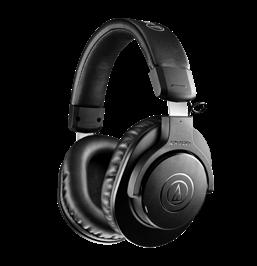
FEATURES: Often when on the hunt for a suitable beginner level home recording or podcasting setup, it’s best to not over complicate things – and for times like these, the U22 XT Recording cosMik Set is just that, a no nonsense professional recording bundle with everything one could possibly need to get started. The U22 XT USB bus powered audio interface sports two inputs (XLR/1/4” combo jack and 1/4” Hi-Z), balanced 1/4” outputs, 48V phantom power and supports 24-bit 96kHz recording. The cosMik 10 condenser microphone has a cardioid polar pattern, 1” diaphrapgm, 30Hz-18kHz frequency response, 132dB dynamic range, and 135dB max SPL. It also comes with a handy desktop tripod stand and windshield.
Lastly, the eXtra 10 headphones are a cosy on-ear monitor
headphone with a user friendly 32-Ohm impedance, 92dB SPL (1mW) sensitivity, and frequency response of 15Hz-29kHz. The attached cable is 2.5m long and includes the expected gold plated 3.5mm – 1/4” screw on adaptor, how we can never have enough of them lying around! Bundled with Bitwig 8-track, the U22 XT cosMik Set is ready to get recording started, equipped for recording, and mixing straight out of the box.
OVERALL: With its funky, retroesque orange colouring and accessories to boot, this is a solid option for those looking to get into home studio recording on a budget.
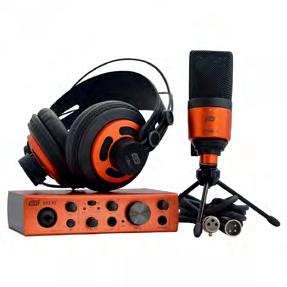
36 mixdownmag.com.au PAGE HEADER GEAR GUIDE
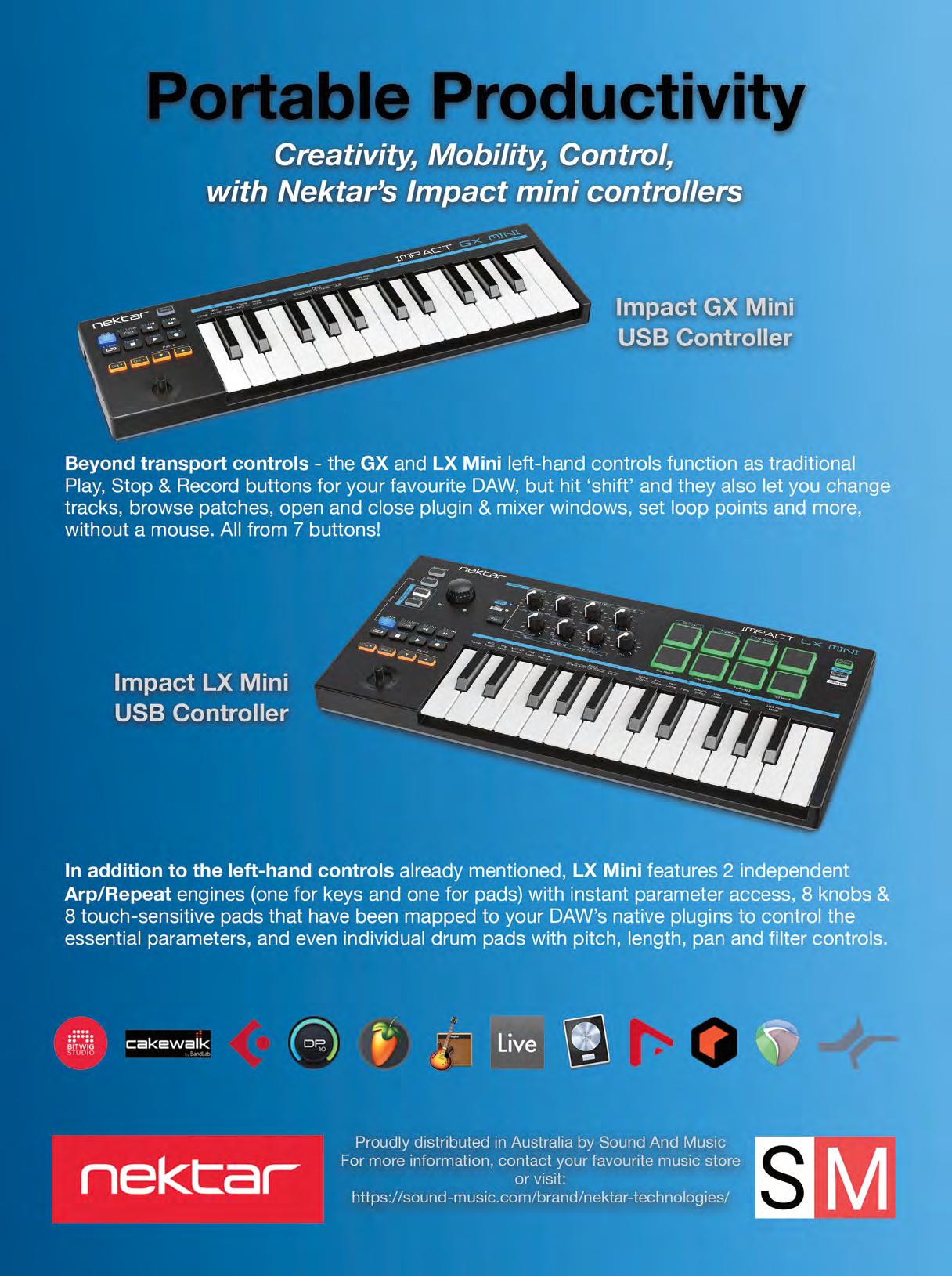



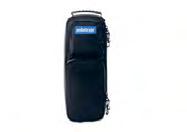




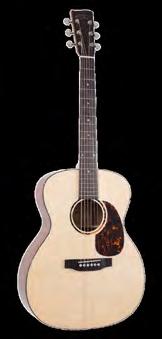
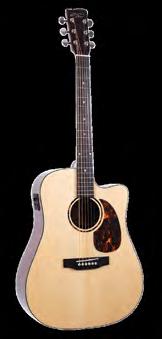
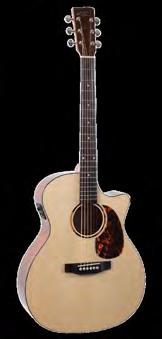
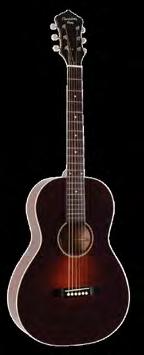
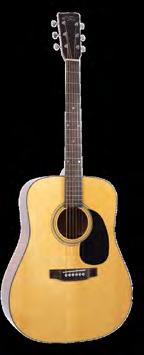
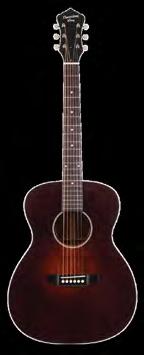
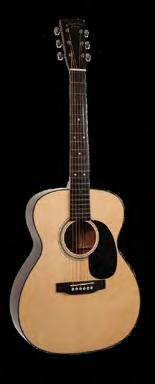
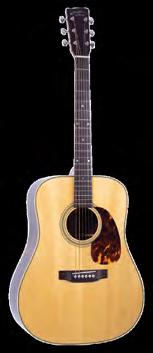
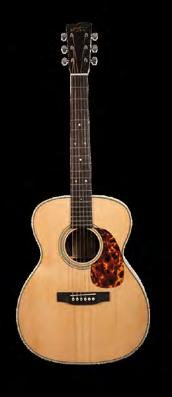
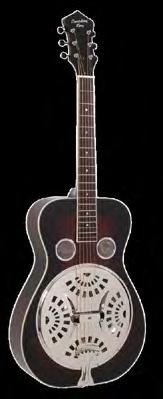
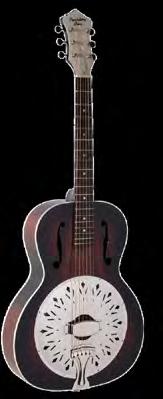
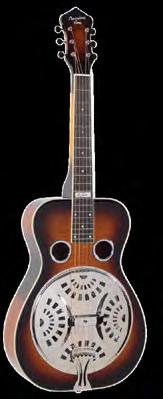
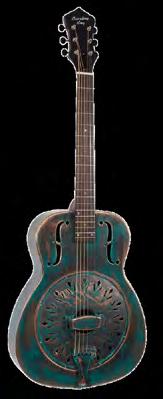


edalt P ement Soft Cases RK-RP-G6 Solid Top Single 0 Guitar RK-RO-G6 Solid Top 14th Fret 000 Guitar 003 RK-RD-G6-CFE5 Dreadnought Cutaway EQ Solid Top 004 RK-RGA-G6-CFE5 Grand Auditorium Cutaway EQ Solid RK-RD-318 All Solid mahogany Dreadnought RK-RO0318 All Solid mahogany 000 14th fret RK-RD-328 All Solid rosewood Dreadnought RK-RO328 All Solid rosewood 000 Resonator G6 Series Series 11 Tonewood Reserve Bridging the gap between great sound & great value Tonewood Reserve Rosewood Models RK-RR-36-VS Round neck Maxwell series RK-RR-41-VV Biscuit cone Rattlesnake small body guitar RK-RR-75PL-SN Phil Leadbetter signature squareneck RK-RM-997-VG Swamp Dog style 0 bell brass distressed RK-RM-993 Nickel plated bell brass parlor RK-RM-991 Tricone nickel plated bell brass body mahogany neck, 3 hand spun European cones. RK-RPS-11-FE3-TBR Size 0 body Acoustic/ Electric Guitar RK-ROS-11-FE3-TBR 000 body Acoustic/ Electric Guitar





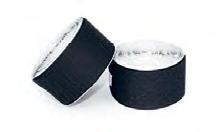
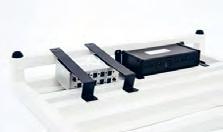
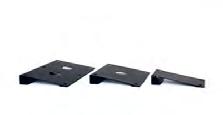


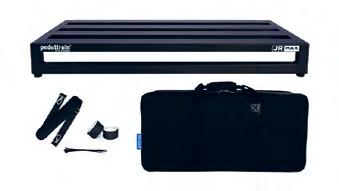
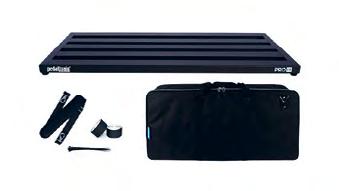
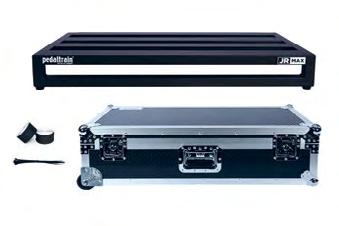
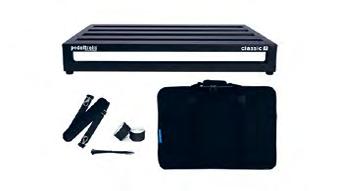
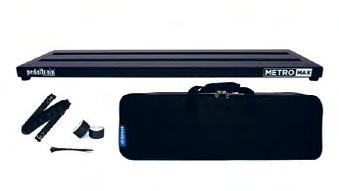
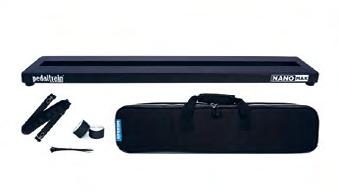

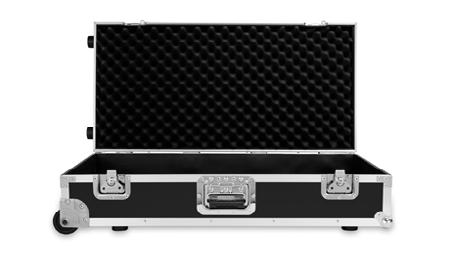
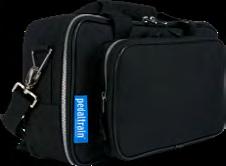

Pedaltrain Nano MAX with Soft Case O TERRA A LL NE W M A X S E RIE S Pedaltrain PRO FX with Soft Case Hook-and- Mounting Kits edal Boosters ement Tour Case in Black Honeycomb Finish Pedaltrain Classic 3 with Soft Case (PT3 Reissue) Pedaltrain Metro MAX with Soft Case Pedaltrain Nano MAX with Soft Case LIFETIMEWARRANTY ain Nano MAX NANO METRO CL SIC NOVO TERRA A LL NE W M A X S E RIE S Pedaltrain PRO FX with Soft Case NEW DELUXE BAGS COMING SOON Replacement Soft Cases Hook-and-Loop Mounting Kits Pedal Boosters Repla Ha T ain JR MAX with our Case in Black Hon y -CL3-SC Pedaltrain Classic 3 with Soft Case (PT3 Reissue) -MMAX-SC ain Metro MAX with Soft Case -NMAX-SC Pedaltrain Nano MAX with Soft Case PT-JMA edaltrain Nano MAX with Soft Case NANO METRO CL A LL NE W M A X S E RIE S PT-PFX Pedaltrain PRO FX with Soft Case NEW DELUXE BAGS COMING SOON ement Cases Hook-and-Loop Mounting Kits Pedal Boosters Replacement Hard Cases -JM ain JR MAX with our Case in Black Hon T Pedaltrain Classic 3 with Soft Case (PT3 Reissue) edalt Pedaltrain Nano MAX with Soft Case All Pedaltrain pedal boards carry a lifetime warranty. See www.pedaltrain.com for conditions PT-CL3-TCW Pedaltrain Classic 3 with Wheeled Tour Case in Black Honeycomb Finish Voodoo Lab Mounting Kit New replacement Tour Cases and Soft Cases SIGNIFICANT UPGRADES ALL ROUND AT NO EXTRA COST! ALL NEW MAX SERIES PT-JMAX-SC Pedaltrain Nano MAX with Soft Case O TERRA A LL NE W M A X S E RIE S PT-PFX-SC Pedaltrain PRO FX with Soft Case NEW DELUXE BAGS COMING SOON Replacement Soft Cases Hook-and-Loop Mounting Kits Pedal Boosters Replacement Hard Cases PT-JMAX-TCW Pedaltrain JR MAX with Wheeled Tour Case in Black Honeycomb Finish PT-CL3-SC Pedaltrain Classic 3 with Soft Case (PT3 Reissue) PT-MMAX-SC Pedaltrain Metro MAX with Soft Case PT-NMAX-SC Pedaltrain Nano MAX with Soft Case
JBL PRX908
DISTRIBUTED BY: CMI MUSIC & AUDIO | ENQUIRE FOR PRICING
RECOMMENDED FOR: Mobile DJs, live venues, bands, corporate A/V, and dry hire
FEATURES: The new PRX900 series from JBL brings a new level of advanced features, technology, and solid sonic fingerprint to the diverse range of professional power loudspeakers. The PRX908 sits comfortably in the family with its compact footprint, sporting all of the features and characterful design that the whole range enjoys. A powerful DSP engine lies at the heart of the PRX908, providing a genuinely useful on-board 12-band parametric EQ for system tuning and tonal shaping, as well as exclusive dbx Driverack technology –including live and fixed automatic feedback suppression, soft system limiter, and speaker delay for time alignment when required. A powerful 8” ferrite magnet woofer and 1.5” poly-annular diaphragm compression driver loads the PRX908’s whopping 2,000 watts of peak power, providing a frequency response

Shure MV7
DISTRIBUTED BY: JANDS | ENQUIRE FOR PRICING
RECOMMENDED FOR: Podcasting pros, content creators, streamers, budding engineers.
FEATURES: Taking a very healthy influence from the SM7B, the Shure MV7 brings new meaning to the affordable broadcast quality microphone. With its classic looking broadcast aesthetic, the MV7 certainly looks the part and gives its tip of the proverbial hat to its (much) older sibling, but that is where most of the similarities end, as the MV7 boasts a wealth of modern features the SM7B can only dream of. Dual XLR and USB connectivity first of all allows for both traditional preamp/ audio interface connectivity or more modern direct to computer connectivity. Slick touch sensitive controls are nicely located along the body of the mic, which control gain and monitor levels. The MV7 is certainly geared towards vocalists and voiceover work, with a presence bump around 3kHz and a gentle roll off at the low end, helping control the expected issues that can occur in the low frequency range, particularly in
of 55Hz-20kHz @4pi (-10dB) and 126dB SPL of output. The updated waveguide disperses 105° x 60° for a wide and even coverage and the two balanced XLR combo jacks, 3.5mm aux, two XLR (M) loop thru’s, and XLR (M) mix output connectors provides a wealth of input and output options.
OVERALL: JBL’s commanding PRX range provides a benchmark for professional loudspeakers, with the PRX908 model providing a sound solution for numerous audio tasks and users alike. Comfortably fitting the mould for a mobile DJ, on stage monitor, or FOH speaker, or a perfect corporate AV and dry hire option, the PRX908 ticks a lot of boxes.
RC-R2RT Rock-N-Roller Multicart
DISTRIBUTED BY: AMBER TECHNOLOGY | RRP: $239
RECOMMENDED FOR: Musicians without a roadie on retainer.
FEATURES: Gear is great and all, but it’s often heavy. Even for musicians who’ve made their rigs more light and flight proof, the road cases required for air travel aren’t always convenient to carry or lug up and down venue stairs. For studios and rehearsal spaces, there’s a constant stream of equipment being lugged in and out, and conventional trolleys aren’t always convenient for the dimensions of our cabinets, road cases, and combo amps.
This is where the RC-R2RT RockN-Roller Multicart comes in, a cart specifically designed for loading awkward equipment. While not specifically designed for music, the design of the RC-R2RT RockN-Roller Multicart makes it ideal for loading bulky items like road cases or multiple guitar cases, but can also double as a welcome addition for camping, film crews, or heck, even house moving!
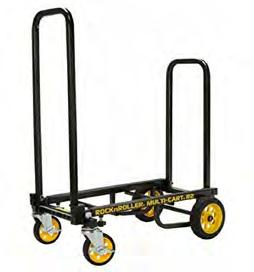
With a max load of 160kg, the RCR2RT will handle most equipment with ease, albeit sometimes with a few trips for those gigs where both guitarists need a full stack behind them.
OVERALL: The RC-R2RT Rock-NRoller Multicart is a great design and packs away while travelling or when it’s not being used, making it an easy purchase for anyone with equipment. Two or three handfuls of heavy gear can be compressed into one trip, and without doing your arms and back any damage loading into a venue before you’ve even set foot on stage.
Shure SM58

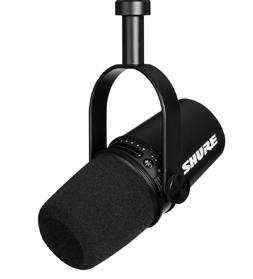
DISTRIBUTED BY: JANDS | ENQUIRE FOR PRICING
RECOMMENDED FOR: The most vigorous of singers, engineers, those who just love an iconic mic.
nosier environments. The included ShurePlus MOTIV software allows for some nifty fine tuning for voices and makes capturing a quality recording a breeze.
OVERALL: Based upon and inspired by a studio and broadcast classic, the MV7 takes many of the best parts of what makes the SM7B so wildly popular and brings with it a wealth of modern features creators of today will thoroughly enjoy. A go to for those wanting to step up their production and overall quality of microphone without blowing out the budget.
FEATURES: The near infallible SM58 is still, after decades of abuse still going strong in the live, studio, and touring spaces, Shure to be found (sorry, I had to) in nearly every corner of the earth where there’s a stage or a mic stand. Built like an absolute tank and not wanting to sound hyperbolic, but the SM58 can cop an absolute beating – so much so that it’s quite rare to find an older one still in service that doesn’t have its grille caved in, but yet, it still works like a charm. Classic! This legendary microphone really needs no introduction, but for those looking for some actual detail, the SM58 has a rather modest frequency response of 50Hz-15kHz, providing a natural roll off of subs and the tippy top, very handy when EQ options are limited. With a healthy midrange, nice amount of body in the lower mids, and a gentle presence boost
around 2kHz which rolls off around 10kHz, the 58 just sits beautifully in the mix.
OVERALL: You need not worry about this one taking a dive out of the Christmas hamper, try dropping it from a helicopter at 200 ft and see what happens. No, but seriously, that’s actually happened and it still worked. All joking aside, the SM58 is a classic for a reason and still one of the most widely used microphones around today.
40 mixdownmag.com.au PAGE HEADER GEAR GUIDE
KRK Rokit 5
DISTRIBUTED BY: JANDS | ENQUIRE FOR PRICING
RECOMMENDED FOR: Home studio enthusiasts, engineers and mixers on the go
FEATURES: The iconic yellow cones of the KRK Rokit studio monitor are synonymous with the studio, particularly that of the home studio enthusiasts, with countless pairs of this now wellknown monitor being the first pair of many an engineer – providing an affordable monitoring solution whilst still retaining solid frequency response and reliability as a whole. The Rokit 5 G4 is no exception and only but continues with the steadfast tradition of KRK’s most recognisable and familiar studio monitor family – with a few nifty updates to the design many will be sure to find appealing. With a full range frequency response of 43Hz-40kHz (huge for a 5” monitor), The Rokit 5 provides plenty of detail from bottom to top and everything in between, and with a max SPL of 104dB, they pack the proverbial punch! Connectivity is simple with balanced TRS/XLR combo jacks and an individual monitor weight
Audio-Technica
ATH-M50x
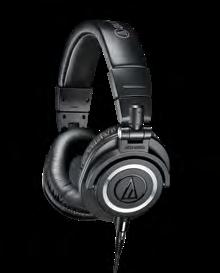
of 4.85kg, not backbreaking by any means, Where the Rokit 5 G4 really comes into its own though is in its powerful DSP engine, which plays host to a graphic EQ with 25 settings for helping integrate the monitors into less than ideal acoustic environments – aka the vast majority of home studios. This alone is a game changer in the studio monitor game, particularly at this price point.
OVERALL: The Rokit 5 G4 is an ideal solution for home studio environments and for those working on the go – this family of monitors have been a mainstayer in the industry and for good reason.
Universal Audio SD-1
DISTRIBUTED BY: CMI MUSIC & AUDIO | ENQUIRE FOR PRICING
RECOMMENDED FOR: Podcasting pioneers, content creators, singer/ songwriters, producers.
FEATURES: It’s always a treat when looking for a new microphone, whether it’s your first or fiftieth addition to the collection. When looking for something that can capture vocals or an instrument or two with accuracy can be tricky, and sometimes a condenser just isn’t the right tool for the job. A relatively new kid on the block, Universal Audio’s SD-1 is one of those once in a blue moon type of microphones that is both incredibly versatile and looks the part – particularly appealing for those using their microphone on camera. This broadcast-styled dynamic boasts a consistent cardioid polar pattern for great off-axis rejection, a flat frequency response of 50Hz-16kHz, and a switchable low cut filter and articulation boost for convenient tonal shaping. The built-in shock mount helps reduce low-end rumble and mechanical noises, whilst the built-in windscreens alleviates plosives and breaths – so
Gravity Absorber Pucks
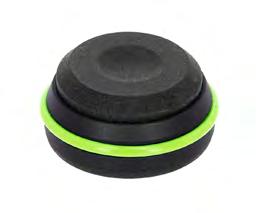
no need for additional pop filters here, phew! The rear-mounted XLR connector completes this elegant design – the SD-1 really does look the part. In typical UA style, the SD-1 is built to last and comes with some handy Apollo Channel Strip Presets to help get vocal and instrument sounds straight off the bat.
OVERALL: A wonderfully crafted dynamic microphone worthy of any recording setup, capable of accurately capturing a natural sound and nuanced detail of numerous sound sources with ease. A true studio companion inside and out.
DISTRIBUTED
BY: TECHNICAL AUDIO GROUP | PRICE: $319

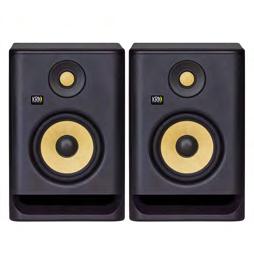
RECOMMENDED FOR: Professional musicians, producers and engineers who want a reliable, dependable set of monitoring cans for the studio and beyond.
FEATURES: With their sleek looks, comfortable fit, and incredible sound quality, the Audio-Technica ATH-M50x headphones are already an icon in the studio space, having served as the favoured closed back option for years, renowned around the world as being the most cost-effective cans for studio applications.
Audio is provided by a pair of patented 45mm large-aperture drivers, outputting a sound that’s incredibly nuanced and crisp, yet smooth and accurate for most mixing and monitoring applications. The wide frequency range of the headphones ensures that your ears will be treated to the highest of highs and the lowest of lows, while the soft cushioning that adorns the headband and earpads of the headphones makes sure that you won’t be left sore after extended periods of use.
But it’s the build quality and trustworthiness that are the name of the game here, with remarkable consistency in sound from one pair to the next and replaceable ear cups for regular studio upkeep, the M50x headphones are perfect for busy recording environments and live ensemble tracking, as well as being an absolute no brainer for anyone interested in podcasting or streaming.
OVERALL: A modern classic. The sound quality of the ATH-M50x headphones are already legendary, and the comfort and durability makes them a trusted acquisition for both work and play. One of the perennial controlled variables in the studio space, you literally can’t go wrong with a pair of AudioTechnica M50x cans.
DISTRIBUTED BY: LINK AUDIO
| RRP: $59 (FOUR PACK)
RECOMMENDED FOR: Producers, engineers, songwriters, mixers.
FEATURES: Do you know how much acoustic energy you’re losing through vibrations? While we might painstakingly reference our mixes hoping they’ll translate onto other devices, setting up your listening space is one of the most important things you can do as a producer or engineer.
Monitors and speakers are designed for flat playback, but some of that energy is transmitted to a tabletop or speaker stand and never makes it to our ears. Gravity Absorber Pucks prevent this, ensuring monitors and speakers have the best chance at playing back every frequency we expect them to by absorbing sound beneath our monitors before it rumbles through the floor and into the ether.
OVERALL: Gravity Absorber Pucks are a simple, stylish, and affordable way of improving your monitoring, something you’ll notice in
particular in the low mids of your mix now that the sound is moving towards your ears and not through your desk. The pucks are available in packs of four, and sit on the four corners of your monitors to prop them up off whatever surface they’re sat at. Your stereo image is more clear, concise, and accurate.
What’s more, four pucks can hold up to 36kg so you’d be hard pressed to find a monitor or loudspeaker that they can’t support. The Gravity Absorber Pucks are ready to be the smallest bit of kit you never knew you were missing.
41 mixdownmag.com.au PAGE HEADER
GEAR GUIDE
PreSonus Eris E5 BT Monitors
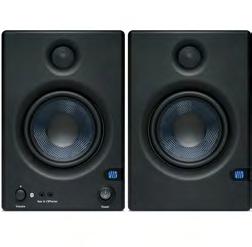
DISTRIBUTED
BY: LINK AUDIO
| RRP: $429 (PAIR)
RECOMMENDED FOR: Home studio hermits, content creators, podcasters, music lovers.
FEATURES: Having a reliable, honest, and accurate monitoring system is the proverbial backbone of any studio big or small.
PreSonus has always had a knack for manufacturing well designed and affordable products, as the Eris E5 BT monitors are no exception. These compact 5.25” monitors have plenty of guts with a peak of 112dB SPL (1 meter) and an impressive frequency response of 53Hz-22kHz. Wonderfully simple to operate, the rear panel of the Eris E5 BT provides simple low and high EQ controls centred at 100Hz and 10kHz respectively, balanced 1/4” TRS inputs, RCA unbalanced inputs, a sub output (for being used with a subwoofer), and simple +/- connectors for connecting to the other passive monitor. The bottom of the front panel are controls for power, volume, headphone output, and
RipX: DeepAudio
DISTRIBUTED BY: HIT’N’MIX | ENQUIRE FOR PRICING
RECOMMENDED FOR: DJs, beatmakers, anyone with a penchant for multitrack extraction.
FEATURES: In case you haven’t noticed yet, plugins and software have come a long way in recent years. Nowhere is this more apparent than in something like Hit’n’Mix’s awesome RipX DeepAudio, a professional stem extraction and audio manipulation tool with a host of nifty tricks up its sleeve. Featuring the same powerful AI Algorithms as the brand DeepRemix software, DeepAudio expands on DeepRemix’s ability to pull stems from fully mastered audio tracks, while also providing a host of additional editing and corrective tools to better perfect and prepare your stems prior to export.
The Harmonic Editor within DeepAudio allows you to manipulate the timbral content of your prerecorded material, while the ‘Draw Pitch’ function allows edit removal of notes within polyphonic vocal, instrument and percussion recordings, including Acoustic Guitar (which as many
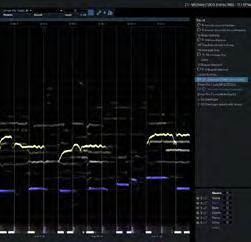
aux inputs, as well as the Bluetooth symbol. Having the ability to use Bluetooth 5.0 on a studio monitor such as this definitely expands the possibilities of their use, making them a perfect pair for not such studio users, but for general listening purposes and being able to be taken and used in other spaces with ease.
OVERALL: A solid entry-level monitor with great features and honest sound reproduction. A sure gift for those looking to get their first pair of monitors or for those just wanting a decent pair of monitors that won’t break the bank this season.
Imperative Audio Portable Vocal Booth
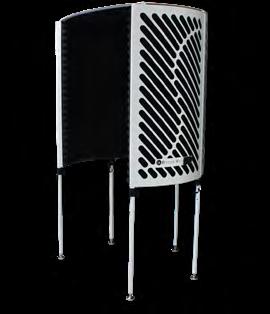
DISTRIBUTED BY: LINK AUDIO
| RRP: $3,499
RECOMMENDED FOR: Recording enthusiasts, home studio dwellers, podcasting mavericks.
FEATURES: Being able to properly record a solid, trouble free vocal performance whether it be for a podcast or broadcast voiceover, or singer (from the quietest to loudest of performer) can be a nightmare, particularly when working in less than ideal acoustic environments. Thankfully, Imperative Audio has created such a solution with the Portable Vocal Booth (PVB). Being able to reduce reflections down to as little as 0.07 seconds and providing up to -28.4dBa noise reduction, the PVB is highly effective in even the most unsympathetic recording environments. Often an issue with traditional gobos and other such acoustical treatment, height is set and non-adjustable, but the height-adjustable PVB allows for capturing seated performers (or even guitar amps) right up to 210cm at full height, keeping even the tallest of vocalists effectively
RipX: DeepRemix
DISTRIBUTED BY: HIT’N’MIX | ENQUIRE FOR PRICING
RECOMMENDED FOR: DJs, beatmakers, anyone with a penchant for multitrack extraction.
covered with headroom to spare. Its lightweight aluminium cylindrical design is easy to manoeuvre, and the three layers of acoustical treatment keep the typical standing waves and acoustical anomalies of traditional open vocal booths at bay. Folding down to a respectable and convenient size makes the PVB ideal for smaller home studios and voice over spaces.
OVERALL: Imperative Audio has struck a chord with multiple users with the Portable Vocal Booth – meeting, if not exceeding, the specific requirements of even the most demanding of vocal recording duties.
of you are probably aware, is a notoriously tricky task). Individual notes in a performance can be adjusted at the finest possible detail, and even be blended with other sounds, to provide you with an unprecedented amount of processing flexibility.
OVERALL: Equal parts corrective and creative, RipX DeepAudio’s revolutionary abilities as a one stop stem extraction and sound manipulation tool are second to none. Without question the cutting edge for this kind of processing. The RipX package may well be the most powerful and best suited tool for this kind of processing we’ve come across, I mean there is some serious voodoo going on here.
FEATURES: Oftentimes we hear something in a track that hits us deep in the cockles of our imagination and desire for creative endeavours but are stopped due to our inability to isolate multitrack recordings or individual tracks. Hit’n’Mix and their new RipX DeepRemix software introduces a broader set of tools primarily for separating audio files into individual vocal, bass, drum, and instrumental stems, useful for guitarists in a swathe of ways. If you’re struggling to find a good backing track to practise improvising scales over, just grab your favourite drum or bass tracks and keep them on loop, not worrying about the video starting and stopping and YouTube ads. Speaking of YouTube, enough with some tutorial guy’s take on a guitar part you’ve been dying to learn, one that you know deep down isn’t what you need, hear it straight from the source and check your accuracy that way. Better yet,
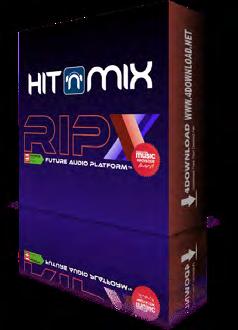
bedroom producers can get rid of the bootleg and scarce multitracks to drag in your favourite tracks, a la ESG’s genre defying instrumental masterpiece ‘UFO’.
OVERALL: Changing the game for sourcing guitar parts with a variety of uses. For over 10 years Hit’n’Mix have been on the forefront of refining this kind of technology and it shows in the attention to detail and impressive processing power of their latest offering.
42 mixdownmag.com.au PAGE HEADER GEAR GUIDE




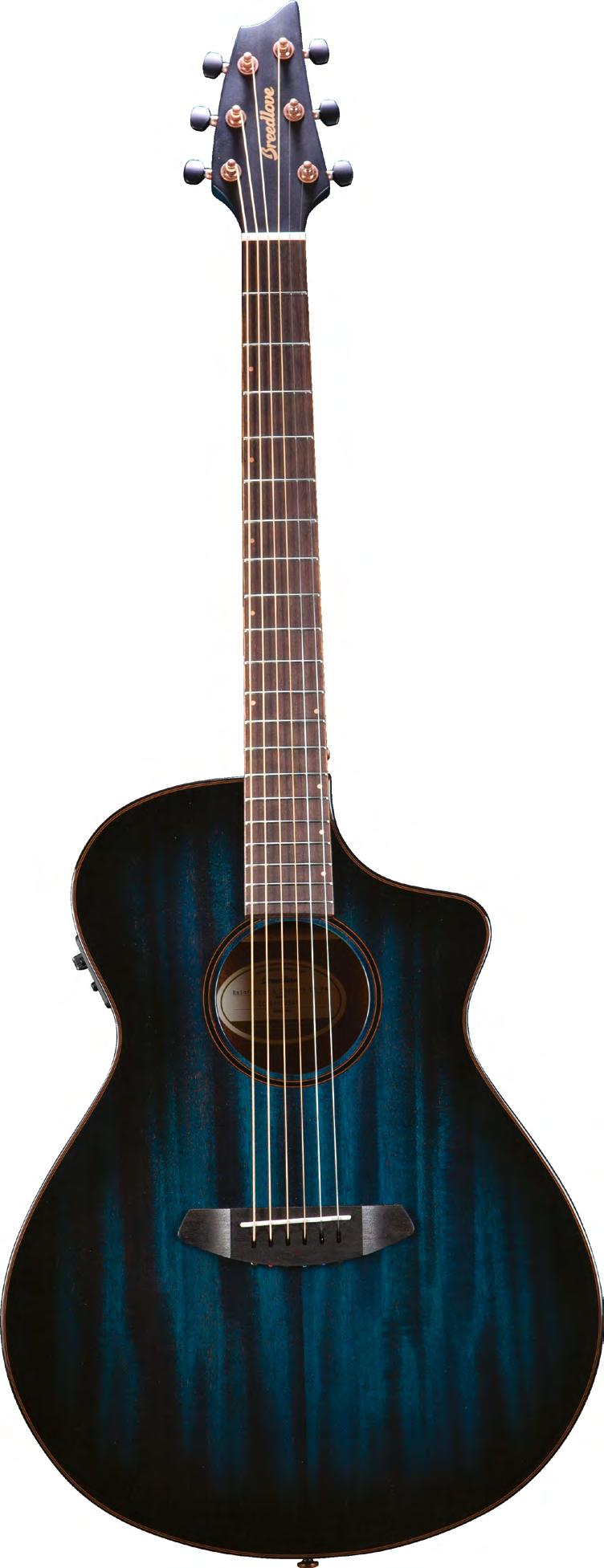












Zoom Q8n-4K
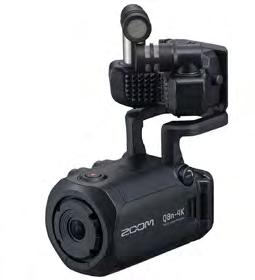 DISTRIBUTED BY: DYNAMIC MUSIC | ENQUIRE FOR PRICING
DISTRIBUTED BY: DYNAMIC MUSIC | ENQUIRE FOR PRICING
RECOMMENDED FOR: Musicians, indie filmmakers, podcasters, content creators, streamers
FEATURES: This compact recorder can capture up to four independent tracks of audio from its built-in X/Y condenser mics and two external mic inputs, while also capturing crystal clear video in 4K resolution through its F2.8/150º wide-angle lens, which features five field-of-view (FOV) settings. If the included X/Y mics aren’t quite right for the job, interchangeable mic capsules allow for a variety of Zoom mics to be used with the Q8n-4K, making various types of audio capture possible. The right look and light of a shoot is made easy with scene presets for indoor, outdoor, night time, and concert lighting, or by simply using the auto setting for optimised lighting based on the environment. Great for on-the-go shoots, the Q8n4K’s compact size makes either handheld or gimbal operation easy, while the included rechargeable Li-ion battery makes remote shoots hassle free, with the mini SD card slot able to hold up to a massive
512GB of data. Those wanting to directly stream high quality content to their favourite platform need not worry, as direct USB connectivity is possible, and the selfie mode of operation keeps all the essential details directly in front.
OVERALL: Those looking for a compact solution for capturing both high quality professional audio and crystal clear 4K video will find the Q8n-4K ticks a lot of boxes reaching the demands of most productions and sitting at a price suiting most budgets.
Making Music Production
Book
DISTRIBUTED BY: ABLETON | ENQUIRE FOR PRICING
RECOMMENDED FOR: Those in need of some creative production inspiration or who require an esteemed hardback on their coffee table.
FEATURES: There’s an infinite amount of resources that cover all the technical elements of music creation, ala how to use a compressor, EQ a vocal, create a send and return for a reverb or side chain and kick and bass, but few (if any) such resources cover the actual process of making music. In Dennis DeSantis’ “Making Music – 74 Creative Strategies for Electronic Music Producers”, the delicate, often frustrating and sometime even intimidating process music creation is thoughtfully broken down, where problems (or roadblocks) are presented, and accompanying solutions or patterns are laid out to help overcome these creative barricades.
This can vary from the starting of a project, bringing organisation to piles of existing material or providing solutions in completing
a project. What can be quite elusive concepts, Dennis breaks down in a clear and concise way, coming from decades of experience, learning and music creation.
Primarily aimed at musicians making music electronically with machines, this book provides real life scenarios that (it’s fair to say) all musicians will be related to in some way or another, opening up the conversation and delivering solutions for when the creative juices dry up and need a serious shake up!
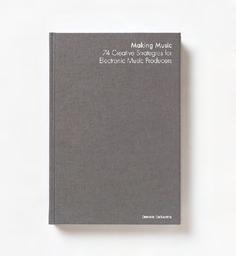
OVERALL: A well thought out, detailed and solution based read that is both informative and inspiring. A book for all musicians, but especially those who create electronically. Who doesn’t need a hardback to impress the guests.
Avid S1
DISTRIBUTED BY: INNOVATIVE MUSIC | ENQUIRE FOR PRICING
RECOMMENDED FOR: The primarily in-the-box DAW user who craves the tactility of multiple faders for mixing and automation tasks with lightning fast workflow.

FEATURES: The Avid S1 brings a sleek, elegant, and ergonomically designed compact control surface, boasting supreme build quality to be easily united into any DAW user’s setup. Featuring seamless control with instant physical and visual feedback, the S1 boasts eight hi-res motorised faders and rotary controls (assignable to control multiple parameters), OLED displays for instant visual feedback and matching colour coded buttons at the bottom of each fader to match track colours in sessions if so required.
There’s dedicated buttons for EQ, dynamics and more for quick operation, assignment and control. Mute, solo, and record enable buttons are above each fader allowing one to zip around any session without the need to jump for the mouse or keyboard. This not only frees users up to be more “hands on” with their mix, but
alleviates getting bogged down with arduous click and drag tasks. Those wanting to set up with a tablet can take advantage of Avid’s Control app, taking the tactile nature of the S1 to new heights with even deeper integration and gorgeous visual feedback.
OVERALL: A truly versatile compact control surface, the Avid S1 offers unparalleled hands on control over a DAW session (with particular attention to detail in Pro Tools), allowing users to utilise and customise the many physical elements of this professional control surface, enhancing workflow and speeding up hefty mix sessions.
Sound Particles Space Controller plugin
DISTRIBUTED BY: SOUND PARTICLES | ENQUIRE FOR PRICING
RECOMMENDED FOR: Immersive audio mix wizards, virtual and augmented reality necromancers
FEATURES: Who doesn’t love remote control panning of a sound source with your phone. Wait. What? Hold the phone! Yep, you heard. For those at all familiar with immersive audio plugins and workflows will feel instantly at home within the UI of Space Controller, with Cube mode for a more traditional layout and workflow or Sphere mode for full blown 3D immersive workflows such as Ambisonics and VR. Within the plugin, channel control ranges from a single mono sound source through to controlling multiple channels simultaneously, being able to move entire sound fields seamlessly with incredible accuracy and smoothness. The accompanying app is where Space Controller really takes off, with remote control panning from a connected phone iOS and android compatible via Bluetooth or Wi-Fi (in the studio version featured here). Multiple devices
can be connected simultaneously, breaking the creative bounds of immersive audio completely, for seamless positioning of things like Dolby Atmos objects, all of which can all be written and automated to the sound source/s within a session.
OVERALL: This plugin and app have earned some serious kudos from pros in the immersive space and for good reason, the overall level of control, accuracy, and endless creative possibilities make this a must have for those working in the immersive fields but also for those who want to explore the boundless creative panning possibilities simply within the stereo realm as well.

44 mixdownmag.com.au PAGE HEADER GEAR GUIDE
Specially designed to meet the needs of content creators, the new AT2020USB-X is the perfect plug and play microphone for streaming, podcasting, recording music, gaming and video recording. Featuring the critically acclaimed, award-winning sound of the AT2020 with the convenience of USB-C operation, a heavy duty desk stand and a convenient touch mute button with an LED indicator.







TOUCH CONTROL MUTE WITH LED RING ZERO LATENCY MONITORING WITH VOLUME AND MIX CONTROLS SECURE HEAVY DUTY DESK STAND USB-C CONNECTION WITH HIGH-RESOLUTION A/D CONVERTER STUDIO QUALITY AUDIO AT2020USB-X Cardioid Condenser USB Microphone
Studio Logistics 101: Capturing Drums on a Budget
Speak to any recording engineer worth their salt and they’ll likely say that one of, if not the most challenging instrument to record in the studio is a drum kit.
To many, this isn’t exactly a news flash, but for aspiring engineers, the thought of recording a drum kit can strike as one hell of a daunting task! Not only the technical requirements of the task itself, but the sheer amount of microphones required to adequately get the job done.

This often requires a decent upfront investment into one’s mic locker. What’s more, with the near endless amount of microphone choices available in 2022, it can be even harder to know what mics to choose for the task. ‘Do I go with individual mics? Do I go with a mic pack, or a combination of the two?’ These are just a couple of questions likely to crop up.
With so many end of year sales happening it’s a tactfully advantageous time right now to flesh out the ol’ mic cabinet and knock over drum kit logistics in one fell swoop, so let’s take a holistic look at some ideas surrounding drum recording, and the ways in which we can use these sales to our advantage, as struggling musicians on a budget.
While it’s often helpful to look and think of the drums as one instrument in the context of a song or a mix, there are undeniably multiple elements at their core, that work in unison to make up the final sound of what we know as recorded drums. While the old one-mic technique can work in some circumstances, the typical requirements of modern music productions benefit greatly from having the ability to manipulate and process individual tracks, these being the various elements –kick, snare, toms, cymbals, and so forth. But what elements are most important and what mic is going to be best suited to recording each unique sonic requirement?
Taking the kick drum as an example, conventional wisdom tells us that a microphone capable of accurately reproducing low frequencies is going to be quite beneficial and this is true for the most part. However, like so much in recorded music, this isn’t necessarily gospel, but more just a general rule of thumb. The requirements of the production and the track should always lead
the decision making process, and sometimes the trusty Shure SM57 can work wonders on a kick drum if you are after a particular flavour! But I digress. A dedicated kick drum microphone is at its core, a staple to any microphone locker. Even if you are tracking bandpassed, vintage sounding drums, there is always an arrangement that will come along that simply cannot do without some legitimate low end in the kick to make it sing. As a rule of thumb, a kick mic is an integral part of any mic locker. Thinking outside of the kick drum for just a second here too, more often than not, this low-frequency-capturing mic is going to find its way onto other sound sources too, say a bass cabinet for example.
There are aeons of options superbly suited for recording kick drums, many of which attract a pretty penny, but in keeping with a modest budget it’s hard to go past the Shure PGA52. You can find them on countless live microphone kits and for good reason, the PGA52 does a remarkable job of capturing the essence of a kick drum, particularly for the price point. Factor in the various discounts and promotions happening this time of year and these are an absolute steal,
especially as a first kick mic. For those looking for something with a bit more of a premium capture, the Beta 52A continues to be one of the most popular kick mics of the last 20 years and is ideal for anyone looking to add legitimate weight to their kick sound.If the budget only allows for one mic to capture the kick, this industrystandard mic is more than enough to keep most out of trouble and serves as the perfect gateway into drum miking. A simple mono overhead and inside kick setup, can be perfect for anyone trying to lay down some scratch drums for a demo.
Arguably one of the most important elements of a drum kit (and inherently recording a drum kit), or any song for that matter is the snare drum, it’s the backbeat and one of the most important cultural signifiers at the production level. More than any other source, nothing dates a song more quickly than the wrong snare sound, so it is a source that we are no doubt going to be tinkering a lot with at the mix level, so capturing it correctly is of the utmost importance.
While the arguments of ‘what snare mic is the best’ are a common thread throughout the audio blogs of the world
46 mixdownmag.com.au
wide web, it’s often best to not unnecessarily complicate things. It’s often comical how some pieces of music gear become so synonymous with particular instruments. Much like how many believe the Neumann U47 is the only vocal microphone, the Shure SM57 has earned its similar standing for snare, only it doesn’t cost upwards of $20,000. In fact it’s still one of the most affordable microphones on the market even at full retail pricing, let alone at this time of year. As a snare mic, the SM57 is just so hard to beat and for countless engineers, is one of those desert island microphones that no engineer should be without. Same goes for guitar and on toms. Hell, there’s records in existence that were recorded exclusively with SM57s.They just work.
Another key logistical takeaway in regards to the SM57 for snare is that if we were looking to mic for snare on both the top and the underside bottom, this will require two microphones, and it can be advantageous to use the same model for both for the sake of symmetry and consistency at capture. This means that we are going to have to think about an investment that is both reasonably priced and easily replaceable in the event that we break/lose one. In the world of pro broadcast this consideration is commonly referred to as redundancy, and the SM57 is the ultimate redundant microphone option. They are plentiful, consistent from one model to the next, and can be acquired quickly without derailing a session.
So we’ve covered kick and snare and we’re only up to two (maybe three) mics so far – and the budget hasn’t been completely blown out of the water. In keeping with simplicity and budget, let’s look at overheads. Depending on the amount of microphones being used overall, choice of overheads can vary a little, as some will be using these as an overall picture of the drum kit type of perspective, while others will prefer the overheads to serve more of a cymbal-specific purpose. Regardless, a small diaphragm condenser is a great place to start for overheads, providing a nice amount of detail and clarity. This isn’t to say a trusty dynamic or ribbon microphone won’t have their respective places here, but a go to for many is hands down a condenser.
As for affordable small diaphragm condensers, the Shure PGA81 is a tried and true workhorse, with an even, flat response and robust build quality. What’s more, a mic like this will certainly cover numerous other recording tasks such as acoustic guitar and percussion.
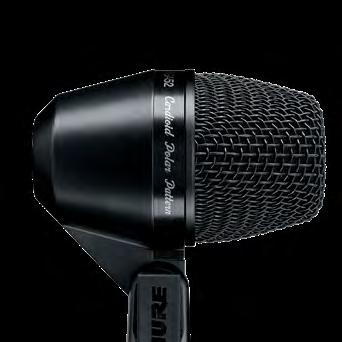
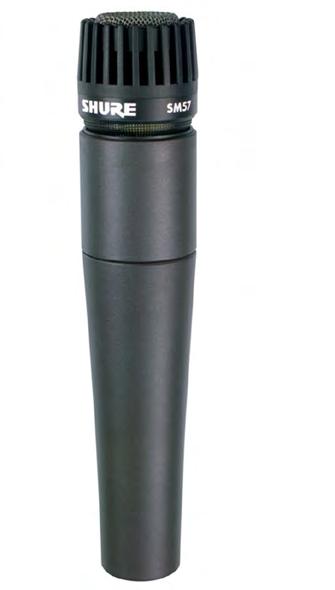
While we could certainly get away with capturing a solid drum sound with the four mics mentioned above, having the option of individual tom mics isn’t going to hurt. If you’re keen to commit to including tom mics in your mic locker, as well as the aforementioned individual mics, that’s awesome! And while you can find a ton of individual options out there for all of these, finding a dedicated mic pack is going to save a bit of coin in the long run.
If just a few mics such as kick, snare, and overheads is going to keep you out of trouble, something like the Shure PGASTUDIOKIT4 will absolutely do the job! But for those looking to go the whole hog, (not forgetting most of the mics in a dedicated kit will also cover other recording tasks), something like the PGADRUMKIT7 pack will provide ample options, with mics for kick, snare, toms, and overheads all included, with relevant clips, cables and a carry case to boot!
While these are certainly just some starting points for getting the job of recording a drum kit done, expanding out into more specific microphone territories is never a bad thing, but when working within a limited budget, the options mentioned above will certainly keep the mic locker full, without the breaking bank. And with that – happy mic hunting!
If these mics and setups pique your interest, Jands are currently running the Shure Instant Savings promotion which includes all the aforementioned mics and a whole host of lauded and famed recording mics at ridiculously good prices. Check in with your local audio or musical instrument store today and kickstart your drum recording setup while the getting is good!
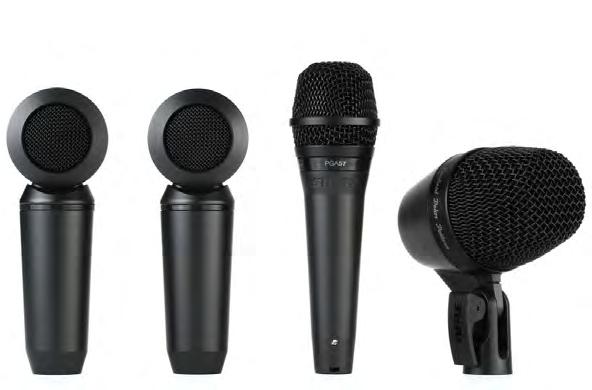 BY ANDY LLOYD-RUSSELL
BY ANDY LLOYD-RUSSELL
47 mixdownmag.com.au
Ergonomically Challenged
I have a problem. Besides the obvious jokes my brother could not resist throwing at me if he heard me make a statement like that, the truth is I’m a drummer (okay, walked into that one) and unfortunately, it seems my body is telling me I have issues.
I’m a 41-year-old Italian and a bit of a fan of the ol’ carbonara so to speak and thus, I’m carrying a few extra kgs than I’d like to – lockdowns anyone? But recently, I just can’t get comfortable on the instrument. Oh, and everything hurts.
MY OWN WORST ENEMY
I teach full time, I’m the head of music at a school and I gig whenever I can, perhaps on average around two gigs a week. My nights are usually taken up with being a Dad and then, being on the couch, completing school work, or something related to running the music program at school before it all starts again. It’s pretty flat chat most of the time and results in not that many weekends off. School holidays bring some relief but then, that just means I’m more available for gigs and somehow, I fill up the time.
I’ve had my fair share of back pain and in the last few years, some non-heart related but nevertheless, hurty chest and upper body pain. I’ve seen many practitioners about this and despite some mild relief here and there, I’ve never been able to fully get on top of it. I’ve also had some tendinitis issues in the hands, which really caused issues. Now, please don’t get me wrong – not looking for the pity party here but perhaps, there’s a correlation with another issue. Lots of people might even have had similar issues so let’s suss it out.
TERRIBLY VEXED
Here is a perplexing and somewhat annoying thing. I’ve played drums for a lot of my 41 years and while I’ve experimented with set ups, angles and so on, suddenly, I can’t find a comfy set up. Like, I’m constantly unhappy with how the drum kit feels now. Mid-gig I will often find myself lowering or raising my seat height to alleviate back pain and subsequently, doing the same for the snare – making it higher or lower to compensate for the seat movement, angling it towards me, laying it flat, raising the hi-hat to match etc.
The theory might be that sitting a little higher can take pressure off the back, but then I noticed some increased strain in my chest, shoulder blades, aches etc. Sitting lower felt better for my upper body but then I was getting pins and needles in the ol’ gluteus maximus. Another reason for wanting to sit higher is because I’m a tall guy and my legs simply get in the way of my snare. However, raising the snare drum puts my wrists at a different angle and then I’ve been getting pain. Die cast hoops on my snare drums are a consideration too when changing angles as rim shots can actually hurt if not comfortable. Regardless, I feel like it’s a total cluster and I’m confused as to why I can’t find a set up that ergonomically works for my body and allows for some pain free playing.
PERHAPS, PERHAPS
Some people reading this might just say I’m as weak as a certain type of liquid and I should harden up. And, I suppose to a degree, that might be true. We can all do with being stronger, healthier etc. But also, I’m not playing super hardcore, demanding drums here. I get these issues at a jazz gig. But perhaps, there’s something to be said for not being aware of ergonomically bad set ups in my younger years and now, things are catching up with me. Not necessarily saying that that is the only reason. Work desks and other activities could be a major factor too, but I play drums a lot. Another issue is the weight of the instrument and the constant loading/setting up/down cannot be ignored and there is definitely an argument for having lighter hardware and smaller, lighter drums. Or, picking the kit that will get the job done the majority of the time and saving the big gun drums for the gigs that really require it. Perhaps, the seats in my sporty hot hatch aren’t doing me any favours on long trips. Perhaps, working all week and then smashing gigs is also a factor, and just maybe, my body is cracking the barneys and telling me to chill out a bit. Perhaps, perhaps.
MY HIPS DON’T LIE?
In reflection, it seems that the body doesn’t lie and when it comes to playing drums, being aware of how your set up is affecting your body, regardless of how great your technique is, should be a major factor when learning and when performing regularly. And consideration for

gig-friendly gear that ultimately puts less strain on you between set ups makes sense. Yamaha for example, makes lightweight aluminium hardware and hip gig kits with shorter shell depths. Other companies also offer solutions to the big drum kit. Considering I always mic up a part of my kit, perhaps, the impact on sound won’t be as drastic as I think and perhaps, something I can live with in lieu of my beloved Ludwig. The punter demanding I play ‘The Horses’ probably doesn’t really give a toss if my bass drum is a 14” depth or an 8”. There’ll still be room for the vintage kit at gigs from time to time too, I’m sure.
So, do I have a solution to my problem? Well, not in the short term. I need to address the body aches and pains and see how I can adapt my playing to compensate for the time being. Then I can look to ergonomically satisfy my set up needs on the drums and potentially look to use some different gear in the process of making this happen if necessary. Regardless, it certainly got me thinking.
BY ADRIAN VIOLI
48 mixdownmag.com.au COLUMNS
PERCUSSION

To Model or Not to Model?
Modelling, profilings, and tone capturing in the guitar world is everywhere now.
Even those sacred tone junkies are at least aware of the concept and indeed some have jumped on board in some form to see what all the fuss is about. In a great example of harnessing technology for the good, the concept of modelling, capturing, recreating, or producing something similar to existing amplifiers, cabs, and effects in the digital realm has really shaken things up. No longer do you need to lug a head and cab or a seriously overweight combo to a gig. You can plug in a modeller and send it straight to front of house if you desire. And, this isn’t just for the rich and famous or even the advanced guitarist. Compact, cost-effective solutions are everywhere, from your big name brands down to the cheaper entry-level-type offerings.
While many guitarists are hesitant to take the plunge (and often most of them are just holding onto their ‘vintage is better’ mindset without any real justification or evidence to back it up), modellers are seemingly everywhere now. I’m not saying that modelling is the same deal as cranked amps or your favourite amp as you know it in the perfect setting, but modellers have so many positives that you almost
can’t ignore them. Many of the initial arguments against modellers (they’re too hard to program, or you can’t adjust them on the fly, they don’t sound like the amp in the room etc.) have been usurped with the ability to route the effects chain, send different settings to both the front of house and your cab/in ears, and then the ability to record seemingly anywhere with access to a massive array of tones that can be done with headphones and a laptop. This accessibility has really brought the modeller into the popular world. The dream of owning a boutique head (or several!) can be overcome with some modellers that will hopefully get you in the ballpark for a fraction of the cost.
While super high-end rigs used to only be the world of big time touring bands and guitarists, nowadays those mega stars often use modellers… but so does the cover band at your local pub. The fact that you can take this digital rig to any venue and have your same setup and sounds can really save time and save the headaches of having to tweak like crazy at the gig. Now don’t get me wrong, I love tube amps and have owned many (and still do). Furthermore, I
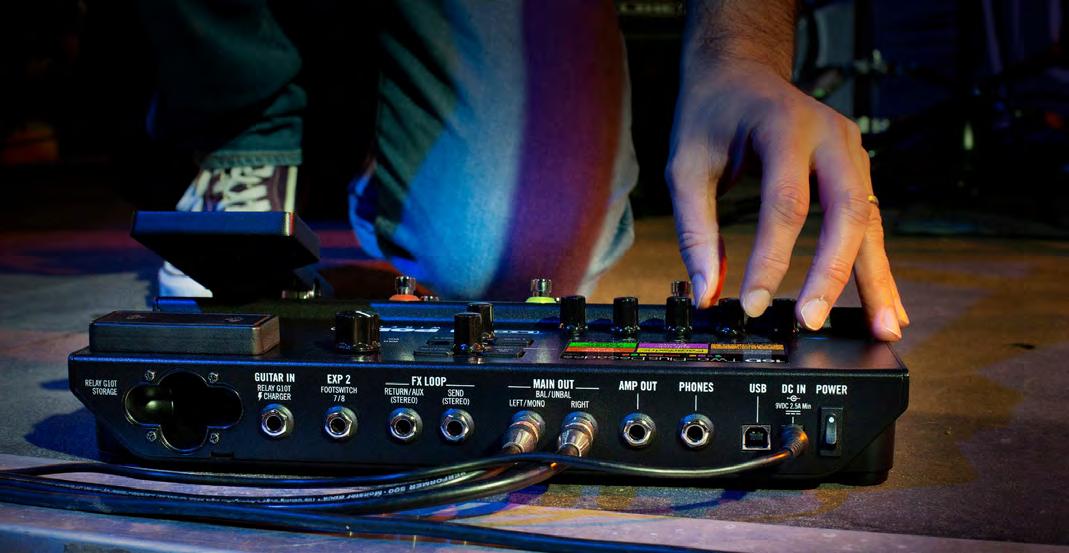
love pedals and still have a sizable collection and use them often. But, sometimes I still struggle with things sounding drastically different in different rooms, and it depends on where I’m standing, how hard the drummer is hitting, whether I’m wearing earplugs and so on. Whereas, with a modeller and flat range powered cab, my tones are essentially the same no matter what the room. And while you still might have some of the same ‘can’t hear myself as well as I’d like to’ issues, you are somewhat comforted by the fact that you know exactly how your rig sounds. Making the jump into a modelling rig is sometimes the hardest part. And to be honest, all the (often uninformed) discourse you read on guitar forums and the like makes it seem like some big crazy initiation that is going to take you years to master. For mine, it’s no different to getting a new amp or getting some new pedals that you’ve gotta tweak and get accustomed to. And, you have got options. You can buy a modeller and choose to just go directly to the front of house (and maybe get yourself some in ears or a decent foldback monitor). You can run your modeller into a power amp and guitar cab to try and keep some of the real guitar rig mojo. I’ve settled on a modeller, small power
amp, and passive cab which gives me some flexibility in controlling the onstage sound while having the ability to give front of house a consistent and controllable tone that essentially stays the same each gig.
While I won’t be selling any of my amps or pedals any time soon – if you’re on the fence regarding modelling, I’d recommend giving it a go. Even if it’s just for home playing or recording or rehearsing. The access to sounds that I’ve always wanted but typically wouldn’t be able to afford, or get, let alone have all at once in one rig is really amazing. And, then the flexibility of controlling it how I want makes it so flexible and powerful.
BY NICK BROWN
50 mixdownmag.com.au COLUMNS GUITAR
Bass Check: Boutique vs. Off The Shelf
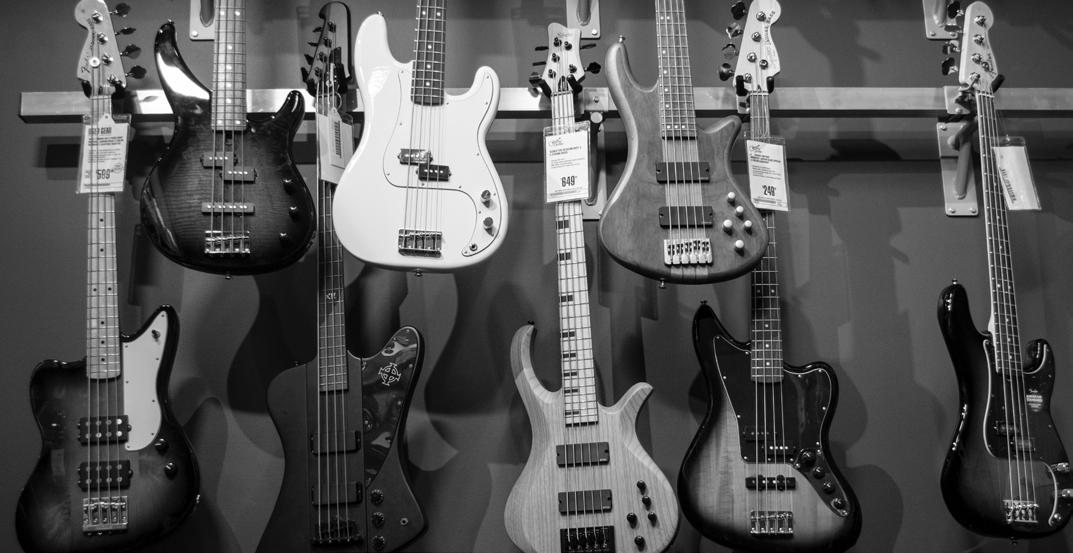
Options in woods, electronics, body shape, scale length, colour, plus more means you have more choice than ever in regards to getting the instrument you want. But, what are you really getting when you buy something standard off the shelf (be it online or from your trusty local store) as opposed to ordering something possibly more individual from a boutique builder?
Firstly, one point to keep in mind with this situation is that the definition of boutique is slightly interpretive and will vary depending on who you ask. For some this will mean something (or anything) above your typically standard price brand or instrument. For others it will have to be something completely handmade and individual with features, finish, custom work that is above your standard instrument. Just to blur the lines further – a staple of many big volume builders nowadays is the ‘custom shop’ where you can order different personalised specs, although these options are sometimes finite. Either way, these lines are often considered boutique, especially with the amount of customisation
you can order. On top of that, some companies (that may be slightly pricier than your standard instrument maker) offer both production instruments and the possibility to customise your order as much as you like, albeit for a higher price tag. Of course, you then have the truly handmade, fully customisable builder that will entertain all of your requests – often working solo or in a small team.
So, essentially ‘off the shelf’ has been around since the inception of the modern electric bass and it has therefore definitely stood the test of time. It’s interesting to think then that the highly revered vintage basses these days that go for huge dollars weren’t originally produced or intended to be super pricey and anything above and beyond a solid production bass. Many of the tones we know and love, and indeed the players that were creating these, have used off-the-shelf Fender, Gibson, Hofner, Rickenbacker instruments and so on.
Quality control is a term that often gets bandied about when discussing brands that produce higher volumes of gear. Realistically though, production methods, processes, and staff knowledge and resources have improved out of sight and on the
whole, you’d have to think that quality control is most probably better than ever (and more consistent). When looking at buying an off-the-shelf instrument, the fact that you will most likely be able to actually play the model you are after along with any variations to compare and contrast is a big plus. This then gives you a great indicator as to what the instrument would be if you go through and purchase it. Known brands will typically be reliable, still offer a range of finishes, and have good resale value if you ever need to move it on.
From the boutique camp you can order Sadowsky, Suhr, Sandberg, Fodera, Mike Lull, and so on who offer handmade instruments and range from a one or two-man operation up to more substantial factory and workshop setups with more employees. If you go with a company along the lines of the ‘somewhat customisable’ instrument, then you’ll be getting the backing of an established brand, just with some specs that are more suited to yourself. You can then factor in the company reputation, availability, build timeline etc. Want some crazy inlays, different scale length, colour, and customised electronics? Truly handmade smaller shop builders will often be
able to offer more scope in terms of specs to really hone in on your wants, but the timeline might be longer, the price might be higher and there might be less room for any adjustments or changes along the way. Once it’s locked in, it’s locked in. Still – you’re getting all those specs you’ve always wanted! Which route do I go then? There is no right or wrong, and like your tone journey so far it might take multiple instruments to really work out what you want/like/ need. Many players have never journeyed into custom land and never need to. For a lot of people, the customisable option from a bigger name builder is often the best choice as a starting point for getting an idea of what might be possible and if it really suits them. Others are happy diving straight into the super handmade, customised path.
While it might seem overwhelming at times, we really are lucky to have such an array of builders and options these days be it entry level instruments or those at the $$$ end of things.
BY NICK BROWN
51 mixdownmag.com.au COLUMNS BASS
You can pay $200, $2,000, or even $20,000 these days for a bass.
Room with a View: How DSP-Based Acoustic Correction is changing our sonic perception
When it comes to modern audio production, the medium is the monitors.

It’s the lens through which we make every important decision through the tracking, mixing, and mastering stages, while also playing a vital role in the way these decisions translate to the outside world.
Where things get increasingly complex is in the ways in which our monitors interact with our listening environment and the unforeseen impacts that this can have on our sonic perception and decision-making process – with the the introduction of various acoustic nasties such as standing waves, bass buildup, phase smearing, and more, all impeding our ability to make valid judgements at the production level.
Thankfully though, there are solutions at hand, and with DSPbased room correction becoming both more accessible and more effective in recent years, there is now no reason why engineers of any pedigree should be flying blind.
In this article, we take a closer look at three different approaches to DSP-based room correction, to suit any budget.
The ARC System provides a great entry point into acoustic correction, with a straightforward system that suits both beginners and pros. So if you like the stepby-step assisted approach, you can quickly analyse your space and create a profile to reduce acoustic problem areas.
Alternatively, ARC also has more detailed features for those who have prior experience with room correction. These include a variable band corrective EQ with high and low range controls that
allows you to adjust the resolution. In addition, there is PEAK, RMS, LUFS and DR metering, a real time spectrum analyser, as well as virtual monitoring presets with emulations of car stereo, TV, and smartphone speaker systems for reference.
Practically, ARC functions as a plugin within your DAW. When placed on your master output channel, you can quickly access metering and reference presets. This is convenient, as most home users are working with limited budget and space, so the idea of having three sets of monitors isn’t always a realistic prospect.
The ARC System is available in three different options. You can purchase the software alone and use it with your current measurement microphone, you can get the complete package with the MEMS microphone, or simply purchase the mic separately as a current ARC user.
Overall, the ARC System provides an affordable solution with multi platform compatibility that is suitable for anything from home recording setups to more professional studios. So whether you’re aiming to increase the translation properties of your current system or justify your investment in more high-end studio monitors, this gives you a simple way to do it.
The iLoud Precision range consists of three models of digitally controlled studio monitors. With the help of the X-MONITOR control app, you can calibrate your monitors specifically for your room and access a library of monitor emulations ranging from studio and Hi-Fi to multimedia speakers.
Choose between a 5-inch, 6.5inch, and a dual 5-inch class-D powered monitor system with a 96kHz integrated DSP engine. Each model ships with the MEMS microphone and a set of iLoud acoustic isolation pads to reduce reflectivity and vibrations. Once you’ve set your iLoud Precision monitors up, you can begin calibration with the X-MONITOR software.
Although the rear control panels have extensive EQ controls, the software provides a comprehensive control system for calibration, selecting and fine tuning monitor presets, and making manual EQ adjustments. In addition, you have the convenience of cycling between monitor presets with the optional remote.
Before you get into the virtual monitor preset library, there are four basic settings to start working with the iLoud Precision monitors immediately. Each is designed with a specific practical application in mind.
Sure, there is plenty of competition in this end of the market, but the key to approach the iLoud Precision is to approach them as a “budget barefoot” introduction to the advanced world of onboard DSP, as opposed to a mid-level monitor with a few plush features.
As a way to pull accurate mixes early in your production journey and offset the inhibiting aspects of your listening environment on a budget, you’d be hard pressed to find anything better suited to the task.
DSP-based designs also have the potential to take high-end monitoring to new heights. Rather than simply compensating for acoustic weak areas in a room, the Dutch & Dutch 8c studio monitors
are designed to complement your studio’s room acoustics and provide the means to create engineer-specific monitoring profiles.
The 8c is a uniquely designed three-way monitor with an eight-inch forward facing midrange driver, and two eight-inch rear-mounted high excursion subwoofers. They can be pole, ceiling, wall, or stand mounted, and connectivity includes AES with support for up to 192kHz sample rates, and an ethernet for linking the app and configuring the DSP.
The unique cardioid dispersion system is aided by the grills on the side panels, and this reduces the off-axis filtering that we usually associate with even high-end monitors when we change our listening position. Instead of colouration, you get full spectrum attenuation which results in more neutral reflections.
Besides customised EQ correction, the software controls the low frequency levels when you specify the distance between the rearfacing drivers and the wall. This is the key to the overall sound of the 8c and allows them to perform in any room, should you have acoustic treatment installed or not.
What makes the 8c a worthwhile investment is the manner in which it can so easily adapt to new spaces. Most of us will move studios several times in our careers, and having a monitor system that is designed to adapt so intuitively to any environment makes the process a far less daunting prospect.
BY STEFAN WYETH
52 mixdownmag.com.au



©2022 JCMI. Jackson ® and Soloist™ are trademarks of Jackson/Charvel Manufacturing, Inc. All rights reserved. JOSH SMITH PRO SERIES SIGNATURE SOLOIST ™ SL7 ET
Impact LX Mini
When I was approached to review the Nektar Impact LX Mini, I’m not going to lie, I was like, meh. Yet another backpack keyboard controller. At the risk of sounding cynical, I was thinking, “Let me guess, you can play drum pads, some transport controls, and the ability to launch clips in Ableton!” So, with some considerable surprise, I’m now looking to retire a couple of said keyboard controllers and embrace the new kid on the block. The question I’m sure you’re all asking is “why?” So, let’s dig deep and see what the Impact LX Mini offers.
Nektar is an American-based company with a unique goto-market strategy. From their website, Nektar’s aim is to, “Bridge the gap between powerful music software and controller hardware”. Don’t expect a host of software instruments and plugins that often shift with similar products. In addition to the keyboard controller and a driver installer, the only other inclusion is an eightchannel version of Bitwig Studio.
The Impact LX Mini is a classcompliant USB device but if you are looking to use it with Ableton Live, the driver is required for both Windows and Mac OS X. In my testing, I used an M1 Mac and Ableton Live Suite 11, but support is provided for all of the major DAW players. (I’m very interested to check out the Avid Pro Tools integration but at the time of writing, am yet to do so).
Set up is relatively simple and the documentation is clear and concise. I tried to jump straight in,
but didn’t get far. You definitely need to reference and read through and follow through the documents. It’s pretty simple so don’t worry too much. A Max for Live device offers further control functionality, but this is only compatible with Ableton Suite 11 with Max for Live installed. For full compatibility, check the product site.
The hardware build quality is great and the keys, featuring four velocity curves, feel responsive and provide an impressive dynamic range. Overall, the design aesthetic is utilitarian rather than minimalistic, with a good deal of printed text across the unit to help users navigate the controls on offer. Think workhorse, not show pony. Within the small form factor, Nektar has managed to jam in lots of controls: 25 keys, eight pads, nine encoders, one joystick for pitch bend and modulation, 19 dedicated control pads, and a sustain pedal port. Clever design allows Shift and Page buttons to provide multiple functions to these control pads, further expanding the available functionality. To understand the dizzying array of controls on offer, again, the manual is definitely essential. The actual keys are a little smaller than similar units, but I didn’t find this an issue during testing.
In use, the power of the Impact LX Mini quickly becomes evident. Transport, metronome, and looping controls are all available, but I was shocked to see that the unit provides functions lacking, even on Ableton’s Push, but

more on that later. By tapping or holding the Shift button, each of the control buttons takes on two further functions. The actual function of each button, FFW, REW, PLAY etc. is printed on the unit. Standard functions are in white text and those accessed using the blue backlit Shift key, are in blue.
Go to Clip View and another to bring up the Browser. Once there, presets can be auditioned, and loaded. Nice! The large encoder provides volume control of the channel that is currently being selected and by holding the Shift button, the encoder controls the master volume. Arrow keys allow navigation across the Live Set to select individual channels. If you are using the Max for Live version with Live Suite 11, an option exists to auto enable record on the channel.
One strange and glaring omission in Ableton Live, and by extension Push, is dedicated fast forward and rewind buttons. For most uses this isn’t an issue, however, if you are editing a long looping section with more than one clip selected, you have to listen to the entire loop from start to finish, even if you’re just tweaking notes at the end of the loop. There’s no way of fast forwarding or rewinding without using the mouse to click into the interface and doing so will deselect the clips in the process. This may seem small, but it has been a constant frustration of many for a long time. This, paired with FFW and REW buttons, makes the unit very attractive. On
the topic of looping, the Impact LX Mini allows you to set start and end points and turn looping mode on and off, all without needing to touch the mouse.
All of this barely scratches the surface of the functionality of Impact LX Mini. There is so much more on offer. The actual keys have secondary functions that can be accessed by holding one of the Part Two buttons. Doing so can change MIDI channels, layer an octave on top, or below, shift octaves up and down. The price is a little over $250 so it offers excellent value and adds significant workflow improvements. So, if you are in the market for a pintsized powerhouse, it’s well worth a look.
BY GREG LONG
54 mixdownmag.com.au PRODUCT REVIEWS / MI
NEKTAR
SOUND AND MUSIC | PRICE: $269.99
Fender bass amps have been a mainstay on stages since the ‘50s when Fender literally invented the electric bass. Bass itself has evolved greatly over that time and so have the sonic demands of players, and Fender has kept an eye on those changing trends with all sorts of innovative amps incorporating modern features and flexible tone options. The Rumble 800 is a relatively affordable amplifier which aims to place this research and development into a modern, player-friendly form factor that maintains that classic Fender aesthetic. Let’s have a closer look.
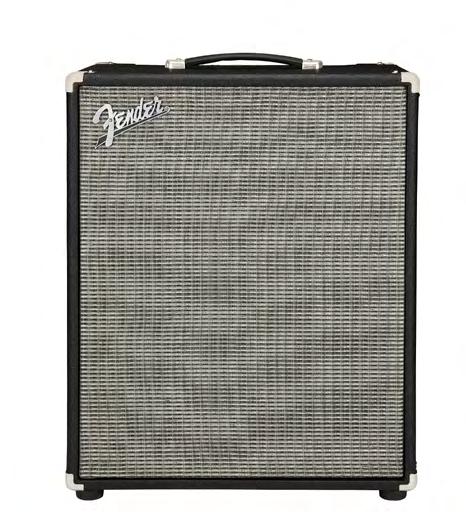
The Rumble 800 is an 800watt (you read that right) Class D combo – a head version is also available – with two custom-designed 10” Eminence Neodymium speakers and a highfrequency horn in a black vinylcovered enclosure with a silver grille cloth. As a solid state amp it’s incredibly light and portable, coming in at 13.15kg. I’ve carried bags of dog food to the car that were heavier than that. Many of us would be able to tramp upstairs with the Rumble 800’s carry handle in one hand, a pedalboard bag in the other, and our bass in a gig bag on our back for a singletrip load in.
The preamp has three voicings – bright, which naturally adds a bit of treble brilliance to the tone; contour, which offers a focused mid scoop for slapand-pop and more hi-fi modern sounds, and vintage, which is voiced to replicate a classic tube amp sound. The preamp is fed by an input gain control which is separate to the selectable overdrive circuit, governed by drive and level controls. Think of it as a transparent overdrive pedal built right into the amp. There’s a four-band EQ with bass and treble controls sandwiching low-mid and high-mid knobs. The master volume control is accompanied by a full/low output switch for bringing the overall volume down for those more intimate gigs or cranking up to full awesome power for bigger ones.
Around the back you’ll find 1/4” send and return jacks for the effects loop, 1/8” aux in and phones jacks, a footswitch jack (and the footswitch is included,
which is much appreciated because a lot of amp companies make you buy the switch separately), and an XLR line out with ground-lift button and a pre/post button for DI purposes. There’s also an on/off switch for the high frequency horn, which you can basically treat as a highfrequency tone switch in its own right, and an external speaker jack switchable between 400W eightohm minimum and 500W fourohm minimum to unleash the full devastating power of those 800 watts. There are various Rumble extension cabinets available for just that purpose, with speaker configurations of 2x10”, 4x10”, and 1x15”.
I tested the Rumble 800 with a variety of basses including an Ibanez Soundgear five-string with active electronics, another Ibanez with passive electronics, and a Squier Bass VI with Seymour Duncan Hot For Jaguar pickups.
Make no mistake: this amp can get loud. And those Neodymium speakers are extremely efficient so it’s usable volume, not loud-buttoo-woolly volume. The three voicing switches are crucial to your tone-shaping experience here because the Rumble 800 practically turns into a different amp depending on how it’s configured. It can be a punchy, clear, super clean bass machine
or a filthy rock monster according to the demands of the gig or the song. The vintage mode adds a slight compression and warm harmonic overtones that are further enhanced by the overdrive circuit for big growly rock tones, but metal players might find themselves appreciating the scooped option underneath that overdrive for almost Peter Steelelike distorted bass tones. Having said that, it would have been nice to have a mix control for the overdrive circuit. The level control is handy for balancing between clean and dirty volumes but a lot of players like to mix clean and dirty simultaneously and that’s something this amp isn’t designed for. So if that sounds like you, you’ll have to use a stomp box or processor for your dirty/clean combination.
The Bass VI was especially friendly to the vintage mode with a little bit of grit from the overdrive circuit, allowing the instrument’s guitarlike frequencies to stand out even while emphasising the more bassy aspects. I added a little chorus and delay from Fender Hammertone pedals and was in Robert Smith territory pretty easily. The active five-string really seemed to like the contour switch, which I expected as this bass seems to be at its best with scooped mids for more of a ‘felt rather than heard’ vibe. You
know the sound – the kind that fills up the low end but doesn’t draw a lot of attention away from the harmony instruments with a lot of growl and attack in competing frequencies. And the passive five-string seemed to be the perfect blank slate for letting the amp really show off its various capabilities. The voicing switches are key to this of course but so is the pair of midrange controls which allow you to really nail exactly how your bass is going to sit within a mix, and to subtly increase or decrease emphasis on particular aspects of your tone.
This is a lot of bass amp packed into a lightweight enclosure with loads of power and plenty of tonal flexibility. Having said that, if the whopping 800 watts of grunt is too much for you, the same preamp is available in smaller combos of 40, 100, 200, and 500 watts, and there are stripped back feature sets available in 25-watt and 15-watt combos in the same livery as well for those who want to get their Rumble on but don’t need the full power or tone options. Whichever one you choose though, your tone is in some very capable hands.
BY PETER HODGSON
55 mixdownmag.com.au PRODUCT REVIEWS / MI
Rumble
| PRICE: $1,399
FENDER
800 Combo FENDER MUSIC AUSTRALIA
Breedlove acoustic guitars are a thing of beauty and, frankly, a source of envy in the guitar world. They were one of the first boutique acoustic builders to really come to life in the wake of the ‘90s Unplugged trend, and quickly seized a corner of the market with their idiosyncratic designs, unparalleled playability, and an almost Elven appreciation for wood. The company was founded in 1990 when pioneering California luthiers Larry Breedlove and Steve Henderson left their jobs at Taylor Guitars in San Diego County and headed for the rural vibe of Tumalo, Oregon, just northwest of Bend, opening shop in what was basically an old barn.
In forging their own identity, Breedlove developed advances such as graduated tops, bridge trusses, asymmetrical headstocks, and winged bridges, and chief product designer Angela Christensen massages the Breedlove philosophy of relationships – between an instrument’s body shape, size, dimensions, and timber selections – into every instrument the company makes.
The centrepiece of the Premier Concert Edgeburst CE is its beautiful redwood top. Breedlove has been building with redwood tops for over 25 years, noting that it has a stiffness similar to spruce but with a soft cedar-like attack favourable to fingerpickers, and overtones it describes as “like wine, with hints of chocolate and cinnamon” makes perfect sense to those of us with synesthesia. Breedlove continues, “Flatpickers love its distinctive note separation:
and its simple beauty connects directly with the earthiness of its sound”. The redwood used is sustainably harvested and clearcut-free.
The Concert body shape is Breedlove’s most popular, first developed over three decades ago and valued for its ergonomic comfort just as much as for its versatile and balanced sound. It’s considered to be a great allrounder for players who use both strummed and fingerpicked styles, although that redwood top nudges this particular model more towards the fingerpicking side of things, emphasising note separation and dynamic complexity; in other words, this guitar aims to present all the details of your fingerpicking on a silver platter, from your choice of notes to how hard or soft you play each one within an arrangement.

The back and sides are made of East Indian rosewood to emphasise the bass and treble frequencies and carve out a dip in the midrange for the singing voice to soar over. No doubt this dip in the mids also helps to maintain that separation between strings, preventing individual strings from fighting each other over midrange real-estate in your mix.
The neck is made of Honduran mahogany with an African ebony fretboard (mirrored in an African ebony bridge and headstock overlay). TUSQ synthetic ivory is used for the bridge saddle and nut, and the neck employs a slimmer profile designed for comfortable play even for small hands. It’s also particularly friendly to players
who are primarily used to electric guitars, and maybe that’s one of the secrets to Breedlove’s popularity: You can pick one up in a store and feel comfortable and emboldened on that neck, instead of feeling awkward and intimidated by how different a lot of acoustic necks are to those of, say, a Les Paul or Telecaster. The neck is bolted on, which is somewhat unusual for acoustic guitar design but which allows for easy adjustment of playing action and neck angle. That means you or a trusted tech can easily configure this guitar for a nice even string height across the entirety of the neck if you’re the kind of player who uses the whole fretboard. The neck is completed with a handrubbed, semi-gloss finish designed specifically with playability in mind, protecting the finish without being too sticky when shifting around the neck with sweaty hands on a bright hot stage.

Electronics are taken care of with an LR Baggs EAS VTC system which was developed to do away with the unpleasant ‘quack’ sound common in undersaddle piezo elements. That sound is primarily caused by direct pressure from the strings causing the bridge saddle to compress the sensor, but the LR Baggs Element pickup is a flexible film sensor as thin as a human hair which derives its output from the movement of the soundboard instead. It’s also so thin and unobtrusive that it removes most of the pickup’s influence on the guitar’s acoustic properties, since it’s not a big chunk of material intervening between the saddle and the wood of the bridge. It’s
paired with a simple volume control accessible through the edge of the sound hole, and each Element is tested in an actual guitar for output and balance as part of the QC process.
The tone is rich and detailed but not overly aggressive, thanks to the scooped midrange which takes some of the growl out of your chords. This gives the guitar an impression of having more bass and treble than it actually does, which you’ll find is great for finding your place in a mix since the tone is neither as boomy or as biting as it may initially seem. The restrained-yet-full low end also seems to reduce the risk of feedback when plugged in, and it’s nice to hear an amplified acoustic that doesn’t have that piezo ‘quack factor’ messing up the attack and high end.
As intended, finger pickers will especially love this instrument for the way it presents their playing in the clearest light, although that means you’ll wanna have your chops together because there really isn’t anywhere to hide with this guitar. It’s a serious professional instrument intended for serious players, and is both priced and crafted accordingly.
BY PETER HODGSON
56 mixdownmag.com.au PRODUCT REVIEWS / MI
BREEDLOVE Premier Concert Edgeburst
AMBER TECHNOLOGY | RRP: $6,099
CE
At Home. Anywhere.
INTRODUCING THE NEW ZOOM G6 MULTI-EFFECTS PROCESSOR

With state of the art amp modeling, powerful multi effects, and a touch screen interface, the G6 delivers what you need to take your sound with you, anywhere you go.

We’re For Creators ®
Jacob Stibbie | Lead Guitar Abstract Feedback
Strummer Telecaster
In the mid-to-late ‘70s, The Clash took the world by storm as a key band in the original wave of British punk rock. London Calling was their magnum opus and most successful album, which saw The Clash combine the more serrated and provocative elements of punk rock with reggae-inspired beats and basslines, and catchy vocal hooks that wouldn’t be out of place in the pop charts. At the centre of it all was front man Joe Strummer, who would often be seen wielding his beaten and bruised Telecaster.
With their release of the new Joe Strummer Telecaster, Fender aims to capture the essence of Strummer’s iconic Tele, resulting in a guitar with roadwork aesthetics that doesn’t miss a beat. While structurally the guitar doesn’t stray too far from the typical Fender Telecaster, the combination of the road-worn finish that matches Strummer’s guitar and periodsimilar hardware makes the Joe Strummer Telecaster an enticing option for The Clash fanatics, as well as those after a reliable, worn-in instrument. The guitar is absent of The Clash front man’s name or signature, but the neck plate is embossed with a silhouette of a man that is unmistakably Joe Strummer, identifying this model as inspired by him.
To match the aesthetics of Strummer’s Tele, Fender has gone to great lengths to make this guitar appear road worn. The metallic hardware is slightly tarnished, the neck appears to be naturally void of gloss, and the dints and scrapes closely mirror the guitar that
features on so many The Clash classics. As a result, the guitar feels like a natural extension of your body to play, and has that beatenin feel that so many guitarists long for. Though the wear patterns of the paints match Strummer’s, the paint is the most obvious sign that this is not a true vintage guitar – it looks to be done with a template. If hung on a wall as a collectible or played on a stage however, this thing looks like the original.
The neck of the Joe Strummer Telecaster provides a comfortable and non-obtrusive playing experience. As part of the road-worn design, the back of the maple neck has a satin finish, enabling near frictionless movement of the fretting hand when moving up and down the neck. With a “C”-shaped maple neck and a 7.25” radius rosewood fretboard, this guitar replicates the dimensions of Strummer’s ’66 model. Aesthetically, the faded pearloid inlays nicely match the matte finish of the rosewood fretboard, and the vintage-style tuning machines make changing strings a breeze.
The maple neck and alder body are nicely married, resulting in a highly resonant sound that musicians have come to expect from their Telecaster. Our review unit was nicely balanced, with the neck remaining relatively parallel to the ground when played standing up. Additionally, it had a comfortable weight, meaning that playing this guitar for hour-long sets would not pose any problems. The body’s road-worn hardware is highly detailed; from scuffs on the
control plate to slightly tarnished screwheads. The pickguard is also period-accurate for Strummer’s original axe, constructed with three plies of parchment. While the paint does in some parts make it quite obvious that this guitar does not pose natural wear, the exposed wood on the bout where the forearm sits does make strumming more comfortable than Telecasters with gloss finishes, or even binding.
Staying true to Strummer’s guitar, the bridge has individual saddle pieces for each string – resulting in more accurate intonation than your traditional Tele with three saddle pieces. When played unplugged, the great resonance of this guitar was immediately noticeable – a testament to the quality of materials, fit, and finish of the Joe Strummer Telecaster.

The controls are exactly what you’d expect to find on your typical Tele; a three-way blade, and master volume and tone potentiometers. A point of difference between this model and your typical Mexican-made Telecaster is that this axe boasts custom Joe Strummer ‘60s single-coil Telecaster pickups. The output is the classic ‘60s Telecaster sound, with the bridge pickup producing bright, twangy, goodness, and the neck pickup offering that sweet Tele nectar. While the Joe Strummer nails the sound for playing The Clash covers (obviously), the sonic qualities of these pickups make it a sonically versatile guitar. This can do all your classic single-coil Telecaster material, from Harrison
to Page to Buckley, it can easily pull off Julian Lage-style jazz with its gorgeous voice-like qualities, and still has enough output for the harder rock guitarists out there. All in all, this model offers much more range than you’d expect from Strummer’s name alone.
While a relatively simple offering, the Joe Strummer Telecaster by Fender is a high-quality instrument in multiple facets. The wood selection and craftsmanship make for a well-built and resonant instrument, the componentry is solid and well-fitted to instil the player with confidence, and the clear and articulate pickups make this guitar suitable for a range of musical applications. The price is quite steep for what is essentially a slightly customised Mexican Telecaster with a road-worn finish, but you’d be hard-pressed to find many negatives with the quality of the guitar itself.
Made with high attention to detail, the Joe Strummer Telecaster offers a quality reproduction of The Clash front man’s iconic guitar, to collectors and musicians alike.
BY JAMES CALLANAN
58 mixdownmag.com.au
FENDER
FENDER MUSIC AUSTRALIA | PRICE: $2,999 PRODUCT REVIEWS / MI
Joe
ES120 Portable Digital Piano
KAWAI AUSTRALIA | RRP: $1,195 (+ SET $1,495)

Kawai calls this digital piano the “perfect choice for the home, stage, recital hall, or classroom”. And at this price point, it is hard to disagree. A portable stage piano with Graded Weighted Hammer Action, and a sleek refined design weighing in at 12.5kg for a full 88 keys. It packs a hefty punch at a quite affordable value.
The first thing I noticed about the Kawai ES120 is how different it looks to other stage pianos. The top surface is clean and uninterrupted bar one line of buttons hidden along a chrome trim, but this sleek disguise holds a slew of features hidden under the lid of this powerful little piano.
The long list of features on board this piano is right at your fingertips, quite literally, by using a clever system that incorporates the use of the piano keys to select the variables. For instance, to change the instrument to the beautiful Shigeru Kawai SK-EX ‘Concert Grand Piano | Jazz’, simply press the ‘piano’ button and D1 on the keyboard.
The ES120 comes with 25 different instrument voices split into three different sections. Those being ‘Piano’, containing a selection of different piano tones sampled from multiple different pianos, ‘E. Piano’, a collection of classic electric piano voices, and ‘Other’, where the obligatory strings, choir, and bass guitar instruments can be found, to name a few. The list of features doesn’t end there, the ES120 has a metronome, six different reverb styles, onboard EQ, tuning temperaments, as well as the ability to split, dual, transpose, and even record all the instruments.
Another brilliant characteristic of the ES120 is the action. The Graded Hammer Action on the ES120 feels very comfortable and subtle, the weighted keys feel spectacular to play and at the price point that the ES120 is at, I haven’t played another digital piano with better feeling keys. The damper pedal didn’t share as nice a feel, but the port is compatible with your favourite third party foot-pedal so it isn’t the end of the world, and it is nice that it came with a pedal out of the box as well as a music rack. The action feels
heavy enough to be authentic, but yet still springy and light enough to not feel like the action is getting in the way when using the piano as a MIDI controller which you can do via USB or MIDI ports on the back.
By far and away the instruments on the ES120 are excellently sampled and are reproduced very well by the high powered onboard stereo speakers. With the volume cranked, and some heavy-handed playing, my dBA meter peaked at 102dB which is certainly enough volume for practice, even with other musicians.
The ES120 comes with the expected outputs such as stereo line out, MIDI, and USB as well as Bluetooth connectivity to dedicated apps such as PianoRemote and PiaBookPlayer, as well as audio connectivity allowing you to play along with a song from your phone all through the wonderful onboard speakers. It is worth pointing out that the Bluetooth feature is not available in all markets.
The ES120 can be enhanced in a few ways. The first is by purchasing the HML-2 design stand creating a stylish centrepiece for the practice room. The second way to increase functionality is through
the use of the dedicated apps, which facilitate the modification and control over the following factors: touch curve, voicing, damper resonance, damper noise, string resonance, key-off effect, fall-back noise, hammer delay, topboard simulation, decay time, release time, minimum touch, stretch tuning, temperament, temperament key, half-pedal adjust, and soft pedal depth.
While there is a lack of tap tempo and any visual indicators as to which instrument I was playing, these cons are minor and can be mitigated incredibly easily and are far overshadowed by how much fun the ES120 is to play. It responds just as well as some of the pricier stage pianos on the market. And given it weighs only 300 grams more than my pedal board, it is very portable. While it doesn’t come with one; it will fit in most aftermarket gig bags.
If I were to narrow down the purpose of the Kawai ES120 and touch on whether the quote by Kawai at the beginning of this piece rings true, I would say that the ES120 is well suited to most small to mid-sized events and is well and truly a perfect fit for the home, the classroom, or the recital
hall. The ES120 is well worth its price tag, it comes off well when compared to other pricier options, and punches well above its weight when compared to other keyboards at its price bracket.
Overall, I would recommend the Kawai ES120 for anyone looking for a reasonably priced digital piano that serves well in a stage environment, in the practice room, or in home studios as a MIDI controller.
BY JOHN TUCKER
59 mixdownmag.com.au PRODUCT REVIEWS / MI KAWAI
Aerodyne Special Precision Bass
FENDER MUSIC AUSTRALIA | PRICE: $2,199
In 1951, the world of popular music was changed forever with October of that year seeing the first production of the Fender Precision electric bass guitar. With a bolt-on neck, a 34-inch scale length, and a two-horned body shape, Leo Fender had stumbled upon a combination that would continue to dominate the lowerfrequencies of the airwaves, seven decades after its initial release. The new Aerodyne Special Precision Bass from Fender offers many of the iconic characteristics of Leo’s original Precision, albeit with a slight twist this time around.
Renowned for its robusticity and iconic sound, the Fender P-Bass has remained largely unchanged in design since its release, though interesting takes on the classic Fender basses have been released over the years. The Fender Special Jazz bass, made in Japan in the ‘80s is in some ways a precursor to the Fender Aerodyne range, which saw slight adjustments made to the iconic Jazz and Precision bass designs. These bass guitars featured tops without contour cuts, with the edges often bound for a more premium look. The Fender Aerodyne Special Precision Bass is in some ways a combination of a few of these historical designs, offering stylish aesthetics, rich sounds, and highquality Japanese craftsmanship in an exciting new package.

The Aerodyne Special Precision has a refreshingly simple look that oozes class. Absent of a pickguard, the slightly arched top of the bass’ body offers a more minimalistic appearance
than your typical P-Bass, with the electronics accessible via a small, covered cavity on the rear of the instrument. The output jack is flush-mounted on the side of the body, and with no mounting plate, the seamlessly minimalistic appearance is continued here. With a bound top, a colour-matched headstock, and chrome Fender lettering, the small embellishments that this bass guitar boasts are a symptom of the great attention to detail that Fender has employed in the making of the Aerodyne Special Precision. With vintage, cloverstyle tuners that hold tune very well, and a Babicz bridge, Fender has matched the gorgeous looks with quality componentry. As with any of the Japanese-made Fenders, the fit and finish of the Aerodyne Special Precision is second to none.
With fewer contours than your typical Fender Precision, you would be forgiven to think playing ergonomics are not as seamless in the forearm contact area of the bout. Given the slightly curved shape of the top of the Aerodyne Special Precision, however, an organic forearm “contour” already exists here. Additionally, this bass guitar’s body does have a belly cut, as found on a traditional Precision. Due to the brilliant weight distribution of our review unit’s basswood body, playing the Aerodyne Precision was a highly enjoyable and comfortable experience. Balance was also observed to be optimal when played standing up, with only some minor neck dive when
played sitting down. This bass would be an awesome choice to play for those long sets.
The “C”-shaped maple neck is very comfortable to play in upper and lower positions, offering enough material to really dig in to but without being overly cumbersome. With a satin finish covering the back of the maple neck and the skunk striped, low-friction movement of the fretting hand was possible, enabling seamless traversing of the neck to play faster runs and walking bass lines.
As you’d expect from any variant of the Fender Precision, the Aerodyne Special leaves nothing to be desired from its great sound. Largely thanks to the resonant basswood body and the iconic 34-inch scale length, the sound is warm, articulate, and full-bodied, idiomatic of a Fender P-Bass. The high-quality Babicz Full Contact Hardware bridge also promoted resonance and sustain in the acoustic and electric output of this bass guitar. This bridge performed in a similar fashion to the Fender HiMass bridge found on the Fender Player Plus Active Meteora Bass, which greatly contributed to the bass guitar’s excellent tone. With rounded edges on its saddle pieces and mounting plate, the Babicz bridge is very comfortable to rest your picking hand on and is therefore highly conducive to palm-muting when using a plectrum.
In continuing the theme of great attention-to-detail and quality componentry are the electronics of the Fender Aerodyne Special
Precision Bass, which provide detailed sonic output and enable the use of the bass guitar in a vast array of musical applications. The new Aerodyne Special Pickups by Fender designed specifically for this model provide a highly articulate sound, with an even balance in level and tone across each of the four strings. The master volume and tone potentiometers are decently wide-ranging, enabling appropriate tonalities for gentler genres such as smooth jazz, right through to your harder rock and metal situations. The pickups were especially impressive when fingerpicking, as they seemed to pick up every little detail from the picking fingers, as well as for slides and pull-offs on the fretting hand. Encouragingly, these pickups performed equally as well with effects, with a chorus of low rate and high depth nicely complementing the qualities of the Aerodyne Special Precision’s output.
With a stylish, minimal aesthetic, high-quality hardware and electrical componentry, and superb Japanese fit and finish, the Fender Aerodyne Special Precision Bass is a dependable instrument that produces some terrific sounds, thanks in part to the specially designed Aerodyne Special Pickups. This would make an excellent choice for those after a bass with a unique style that boasts the same great sounds and playability as the most iconic electric bass guitar of all time.
BY JAMES CALLANAN
60 mixdownmag.com.au PRODUCT REVIEWS / MI FENDER
DDJ-FLX4 2-Channel DJ Controller
JANDS | RRP: $669
Summer is a time for entertaining and for anyone looking to dip a toe into the tactile world of DJ’ing, the various social engagements surrounding the silly season can serve as the perfect low risk setting to work on your DJ fundamentals, while also adding an entirely new dimension to the listening experience for the casual music fan. Perhaps there is no better entry point into the world of DJ’ing than something like the new DDJFLX4 2-Channel DJ Controller by industry stalwarts, Pioneer DJ.
Serving as the perfect gateway drug into the world of mixing and beatmatching, the DDJ-FLX4 has all the familiarity and the standardised layout you’ve come to expect across Pioneer DJ’s ubiquitous range of mixers and DJ products, but with an added sense of functional scalability that is sure to entice both beginner and intermediate/advanced users in equal measure.
With instant plug and play functionality courtesy of its class-compliant architecture, the DDJ-FLX4 is designed with convenience front of mind, ideal for anyone looking to get into mixing with a minimum of fuss.
Connecting to a laptop via USB, the bus-powered DDJ-FLX4 interfaces with its associated software in a way which can really help fill in the blanks, in turn giving a leg up to beginners by visualising basic DJ concepts like cue functionality, crossfading, beatmatching, and transitions in a clear and concise way. With access to both Rekordbox and Serato DJ Lite software for Mac
and PC as a download, the DDJFLX4 has everything you need to hit the ground running, with industry-standard folder navigation and plenty of handy little tricks up its sleeve.
For the more advanced user base, there is also plenty of flexibility in regards to feature sets and functionality, which makes it perfectly scalable regardless of your skill level. The minimal physical footprint is perfect for chucking in a backpack, for simple popup gigs and the like. An upgraded licence for Serato DJ Pro can also be purchased to unlock even more in the way of creative mix tools and handy tracking and syncing options.
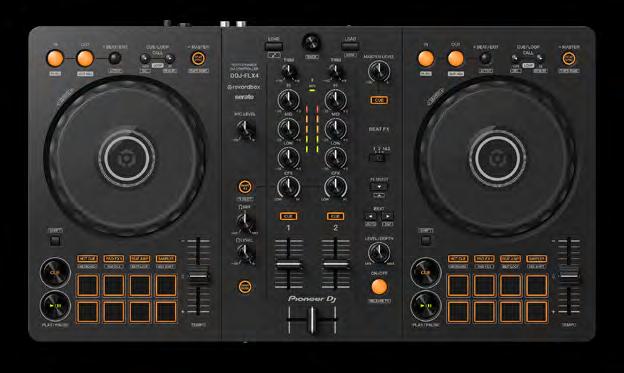
Whether you want to connect to a PC, Mac, iPhone, iPad, or an Android phone or tablet, the DDJFLX4 is compatible with all of the above, with Bluetooth functionality on its way with the next update for an even broader array of options at the input level.
Along with the Hot Cue, Pad FX, and Sampler functions that make use of the eight touchpads beneath each deck, there are some cool additions in the mixer section that make it easier for the beginner DJ to pull a mix together faster than ever. The new Smart CFX knob, found just below the EQ controls in the central mixing panel, applies a combination of effects that can be dialled in and out to your liking. It kind of reminds me of the Effects button that was introduced on the early DJM mixer models back in the ‘90s. Great fun, with sometimes unexpected effects and no need
to worry about adjusting features, just wind it up and let it whirl.
For beginners, the ability to scroll through and cue potential tracks by order of BPM will definitely go a long way to help ward off those awkward silences, at the very least. With a host of streaming services working in conjunction with Pioneer DJ, you can have seamless library integration and access to Beatport, Tidal, Soundcloud, and more. Literally millions of tracks can be streamed directly to your laptop, so you shouldn’t have any issue filling the space.
But the real highlight with the DDJ-FLX4 has got to be the Smart Fader feature. Over the years we’ve seen the development of BPM matching and other functions to help create a seamless mix, but this has just taken it to a whole new level. Engaging the Smart Fader button allows you to use the crossfader as a ‘do it all’ mix feature. It adjusts the BPM of the outgoing channel to match up to the incoming channel, as well as adjusting bass volume and level of the two channels as you slide the fader across. This is applied to both the crossfader and the channel faders, depending on which method of mixing you prefer to use. It’s that simple.
For those new to DJ’ing, the smart fader is an excellent way to introduce mix ideas like cutting the lows/mids, FX builds, and other crossfading techniques into your repertoire or as a means to avoid potentially awkward segues from track to track under the pressure of public performance. As your confidence grows, a simple push
of a button and the smart fader is now disengaged and the training wheels are officially off, much in the same way that intermediate DJs would disengage autosync on controllers past.
DJ’ing has never been bigger than it is currently and with so much fresh blood entering the culture, it makes sense to provide a hardware option that offers a gradual, natural learning curve while maintaining the same sense of fun that drew us to DJ’ing in the first place.
Almost like the DJ equivalent of bumper bowling, the DDJ-FLX4 is simple to get started with, but with an obvious and apparent means of growth as your skills progress and your outcomes change. As a vehicle for fast tracking this kind of progression, the DDJ-FLX4 is nothing short of ideal and its extensive library access and ease of compatibility offer plenty of selection options at the track level.
If this one isn’t on your Chrissy list already, there’s still time to drop a subtle hint or two. The box is even compact enough to be wrapped with a standard roll of Christmas wrapping paper. Pioneer DJ has optimised everything on this one.
BY ROB GEE
61 mixdownmag.com.au PRODUCT REVIEWS / MI
PIONEER DJ
Volt 476P
CMI MUSIC & AUDIO |
ENQUIRE FOR PRICING
With such a rich history of creating some of the most iconic and widely used analogue equipment ever to have graced the recording studio, it’s no surprise to see that Universal Audio continue to push the boundaries of recording gear today. Such famed pieces such as the 1176 limiting amplifier and the 610 tube preamplifier have been the bedrock of recorded music since the late 1950s and early ‘60s.
So how does such historic equipment find a place in the modern home studio, given the obvious differences in budget and floor space? The answer lies in something like the new Volt 476P, a convenient and feature-packed audio interface that makes full use of UA’s unrivalled modelling and DSP capabilities to provide users with something that is both classic in its sound and modern in its workflow and integration.
For those unfamiliar to the Universal Audio product line, UA have long been synonymous with blurring the lines between the analogue and digital worlds of recording – creating high-quality products ranging from their tried and true analog outboard hardware through to their flagship Apollo line of interfaces. The latter offers superb AD/DA conversion, sophisticated onboard processing power, and the ability to record with industry-leading digital emulations of vintage analog preamps from the likes of UA, Neve, API, SSL, Manley, and more. All of this is of course done in real time, accurately reproducing the feel and workflow of an analogue studio.
To some, the release of the entrylevel Volt line of interfaces came as a bit of a shock, as it meant the first foray into the entry-level audio interface market for UA, whose premium product lines had come to define so much in the modern professional studio. Back in September of this year, the brand announced a further expansion of their new Volt family with the Volt 4 and Volt 476P –two new interfaces each packed with four microphone preamps, allowing for additional possibilities for multichannel recording and mixing.
At its core, the Volt 476P is a desktop-based four-input and four-output USB audio interface and is capable of recording at 24-bit/192kHz for Mac, PC, iPad, and iPhone. It features four XLR/ TRS combo jacks for handling both mic level and line level signals, each with the ability to accept Hi-Z instruments and provides 48V phantom power for condenser microphones.
The mic preamps have a dynamic range of 112dB (A-weighted), THD + Noise of -103dB (0.0007%) (1kHz @ 1% dBFS), equivalent input noise of -127dBu and 55dB of available gain. While this isn’t the largest amount of variable gain I’ve seen on an entry-level interface, one would have to think that this has been optimised to suit UA’s industry leading approach to preamp emulation.
Two headphone outputs are provided on the front panel with independent volume control, delivering loud and clear audio while tracking and mixing, as well
as direct, no latency monitoring while tracking. On the rear panel, all of the balanced 1/4” outputs are found, with L/R monitor and line outputs 1-4. There’s MIDI 5 in/out connectors, as well as the expected connections for power and USB-C to your computer.
As for the processing side of things, the Volt 476P has both the vintage preamp mode and 76 compressors selectable on every channel. The vintage mode engages a cleverly crafted tube preamp emulation, taking inspiration from the prized 610 console preamp. This circuit adds some distinctive tube-like character to the sound, but more detail on this in a bit. As for the 76 compressor – this can be used on any input source, be it mic, line, or Hi-Z. This is a genuine analogue circuit based on the infamous 1176 compressor, bringing sound sources immediately upfront and into focus. This feature alone sets the 476P worlds apart from other interfaces at this price point.
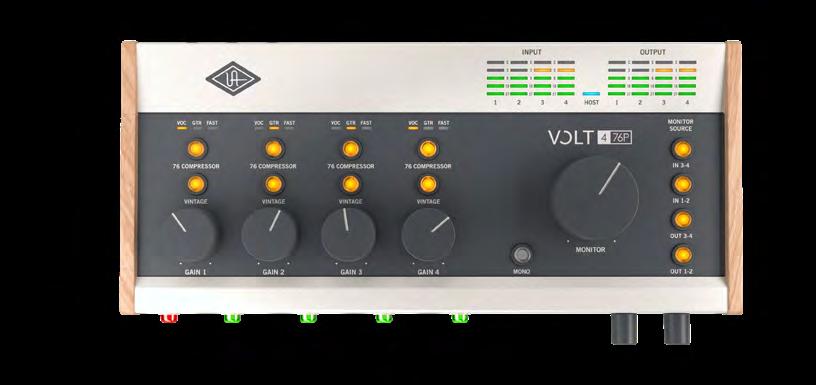
Straight off the bat, the Volt 476P sounds great and is incredibly easy to use. The intuitive layout and simple configuration make adjustments to input and output levels quick and easy, while the LED metering provides immediate info on where things are at levels wise. Being able to quickly select the vintage mic pre and compressor circuits at the press of a button makes absolute sense and allows for speedy auditioning of sounds.
I love what the vintage emulation does on vocals and guitars, adding a roundness and thickness to the
sound, with added depth and character, and the lack of fumbling around with squished in dials is a real treat – in terms of tactile functionality it feels way more like an analogue studio and less like a small format audio interface.
Cycling through the 76 compressors’ three modes keeps this analogue workflow going nicely, with settings for vocals, guitar, and a general fast mode for transient material. While the ratio remains at 6:1 on all modes, the attack and release times change, providing just enough flexibility here without this feature being a bit of a novelty. When the compressor is engaged, sounds jump forward, adding punch and clarity, with that sense of smack and immediacy an 1176 is known for, pretty darn cool.
Overall, pulling satisfying sounds with the Volt 476P is easy and really enlightens a sense of fast paced workflow, which I think few interfaces in this end of the market can boast, at least not quite in the same way the Volt 476P does. With plenty of I/O, processing power, and a packed software package, the Volt 476P ticks a lot of boxes for the price. Its I/O flexibility, slick aesthetic, and ease of use are great, but the ability to tone shape and compress signals on the way in is really what does it for me, satisfyingly separating this interface from the rest of the audio interface pack.
BY ANDY LLOYD-RUSSELL
62 mixdownmag.com.au UNIVERSAL AUDIO
PRODUCT REVIEWS / AUDIO
GoAux 4
JANDS | ENQUIRE FOR PRICING
Most of you should know KRK monitors by now. In fact, I would hazard a guess that most readers will have heard a pair of the yellow-coned speakers at some point. They have been around for long enough, and proven popular enough to be found in a wide range of professional and home studios alike, as well as being integrated into general listening and home theatre setups too. The Rokit series alone would be responsible for thousands upon thousands of speaker sales within Australia. And with such a wide range of options in their lineup, KRK has now gone one step further and developed a studio monitoring system that you can take anywhere. With the KRK GoAux 4, the mobile studio just became more efficient, and better tuned to its space, wherever that may be.
The heart of this system is a pair of four-inch KRK powered monitors, but they have been designed to be portable. So, with that in mind, KRK has built a single power amp into just one of the housings. The other runs a passive speaker powered by the first with an included speaker cable. This not only reduces the weight of the second speaker, and the overall weight of the system, but it also requires just one power cable, making it easier when power points are limited. While we’re talking about connectivity, the rear panel of the main speaker has inputs offered by ¼” balanced TRS connectors, RCA, 1/8” stereo jack, and Bluetooth. There’s also a headphone output on the front panel that mutes the speakers for silent monitoring when needed.
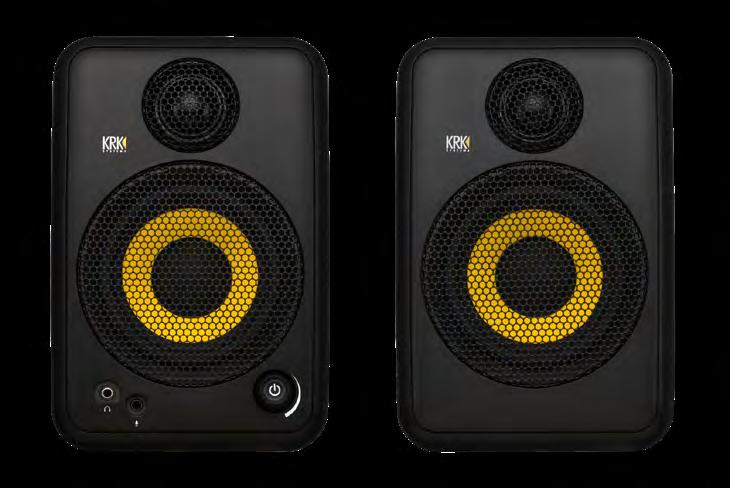
Designed to be used as a compact nearfield monitor, KRK understood that the perfect position for these speakers was going to be different in every environment. So, they have included a pair of compact speaker stands that allow you to angle the position of the speakers for best results. Let’s face it, when you’re taking your recording, mixing, or editing on the road with you, you never really know what space you’ll have to set up in. Often, a low desk space with no shelves for the speakers leaves them too close and firing into your stomach region. This is far from ideal listening conditions
and will only serve to diffuse the transient response, reduce the high frequencies, and deliver an unbalanced signal. So, the stands allow you to adjust the angle of the speakers to get a more directional sound that is targeted to your listening position. When not in use, they fold up neatly and slide away into the included KRK GoAux 4 carry bag.
Yes, this speaker system comes with its own padded carry bag, so you will be all set to take them wherever you need to go. It has space for both speakers, the stands, all cables, and the included ARC microphone. For those of you who haven’t heard of KRK’s ARC microphone, let me fill you in.
The ARC microphone is designed for Auto Room Correction and was originally developed for use with KRK’s Ergo system to be used with larger studio monitor and subwoofer setups in professional studios. KRK has now integrated that hardware and DSP into the GoAux 4 so you get a compact room correction device within the speaker itself. Once both speakers are set up in the ideal location to suit the space, the microphone is set up in the listening position and connected to the main speaker. Pressing the ARC button on the rear of this speaker initiates the process. It runs though an
extended series of different tones at varying sound pressure levels, which somewhat sound like you may have just broken your system. At the end of this process, a short low frequency signal is sounded to notify you that the auto room correction is complete. The microphone can then be stored away until any changes are made to the listening environment that would require a new ARC process to be run. The result can be likened to spending an extra thousand bucks on your speakers. They suddenly jump from sounding great, to magnificent.
The process doesn’t just analyse the high and low frequencies in the room to balance the EQ of the speakers, there’s a lot more to it than that. It takes into account the reflections caused by hard surfaces and low frequency boom created by unavoidable bass traps. This results in a more balanced audio signal that vastly improves the stereo imaging, especially when working in a room that isn’t perfectly symmetrical in design and décor, as just about every room is. A window on one side of a room can dramatically affect how two speakers working in stereo sound as reflections from only one side are coloured differently. The RC process works to alleviate these differences and bring a more
natural, balanced audio image to your listening position.
The result of all this is a greatsounding, compact audio monitoring system that can be set up in just about any space. Best of all, within a few minutes, it can be tuned to work with that space. This will get you closer to having consistent listening environments in different spaces if you have to work on the go. The result will be not only a more enjoyable listening space, but more balanced stereo imaging and low frequency control in your work. Then, when you’re done, it all packs neatly into the included carry bag so you can take your monitoring to a new location, knowing well that you’ll have a comparable sound when you set up there too.
BY ROB GEE
63 mixdownmag.com.au PRODUCT REVIEWS / AUDIO
KRK
YAMAHA
AG03 MK2 Live Streaming Pack
YAMAHA MUSIC AUSTRALIA | ENQUIRE FOR PRICING
I am sure many of you will have seen the AG01 review a few months back when we took an in depth look at Yamaha’s “allin-one” streaming microphone solution. It’s a great, compact option for home recording and live streaming, but it does come with its limitations. For those of you looking for a little more flexibility in your live streaming setup, without going overboard on equipment, then Yamaha has something that’s going to be just right. Let me introduce you to the Yamaha AG03 MK2 Live Streaming Pack! It’s a microphone, mixer, and headphone combination that takes your home recording and live streaming to the next level with individual components that offer greater connectivity.
Where the AG01 puts everything into the microphone housing, the Yamaha AG03 MK2 Live Streaming Pack separates the microphone, preamp, and mixer for a more conventional recording setup. Yes, this takes up a little more real estate on your desk, but it opens up the possibilities for much more creativity. The Streaming Pack consists of three main components. Central to the setup is the AG03 MK2 mixer, this is teamed up with a YCM01 cardioid condenser microphone and a pair of YH-MT1 headphones. A 10” XLR microphone cable is also included for connecting your microphone and completing the setup. Let’s take a look at each component first.
The AG03 MK2 three-channel mixer is the heart of this setup. Its main channel is a mono input capable of supplying phantom power for use with the microphone. However, it does feature the now-standard XLR/ TRS combination jack, so you can connect a line level input instead of your microphone should you so wish. The second input section handles channels two and three on a stereo pair of ¼” TRS connectors which are ideal for a keyboard or similar stereo source. There is also a mono Hi-Z input in this section to connect a guitar. Outputs are supplied on both stereo RCA and ¼” TS connectors, with a ¼” TRS headphone output too. There are also connections for a headset microphone and an auxiliary input, like an MP3 player, both on mini
jack inputs. Then, the built in AD/ DA converters joins all this to your computer via the USB connection. What this means is that the AG03 MK2 mixer is really a well-featured audio interface, but presented in a familiar mixing console layout.
The master bus routing in this compact mixer allows for a number of different setups, from a standard inline recording process to a live mixer and, most importantly, as a streaming hub with your laptop. The loopback function in the bus section allows you to take audio from your computer’s media player and feed that into the mix along with your microphone and instruments, then send the combined signal back into the computer to be recorded as one. This is a process that would previously have involved additional channels on a mixer, as well as the great possibility of creating a feedback loop that simply ruined your entire recording. Now, Yamaha has simplified that so you can include audio from your computer into the mix that then gets recorded, back into your computer!
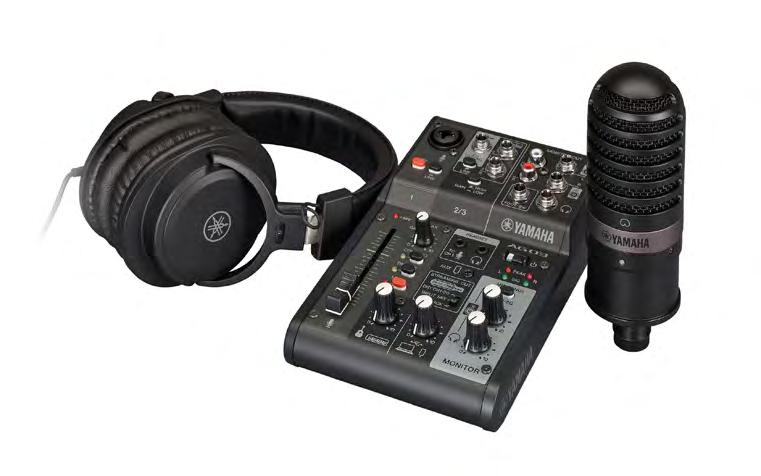
Next, we have the YCM01 cardioid condenser microphone. This is a robust unit that comes in a matching colour to the mixer and headphones, so everything matches. Being a larger diaphragm condenser microphone, you will notice an increased sensitivity
to most handheld dynamic microphones. You get brighter, more lively high frequencies that give your voice a certain “air” that is often muffled out with a dynamic microphone. It also offers a big bottom end to really give your voice presence. You can forget about using that tiny little microphone on your mobile device or laptop when recording video or audio, the sound difference is incredible.
The YCM01 is a condenser microphone, so it needs phantom power supplied from the AG03 MK2 mixer, but that is no problem as the included XLR cable allows power to be supplied to the microphone, as well as sending a balanced audio signal to the mixer. This balanced signal keeps interference and noise to a minimum. The microphone will pick up sound from the front of the capsule, and to a lesser degree, off to the sides, but it cancels out sound from the rear of the capsule. So with a cardioid pickup pattern, it can be positioned as such to block out unwanted sounds like computer or environmental noise and improve the quality of your audio recording.
The YH-MT1 closed-back headphones are a studio-quality pair of cans that offer not only great sound and excellent isolation, but comfort too. Fitting completely over the ear, they keep
the sound in with little spill, so you can listen to playback audio while recording and not have the playback sound filter its way into your microphone input. Of course, comfort is the key with these headphones, especially if you’re going to spend an hour or two in a streaming session.
Put all these components together and you have a handy, yet compact, setup for live streaming. Of course, it works as a traditional audio recording station for musicians with the ability to connect a range of instruments. But, with the routing options in the AG03 MK2 mixer, this Yamaha AG03 MK2 Live Streaming Pack is extremely well suited to someone looking to get a simple recording, mixing, and streaming setup to interface with their laptop. With onboard DSP processing for effects and support for PC, Mac and iOS in the AG Controller software, you can integrate this setup to just about any existing hardware. Now, all that is left is for you to get busy and start creating great content.
BY ROB GEE
64 mixdownmag.com.au PRODUCT REVIEWS / AUDIO
Engineered to perfection iLoud Precision
iLoud Precision series represents another breakthrough in nearfield monitoring from the company that revolutionised compact monitors with iLoud Micro Monitor and iLoud MTM.
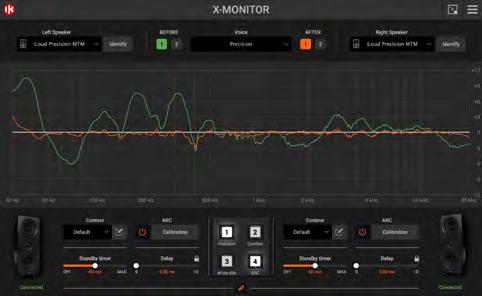
Available in a choice of 3 configurations — 2-way 5” or 6.5”, and 2 x 5” MTM — these handmade works of sonic art reflect IK’s 25+ years of expertise in loudspeaker design and digital signal processing, delivering a level of sonic detail that beats speakers at three times the price, with unique DSP-based features and software workflow enhancements that can’t be found anywhere else.

X-MONITOR
adjustments to
fi
The iLoud Precision series introduces , a newly developed advanced control application for Mac and Windows that assists with ARC calibration and enables extended acoustic and voicing selection and ne-tune iLoud Precision to your taste, plus convenient remote access to the settings on the Precision’s back panel. The software is plug-n-play via a simple USB connection with no special setup needed.
For more information, contact your favourite music store Proudly distributed in Australia by Sound And Music
or visit:
https://sound-music.com/brand/ik-multimedia/


Beatkit Pro
ELECTRIC FACTORY | ENQUIRE FOR PRICING
Lewitt Audio is a relatively new audio company hailing from Vienna, Austria – a city which plays host to some of the most pioneering audio companies around today. Lewitt has been at the forefront of some rather ingenious microphone designs over the past decade or so, with products such as their prized LCT 1040 microphone and the company as a whole breaking the conventional model of microphone design, with a distinctive flare for adaptation.
With a wealth of individual condenser and dynamic microphones in their already impressive range, it seemed only a matter of time before Lewitt Audio introduced a drum mic package, and sure enough that’s what I got the opportunity to take for a test run – the new Beatkit Pro.
The Beatkit Pro is a seven-piece drum microphone package with all the trimmings, including mic mounts, clamps, windscreens, and an ostensibly bullet proof mounded transport case. The microphones included in the set are the DTP 640 REX, MTP 440 DM, three DTP 340 TTs, and a stereo pair of LCT 140 AIRs. Straight off the bat, the Beatkit Pro is impressive with its array of mics and accessories, going beyond what would be defined as standard. What’s more, these microphones certainly wouldn’t be limited exclusively to drums but can be thrown in front of numerous other sound sources, making this mic kit a great live or studio confidante.

Perhaps a little bold, but I’m going to say the Beatkit Pro could almost stretch itself to being an eight-piece kit, and I say this purely because of the DTP 640 REX. For those unfamiliar with this rather unique microphone, its design implements not one, but two phase aligned capsules – a dynamic and a condenser. The five-pin connector on the body of the mic splits out to the included DTP 40 TRS Y cable, allowing each capsule to be sent to individual preamps on a console or audio interface, essentially giving you two microphones in one housing.
The frequency response of the DTP 640 REX ranges from 20Hz16kHz for the dynamic capsule and up to 20kHz on the condenser. Sensitivity when running flat is rated at 0.4 mV/Pa (-69 dBV/ Pa) for the dynamic and 2 mV/Pa (-54 dBV/Pa) for the condenser.
Max SPL at 0.5% THD and 0dB attenuation is 150dB SPL, so needless to say, the DTP 640 REX can take a fair walloping and the pre attenuation pads with options of 0, -10, and -20dB helping keep unruly sound sources in check.
There are three distinct sound characters available too. The default position is flat, the second position boosts the low frequencies from the dynamic capsule while the condenser stays flat, and the third position engages both capsules, with the dynamic boosting between 4-6kHz and the condenser extending the low frequency response. Having these distinctive flavours available in
the mic itself is pretty unique and allows for a fair bit of tonal shaping without needing to reach for an EQ. I’d see this being particularly useful for those recording straight into an audio interface wanting to be able to shape the sound source a little on the way in.
The MTP 440 DM is the Beatkit Pro’s dedicated snare mic. With a frequency range of 60Hz-16kHz and a rated sensitivity of 2.5mV/Pa (-52dBV/Pa) and focused cardioid polar pattern, the MTP 440 DM is a great companion for snare, bringing a punch and snap which is rather gratifying. The three DTP 340 TTs do a solid job of capturing toms while the stereo pair of LCT 140 AIRs are a great choice for overheads, with a few sneaky switches on the chassis of the mic offering a -12dB pad, an 80Hz high pass filter, and a sound character switch, giving a little boost to the top end if required.
I decided to test the Beatkit Pro in a live setting, miking up a kit for a couple of hard hitting indie rock bands.
Setup was relatively quick and easy and although the clamps for the DTP 340 TT mics were rather difficult to wrangle into position with their rigidity, they might soften and flex a little over time.
After adjusting mic gain, pulling a sound from the Beatkit Pro was lightning fast, particularly being unfamiliar with both the mics and the drum kit.
The DTP 640 REX was a treat to dial in, finding a nice blend
between the dynamic and condenser capsules. I would happily use this mic to cover both kick in and kick out duties, with the detail, attack, and depth of the condenser and the roundness and punch of the dynamic.
The MTP 440 DM placed on the snare top immediately provided plenty of body and snap, requiring very little additional processing and sat in the mix nicely. Nothing spikey or any glaring overtones here. I used the DTP 340 TT on rack, floor, and snare bottom –all of which benefited from this microphone’s honest capture, providing plenty of tone and detail to the respective sounds sources. I was particularly impressed with the depth of the floor tom that was reproduced. Although a little light in the hand for my liking, the LCT 140 AIRs for overheads sat well in the mix, with a nice amount of detail and dare I say air, albeit without needing to engage the sound switch on the mic.
Overall I found the Beatkit Pro great to use, with dialling in a satisfying drum sound being very quick and easy. The overall presentation and amount packed into this kit is impressive, especially given the very reasonable price point. Special mention has to go to the DTP 640 REX – what a cool design and solid sound signature. There’s plenty to play with in the kit, producing some pleasing results. A drum mic kit packing plenty of punch indeed.
BY ANDY LLOYD-RUSSELL
66 mixdownmag.com.au PRODUCT REVIEWS / AUDIO
LEWITT AUDIO
A44H Active Studio Monitors
FOCUSRITE AUSTRALIA | ENQUIRE FOR PRICING
The ADAM Audio A44H is a twoway powered studio monitor, with a familiar 19” width and compact overall profile, being noticeably shallower in height compared to other horizontally orientated monitors available.

Two 4” Multi-Layer Mineral (MLM) woofers (comprising six layers) take care of low end duties. Their Class-D PWM amplifier comes in with a peak (10% THD, limiter deactivated) of 110W and RMS (1% THD, limiter deactivated) 90W. All-round solid performance.
The A44H of course proudly encompasses ADAM Audio’s prized X-ART tweeter, handmade in Berlin. The tweeter has a 2” equivalent diameter and is surrounded by a high frequency propagation waveguide, providing more accurate and even dispersion, this being 120-degree horizontal and 70-degree vertical. The tweeter module itself is rotatable 90 or 180 degrees. Yes, this means the ADAM Audio A44H isn’t limited to its default horizontal orientation and can be positioned vertically as well, which, depending on one’s space or application is a big plus, without running into the habitual acoustical issues reorientation can invite without a rotatable waveguide.
The tweeter amplifier is a Class A/B type, running at a peak (10% THD, limiter deactivated) of 20W and RMS (1% THD, limiter deactivated) 15W. The crossover frequency sits at 2.4kHz. The overall performance and frequency response of the A44H is solid, with a rated frequency response of 49Hz-41kHz at -3dB and 46Hz-45kHz at -6dB, with a max peak SPL at 1m per speaker of 110dB (IEC-weighted noise) and 103dB SPL (sine-bursts).
As for connectivity, inputs on the rear panel are either XLR (balanced) or RCA (unbalanced). Input level can be adjusted from 0dB positioned at noon on the dial located on the back panel, through to -12dB and +12dB. My only criticism here is that the dial isn’t stepped, which I’m always a fan of for these types of critical controls, for more precise matching, but this isn’t a deal breaker. As expected, the A44Hs come with a sound five-year warranty (when registered) for peace of mind.
Across the new A-series range, some rather convenient voicing options are included and are selectable via the rear panel button. These voicings are pure – a more linear response curve and UNR (Uniform Natural Response) – a more colourful voicing, which will be recognisable to those familiar with older ADAM Audio monitors, including the trusted AX series. Lastly, the Ext voicing harnesses the ADAM Audio A Control, which can be used in either the Advanced or Sonarworks SoundID Reference modes. All these voicing options provide a wealth of possibilities for users to tailor their monitors from subtle to more refined tuning via Sonarworks SoundID, which is some impressive integration and processing under the hood to say the least.
Room adaption toggles are included on the back panel also, ideal for fast and effective adjustments. Four bands named bass, desk, presence, and treble can be finely adjusted between -1dB and -4dB or +1.5dB depending on the frequency band, giving plenty of fine tuning if required.
While these settings are certainly useful for those using their
monitors in the one space, being able to slightly tweak to that environment, having these adjustable parameters available for those continually working in unfamiliar environments will likely be a welcomed feature. A comprehensive section in the user manual provides some useful settings for typical room placements, which provides a great starting point.
Given the 19” width, the A44Hs didn’t feel cumbersome or overwhelming in size, but instead rather compact, comfortable, and easy to place. Their lower profile looks awesome, particularly with the dual 4” woofers and dual-sided flare porting on the front. These monitors look the business.
Upon firing them up, the now familiar boot up sequence did its thing, with the front LED indicator going from orange to green. Putting on some familiar material, I was immediately impressed with the punchiness of the A44Hs. Tight, defined, and not over working. Turning them up (not quite to 11), really allowed the woofers to work and the dual design really came into its own. Upon quieter testing, detail and clarity was nicely retained, with the upper midrange and top end really being shown off through the X-ART tweeter. Silky smooth and not the least bit fatiguing.
Turning to a Pro Tools session, I immediately found mix decisions quick, easy, and consistent. Monitoring at different volumes again allowed for instantaneous feedback and direction, without much second guessing. Throwing on my familiar set of headphones as a reference check confirmed this, and I was able to build a
cohesive mix quite fast given these weren’t my usual set of monitors. The clarity in the mid range I found particularly appealing, helping sculpt space for guitar and vocals and informing me where I needed to spend more or less time finessing. The detail in the top end was wonderful for determining reverb decay and delay times, as well as modulation. I didn’t find the A44Hs to be overwhelming in any parts of the frequency spectrum, not hyped, nor under baked –overall an honest representation of source material.
Given their unique profile and quite striking appearance, the ADAM Audio A44H is no doubt going to turn some heads. They certainly did for me when having them set up for review. Their slender height will no doubt make them an appealing option for multi-channel or immersive setups (it’s almost born to be placed as a centre channel), and it’s clear that the engineering wizards over at their Berlin HQ put some serious thought into this.
Not only an enjoyable monitor to listen to, but most importantly, an informative one. The ADAM Audio A44H monitors do indeed perform superbly in the studio, providing the level of detail, clarity, and honesty one comes to expect from an ADAM Audio studio monitor.
BY ANDY LLOYD-RUSSELL
67 mixdownmag.com.au ADAM AUDIO
PRODUCT REVIEWS / AUDIO
YAMAHA
ZG01 Game Streaming Pack
YAMAHA MUSIC AUSTRALIA | RRP: $699
The Yamaha ZG01 pack comes with the ZG01 audio interface and the YH-G01 gaming headset. The headset is very comfy and fits snuggly on the head. The cups were large enough to cover my ears completely, which makes wearing them more comfortable and lowers strain on the ears, which can become painful after those long gaming sessions perpetually extended by “just one more game”. The sound quality is great and will serve well for listening, gaming, and audio editing. These are gaming headphones, so don’t expect them to be able to compete with studio and monitor headphones, however I consider these to be a decent all rounder that will serve well for beginners and intermediates alike. Included with the headset is a detachable mic that is inserted into the left ear. The mic itself is of decent quality and will do well in casual gaming and for chatting with friends. However, as with any headset mic, the sound quality won’t have you at the content creation levels of PewDiePie, but Yamaha has a swathe of options if you were looking to level up in that department like the AG01 USB mic or the YCM01 cardioid condenser microphone. The mic will get the job done and you will still be able to produce content with it, but it would be best to consider upgrading to one of those higher quality microphones if you plan on doing this sort of thing long term.
The audio interface itself is the real selling point of the bundle. The ZG01 is designed for streaming specifically, and by all accounts it tackles its one job very well. The unit itself has one XLR/TRS combo jack for condenser and dynamic mics, as well as two 3.5mm inputs for headphones and a headset mic, which also comes with a splitter which separates your headphone/ mic combo input so that you can have independent control over each. On the back of the unit are two HDMI inputs for consoles and a USB input for your computer. Each audio source has its own independent controls making it very easy to adjust levels of each signal to find a healthy balance. You are even able to route audio from voice chat applications such as Discord into its own channel of the interface, giving you a single
knob adjustment without having to go through the app itself. It should be noted that if you intend to have multiple consoles hooked up, you’ll need an extra 5v power supply to get the signal.
What’s so practical about the ZG01 is that it acts as a splitter for two HDMI sources, meaning that switching between two consoles and your PC requires no extra physical setup. With just the press of a single button, you are able to switch between and mute the different sources. This switcher means that you also only need a single capture card for your entire setup, as the interface acts as a ‘thru’ device for your consoles, capturing the audio while passing the video signal through to your capture card or monitor.
The interface also comes with some fun and practical effects. On the faceplate, there are three effects for the incoming mic signal, and three EQ presets for the game audio. The effects for the incoming signals include two customisable presets with options for pitch control, reverbs, and modulation effects. The third effect is an echo delay which you can assign the length of the repeats. The other three effects are for processing game audio, with presets tailored for specific types of games, such as first person shooter, story-based
games, and more. The presets are a really fun addition to the unit that I’m glad they included. It was a lot of fun messing around with the voice setting and I can see it being a great tool for entertainment. I really hope Yamaha adds more options in the effects, as this aspect was easily the most fun and playful part about the unit that I can see a lot of people utilising in their streams.
The interface also employs the use of the Yamaha ZG Controller software, which is used to dial in custom presets as well as a general overview of incoming and outgoing signals. Here is where you can set the streaming audio output and set the levels of what the audience will hear, which allows you to adjust the settings from the unit itself without affecting the stream’s audio. Within the software is where you can add some more practical effects such as compression, gates, and EQs to the mic signal in order to get more professionalsounding recordings. The interface even has a surround sound emulator to convert the surround sound HDMI signal to a stereo signal, while still maintaining the illusion of surround sound.
Overall, the Yamaha ZG01 pack is an excellent choice for anyone looking to get into streaming. The
interface’s ability to act as a splitter makes it very convenient for anyone planning to play different games over multiple consoles. Independent controls over each audio source makes finding a nice balance very easy and immediate, and the built-in effects are a ton of fun. I can see many streamers utilising the effects in creative ways, especially when they are available at the press of a button.
The ZG controller software makes editing and dialling in your sound a breeze, as well as providing a single location for monitoring your levels. The YH-G01 headphones are a great addition to the unit, and will serve any streamer well, however you may want to consider upgrading to a standalone mic for high sound quality.

As a complete package, I was very pleased with what is included, and you would be hard pressed to find an interface with as much practicality in the streaming space as the ZG01, making it a viable option for beginners and experienced streamers alike
BY CAMBELL COURTNEY
68 mixdownmag.com.au PRODUCT REVIEWS / AUDIO
FOCUSRITE
ISA One
FOCUSRITE AUSTRALIA | ENQUIRE FOR PRICING
With VST synths and sample replacements for drums becoming commonplace in many projects, bedroom ambition or Billboard mainstay, interfaces with large numbers of preamp inputs are becoming increasingly unnecessary. Those looking to make their recordings sound more professional on a budget are better off putting the money towards high quality gear with fewer inputs, to maximise recording quality where it matters the most, which will predominantly be vocals.
You could reach this conclusion, go and buy an interface with highend AD conversion to run a couple of different microphones through and decide that anything more is unnecessary, and achieve great sounding results. Many people have. But what you won’t get is world-class sounding recordings with a sound that you can truly call your own.
The arcane knowledge of preamplification marks the cusp of the transition between the hobbyist engineer and the true professional. Starting to match high-end preamps with different microphones is when you stop painting by numbers, it’s when the recording studio really starts to become its own instrument. As fun as this sounds, the romance starts to fade when you realise how much this game costs to play.
In a Reddit thread asking about how pop artists achieve their “consistent sound”, user Raspberries-Are-Evil writes: “I have worked with Dua Lipa in the past. Her producer was very particular about the vocal chain as well. They wanted a Sony C800 and a Neve 1073 and a Fairchild. I have these items in my studio and they still sent, overnight mind you, this gear because they wanted these specific units”. With a Fairchild 670 recently going for $80,000 on Reverb.com, this would put the price of Dua Lipa’s vocal sound in today’s market at an eye-watering $100,000. This may only be a small price relative to her success worldwide, but for those of us who haven’t quite hit international stardom this presents a dilemma. It’s a kind of catch-22 situation where we are cognizant of the necessity of such gear to let us transcend merely sounding “great”,
but also can’t spend time learning to use this gear so we can paint our unique sonic imprints due to the prohibitive cost of entry.
This is where the ISA One comes in. Focusrite’s ISA One is a portable, rugged preamplifier that gives you world-class circuitry and unmatched versatility at a very accessible price.
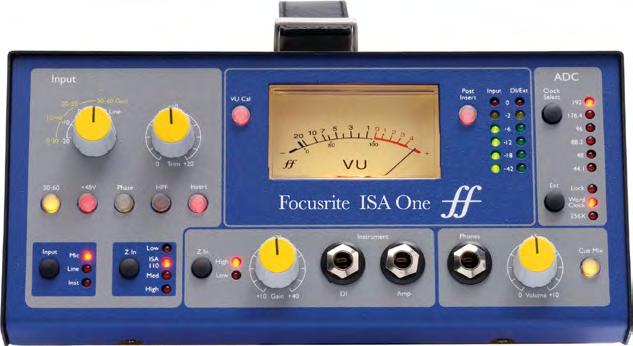
Inside a metal chassis the size of a lunchbox lies the preamp circuit of Focusrite’s ISA 110 preamp, recreated using the same Lundahl LL1538 input transformer as originally designed by the late Rupert Neve for George Martin’s console at AIR Studios. The sloped face of the unit sports a distinctive coat of royal blue with yellow highlights, with a field of controls that are almost overwhelming at first sight. An input button lets you switch between balanced XLR and TRS ports for mic and line level inputs and unbalanced DI instrument input. Standard switches for Phantom Power, Phase, and High-Pass Filter are present, with a button to switch the gain knob’s range of control between 0-30 dB and 30-60 dB gain for mic level input. An Insert button engages the insert circuit that can be patched in via the send and return ports on the rear of the device. A Trim knob offers an additional 20dB of gain for Mic and Line inputs. A button labelled Z In is where things start to get really interesting. Focusrite
is deeply aware of the effect of preamp input impedance on the character of a microphone, and have included four levels of input impedance to help shape your sound. These four impedance levels – 600 Ohms, 1.4k Ohms as in the original ISA 110, 2.4k Ohms and 6.8k Ohms – all achieve different sound characteristics for a given microphone. Lower impedances reduce microphone output and emphasise low-mid peaks and natural resonances of the microphone, whereas high impedances make things louder, brighter, and flatter. This is of particular interest to any ribbon microphone owners. Ribbon microphones are the most sensitive to variances in impedance, and the ISA One has enough gain to power them. Stick your ribbon mic in front of a guitar amp and play around with the ISA One’s input impedances until something magical happens. By giving you the ability to control input impedance, Focusrite is practically handing you the holy grail of electric guitar sounds.
The ISA One comes with an optional A/D conversion card that supports sample rates of up to 192kHz that connects to your DAW via Dante. A clock select button on the right-hand side of the unit lets you switch between different internal sample frequencies all the way up to the 19 kHz maximum, with
another button letting you swap between a standard world clock and Dante network clock, with an LED indicating successful synchronisation. The ISA One has an independent headphone amp with dedicated volume control. Cue mix inputs on the rear of the device let you patch in your DAW’s output for real-time monitoring. And right in the middle of the ISA One, beside two LED input meters sits a nice big VU Meter. Lovely!
The ISA 110 preamp circuit has a clear, warm sound. The colouration isn’t as overt as that of some tube-based preamps, but therein lies the key advantage of the unit – you can use the ISA One to record numerous input sources without needing to fear the stacking effects of a colourful preamp used on multiple tracks. You could record an entire album with this thing alone! The portable nature of the ISA One makes it the ideal tool to help you get your own signature sound consistently wherever you go (just like how the very best do it). The versatility and quality of sound offered by the ISA One makes it a truly unique product, the only one of its kind, and represents an opportunity to capture world-class recordings that reflect this uniqueness in kind.
BY LIAM MCSHANE
69 mixdownmag.com.au PRODUCT REVIEWS / AUDIO
GRAVITY STANDS
SA SM IF 01 Absorber Pucks
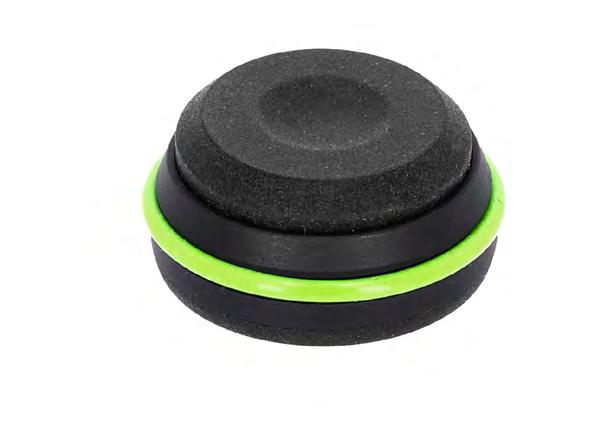 LINK AUDIO | RRP: $59 (FOUR PACK)
LINK AUDIO | RRP: $59 (FOUR PACK)
Gravity is a brand that is popping up more and more in recent years with an expanding array of welldesigned, useful products. Yes, they make microphone stands, speaker stands, keyboard stands, guitar stands, lighting stands, and just about every other stand you can think of. But, they also offer a range of niche products that offer an ‘outside the box’ approach to audio production and live performance. And it’s in these lesser-known products that we can find inspiration and a new level of quality in our work. One such product is the SA SM IF 01, it’s a bit of a mouthful, and possibly means nothing to those who don’t live their lives dealing with product codes, so for the rest of this piece, we’re going to refer to them as the Gravity Absorber Pucks. Let’s take a look at what they can do for your studio environment.
It’s amazing how much money people will invest in their studio monitors and think that they will achieve great sound simply because they bought great speakers. While this is partly true, more often than not, there are other factors in play when it comes to the listening environment that don’t allow the great speakers to operate as best as they should. Poor quality cables, unbalanced connections, dirty power, and hard surfaces or bass traps in untreated rooms are all problems that come to mind. I am sure these are all considerations made by many home recording enthusiasts when setting up their new studio monitors. Placement is another factor that often gets a lot of discussion. But, this generally revolves around position and angle of the speakers themselves, considering the listening position and the surfaces behind, in front and above the speakers. What is often overlooked, and critically so to achieve better sound and a truer stereo image, is the surface below the speakers.
The surface on which the speakers are placed will inherently become a part of the speaker if left untreated. Think about it, the speaker derives its sound not only from the moving cone, but from the cabinet it is housed in. This is why great pains are taken to ensure a cabinet and porting
that matches perfectly with the driver. Placing a speaker on any surface forms a bond between the cabinet and that surface, and the vibrations of the cabinet then take on characteristics imparted by the surface too. Plonking your speakers on a shelf above your desk without any thought is essentially increasing the size of the cabinet and giving it a rather awkward shape too. The problem is multiplied when you place two speakers on the same surface. They then begin sharing their new ‘cabinet’ structure, and so affect how each other performs. Have a think about what this is doing to your stereo imaging, when the left speaker is directly connected to the right speaker and vice versa, sharing vibrations and affecting each other’s tonal characteristics. This was not how the speaker manufacturers intended these speakers to be heard, and I am sure is not giving you the best sound in your listening position.
So, now that I’ve gone on about the problems many of us have with speaker placement, let’s look at fixing this. This is where we bring in the Gravity Absorber Pucks and wish we’d had these sooner. These great little devices uncouple your speaker cabinet from the surface they are sitting on and allow the cabinet to behave on its own, as it was designed to do. They are pretty simple to use.
One goes under each corner of your monitor speakers, so that they sit well balanced and stable. To achieve this balance with slanted speaker cabinets, the height of the Absorber Pucks is adjustable with a tilt angle of up to 15 degrees per puck.
Housed within a powder-coated steel ring, the Absorber Pucks feature a combination of silica gel and EVA foam to offer strength and isolation. Each puck can handle a load of up to 9kg, so a set of four will happily handle a speaker up to 36kg without performance issues. This means that powered speakers with large transformers and heat sinks won’t be a problem. Furthermore, any imbalance in weight distribution due to displacement of the power transformer in the cabinet can be adjusted by adding a little extra height to the puck under that region.
Now, may I say, the results speak for themselves. Even a modestly priced pair of power monitors jumps to life with the addition of two sets of Gravity Absorber Pucks. The stereo image appears to widen instantly, allowing you to hear more definition on both sides of the mix. Suddenly it sounds like you’re listening to two independent speakers delivering distinct signals, rather than a wall of blurred sound. Add to this
the removal of further vibrations caused by low frequency rumble through the desk and the signal becomes more lively and well defined. You don’t realise how much noise you’re listening to in your furniture until you take it away!
They look sleek, they’re easy to set up and adjust for different speakers, and they improve the sound in your listening positions instantly. About the only criticism I have is that they are supplied in packs of four, when you know you’re going to need eight pucks right away. That said, I can see why this has been done, as many users will have an uneven number of speakers, so it makes sense to supply in single speaker quantities. Now matter how much you spend on your monitor speakers, cables, power filters, and room treatment, you can, and should, improve what you hear with Gravity Absorber Pucks.
BY ROB GEE
70 mixdownmag.com.au PRODUCT REVIEWS / AUDIO
BABY AUDIO
IHNY-2
BABY AUDIO | ENQUIRE FOR PRICING
In such a fiercely competitive landscape, plugin companies are up against it in 2022. Whether it be creating faithful algorithmic representations of famed and favoured analogue hardware or immensely complex processors aimed at combatting the most strenuous of audio tasks, it’s sardines out there in audio plugin land.
I first came across Baby Audio a few years back with the release of their first plugin, the I Heart NY parallel compressor. Straight off the bat, the name caught people’s attention, being a dedicated parallel dynamics processor with a cheeky tip of the hat to where this particular dynamics process found a lot of specific use, ala New York. Cool, now there was a no nonsense plugin designed for a specific purpose with some powerful processing under the hood. Fast forward to 2022, Baby Audio has released a new version of I Heart NY – IHNY-2. A freshly updated take on an already vibey plugin. Firstly, the user interface of the Baby Audio IHNY-2 is lush, striking a fine balance of sci-fi aesthetic, which is fun and intuitive to use. It’s clear the Baby Audio team has put in a lot of work and attention to detail into this area of their plugins, and for this particular plugin, is a big improvement on the GUI of IHNY v1.
The mixer section of IHNY-2 couldn’t be simpler to use. It looks great and the visual feedback it gives is both interactive and informative. The mixer operates in a simple XY (or horizontal and vertical) axis configuration, with the vertical controlling the wet/ dry blend and the horizontal the intensity of the compression. Being able to move your signal around in this area allows for very quick auditioning of source material, as well as detailed, fine tuning of the simplest controls of the compressor.
The AGR (Adjusted Gain Reduction) feedback on the left side of the mixer gives immediate visual feedback of the amount of gain reduction that’s happening, and the immediacy of this as you move around the mixer is awesome. This paired with the expanding and contracting visuals of the mixer is pretty enthralling.
The auto gain slider is convenient, and as many would know or have experienced, auto gain in compressor plugins can be a little hit and miss, quite often more of a miss. What I like about having the slider is that it gives you the flexibility of dialling this in to taste rather than just on/off.
The other more “nuts and bolts” features located at the top of the plugin include oversampling modes (1, 2, and 4) with 1 being the lightest on CPU, solo – which monitors just the wet signal, tool tips – for explanations of the plugin parameters, save as default – allowing users to save the current settings as the default when opening the plugin, a pretty handy option, as well as being able to reset to default, resize the plugin window.
The part of IHNY-2 which brings about the biggest changes to its predecessor is the tweak section. Clicking on this opens up a drop down panel at the bottom of the plugin with parameters for attack and release, ratio, punch, harmonics, shape, tilt, and lo and hi preserve.
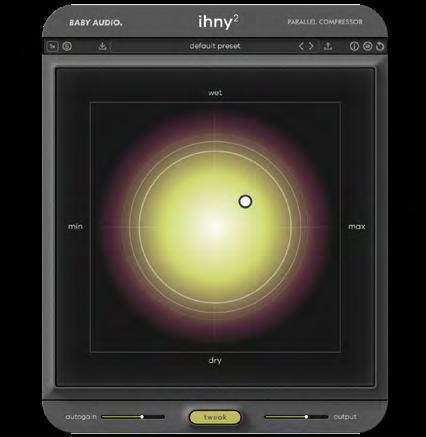
While several of these controls are somewhat ‘standard’ or expected controls in a modern day compressor, being able to really delve into specific tonal and dynamic shaping takes IHNY-2 a step further – having these types of controls placed in the one
plugin is really nice, particularly given how easy the controls are to use. This again is testament to the Baby Audio take on the user interface and overall styling of the plugin – slick, sophisticated, and damn near impossible not to use oh so intuitively.
Pulling up IHNY-2 in a session, I inserted it into several elements including drums, bass, and vocals. I was particularly eager to see how it would interact with some live drums and upon dropping it on the drum buss, IHNY-2 immediately got to work. With some quick adjustments on the mixer and the auto gain slider, I was able to get the drums sitting in a spot surprisingly quickly. Then with some further finessing in the tweak panel, things really came alive, bringing power, clarity, and control to the drums in the track.
Just on the kick drum, IHNY2 worked pretty nicely too, especially when exploring the punch, harmonics, shape, and lo and hi preserve parameters. This made for far more detailed control of the kick drum without the need for a heap of additional plugins or parallel processing paths via additional routing in the session.
The tonal characteristics of IHNY-2 worked nicely for the bass track in this session, immediately parking it where it needed to be and giving it some additional character which I was into. Being able to have the
compressor set quite aggressively then dialling in the desired balance between wet and dry signals so quickly on the mixer was very gratifying.
The mixer’s visual feedback I found particularly useful when working on vocals, giving a really interesting and unique way of visually gauging attack and release times, not to mention the obvious gain reduction. A bit more exciting than the typical meter, but equally as informative.
Parallel compression is by no means anything new, but IHNY-2 certainly brings a new approach to an age-old technique. The seriously updated user interface, wealth of additional controls, and overall ease of use makes for a plug that is lots of fun to use. And as for the sound, this thing packs a serious punch and vibe! With the ability to go from super subtle to outright obliteration, the Baby Audio IHNY-2 covers a lot of dynamic processing ground, with a few extra tasty treats thrown in for good measure.
BY ANDY LLOYD-RUSSELL
71 mixdownmag.com.au
PRODUCT REVIEWS / AUDIO
HIT’N’MIX
RipX: DeepCreate
HIT’N’MIX | ENQUIRE FOR PRICING
DeepCreate is the latest addition to RipX creating a digital audio processing platform. It would be inaccurate to refer to this software simply as a DAW, because of how differently it operates in almost every way.
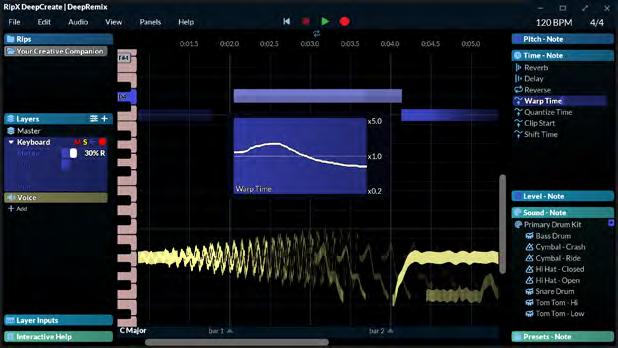
Whether you’re working with MIDI or audio, the approach is the same. Rather than using a system aiming to simulate the workflow of a large-format console, the interface is far more flexible and open-ended. This makes the overall feel of the software closer to the experience of using tracker software, while the signal processing style has more parallels with Photoshop than it does with a major DAW system.
Because of its completely different design philosophy, it takes you a little while to get your head around the interface. However, once you throw your DAW user habits out the window, you begin to see that DeepCreate isn’t trying to be Pro Tools or Ableton Live.
Initially, the main window looks somewhat similar to a MIDI editor with its familiar-looking piano roll, but you will quickly learn that it’s far more complex. On either side of the editing area, you have completely customisable toolbars. Here, each dropdown menu provides access to a list of functions that you can drag between the two areas to create your own workflows. This makes more sense as you’ll learn there isn’t one prescribed way of working with DeepCreate.
Almost every function in DeepCreate relies on the powerful RipX engine. To see how this works, simply drop a mixed stereo audio file into the edit window for the system to begin decoding the track’s information. As you drop the file in, you’re immediately confronted with the Ripper options popup window that allows you to choose between single or multitrack audio processing and you can specify which parts of the audio you want to extract and work with.
Once the ripping is complete, you’ll see that the file has been divided into multiple lanes of what appears to be MIDI information in the edit area. Each layer can now be soloed or muted from
the Layers tab and you can begin processing it right away.
Like a DAW, the way DeepCreate is built allows you to use different workflows. Whether you’re creating a new piece of music from scratch, doing corrective editing on an audio file, or remixing an existing production, it provides flexible tools for each task.
Sounds can be processed simultaneously or individually for more precise control, simply by selecting the part and specifying the degree of the sound or effect you’re adding.
The concept might be confusing at first, but DeepCreate works with samples, instruments, and effects in exactly the same way and each can be added to a selected part within the layer you’re working on, or placed separately. This part gets even more exciting because both software instruments and effects presets can be individually ripped into DeepCreate for quick, simple access and you’re no longer relying on the same level of real-time DSP as you’d expect in a DAW.
The duplicitous way you can approach audio and MIDI means you can use your favourite MIDI controllers to sequence your patterns, or simply beatbox your drums in and replace the audio afterwards a la Timberland.
Each effect parameter and the mix amount can be quickly automated, and the entire process is nondestructive. The way the system is built on working in layers means you can easily
switch between working from an overview or more macro perspective.
To access more advanced editing features, a simple rightclick displays the Audioshop tools. Here, you can change your approach from the default piano roll to working within the frequency spectrum by selecting the edit unpitched feature. Apart from your basic edit functions like split, join, and clone, you can also draw notes and pitch information. What’s more, you can then smooth out extremities and apply modulation to pitch, formant, volume, and panning. Once you’ve added an effect to any note, you’ll notice the automation lane below extends for its duration and you can click or drag to adjust the degree of the effect over time.
Things get really interesting when you add the RipScripts panel from the menu bar, as this gives you access to even deeper algorithmic processing features.
The Harmonic Editor allows you to edit or introduce harmonics to a waveform, with its own set of editing tools and features that allows you to isolate and remove or creatively edit the harmonic content of any selected note or group.
Meanwhile, the Beatmapper provides the means to flexibly edit bar or beat divisions for individual selections of bars or you can do it globally to create a unique rhythm signature.
The RipScripts editor gives you a basic introduction to creating Python-based scripts for adding new features to your workflow. Here, you can also see an overview of the scripts already in use within RipX.
By developing your knowledge of the Python programming language and analysing the available RipScripts, you can start creating your own custom audio processing tools for yourself or other RipX users.
The possibilities here are simply endless as each user – especially those capable of creating their own RipScripts – will have a unique approach to the creative aspects of audio processing.
Unlike any audio or music software package, the DeepCreate environment allows the user to work with unusual fluency, crossing borders and creatively breaking rules that usually apply to working in the box.
You’re provided quick access to advanced digital processing algorithms in a way that isn’t obscure or overwhelming. In fact, it’s loads of fun, and the simple but customizable design philosophy will appeal to plenty of users out there.
DeepCreate isn’t a substitute for your DAW or a complete music production system, but rather a different way of approaching music and digital audio, regardless of your discipline or focus.
BY STEFAN WYETH
72 mixdownmag.com.au PRODUCT REVIEW / AUDIO


MY RIG: Motez
Intellijel Metropolis
Alm ‘Pamela’s New Workout’
To celebrate the releases, Motez was kind enough to run us through some of the gear in his studio which is enough to make us all pretty damn envious!
MODULAR RACK
“This is the beating heart of most of the basslines, synth arpeggios, and even some drum sounds you hear on most of my productions. My production has completely changed since I delved into the world of modular synths and even though my bank account has drastically suffered, I feel like it’s only going to get bigger.
“The unpredictability (and sometimes instability) makes capturing the once-off magic so important to my workflow, some things you hear in my music were recorded only once and I found it almost impossible to replicate, here are some of my favourite eurorack/modular units I own.”
“A lot of arpeggios you hear in my songs (e.g. ‘Slow Down’, ‘Give Your Heart Away’, remix for Tensnake’s ‘Rules’) are driven by the Intellijel Metropolis which I patch into various synths in the rack. It’s a very simple, but effective arpeggiator which truly signifies the “less is more” way of making music.
“The combination of ‘pulse count’ and ‘gate mode’ transforms your arpeggios beyond a lot of two dimensional ones you sometimes hear.”
Noise Engineering ‘Basimilus Iteritas Alter’
“I found myself using the BIA the most because it sounds incredible, it has so much weight and variation in form that can make it work with more melodic stuff or making some truly gnarly industrial drum and synth sounds, an absolute gem in my eurorack.”
“It’s the beating heart of my eurorack, it syncs tempos and triggers like clockwork, but also provides some weird and random functions that truly adds an important element of unpredictability that makes each time you use the synth different to the last.”
Strymon Magneto

“One of the first units I ever bought and I cannot see myself parting with it any time soon, not only is it a tape delay unit with “tape age”, “wow” and “flutter” that you’d find in any old reel tape machine, but it also has some incredible loop and sample functions that I used a fair bit, especially working on my audiovisual installation ORBIT.”
Sequential Pro-3
“A relatively recent acquisition but a synth that’s found its way almost immediately to
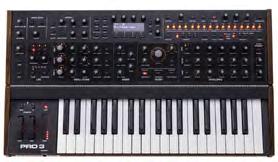
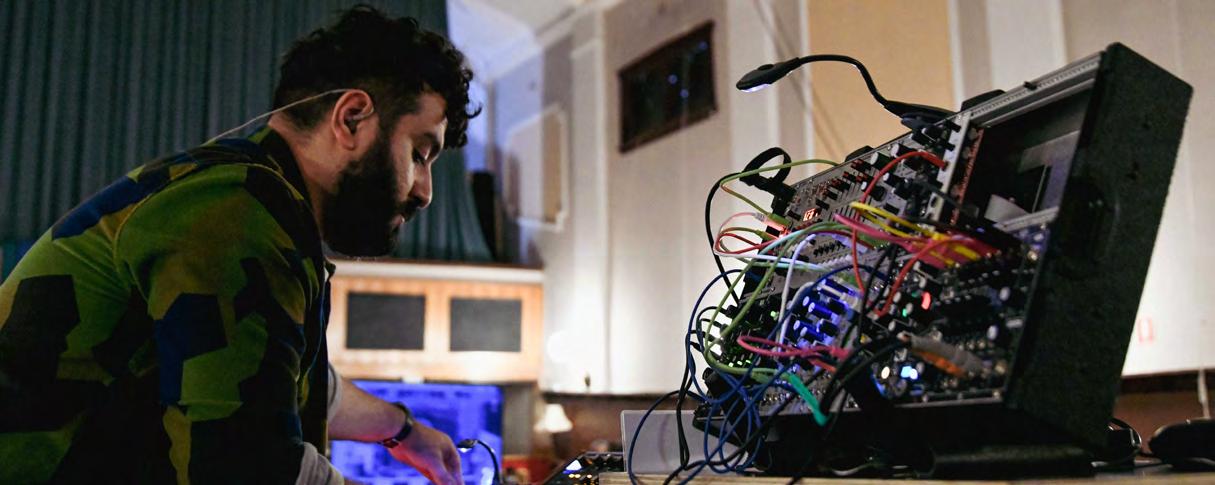
my productions, the various functions and routing options make this not only a very versatile synth in my arsenal, but it also sounds absolutely amazing.
“The paraphonic function is very cool, especially when you pair it with the arp function.
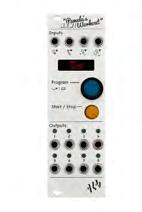


Strymon BigSky
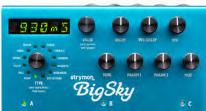
“I use this unit in conjunction with my Moog Sub37 (as well as my Roland DD-200 delay), it’s the holy grail of reverbs for a good reason. It sounds beautiful both in the studio and live, it brings more life to my Moog, especially the big sounding synth moments like ‘ReSet’ and most recently ‘Get it Done’.”
BY ERIC FOREMAN
74 mixdownmag.com.au
Adelaide-based producer and DJ Motez has been a staple in the Australian electronic music scene for a number of years now, and has been busy in 2022 releasing a number of singles.
Basimilus Iteritas Alter
Sequential Pro-3
Strymon Magneto
Intellijel Metropolis
Pamela’s New Workout
Strymon BigSky

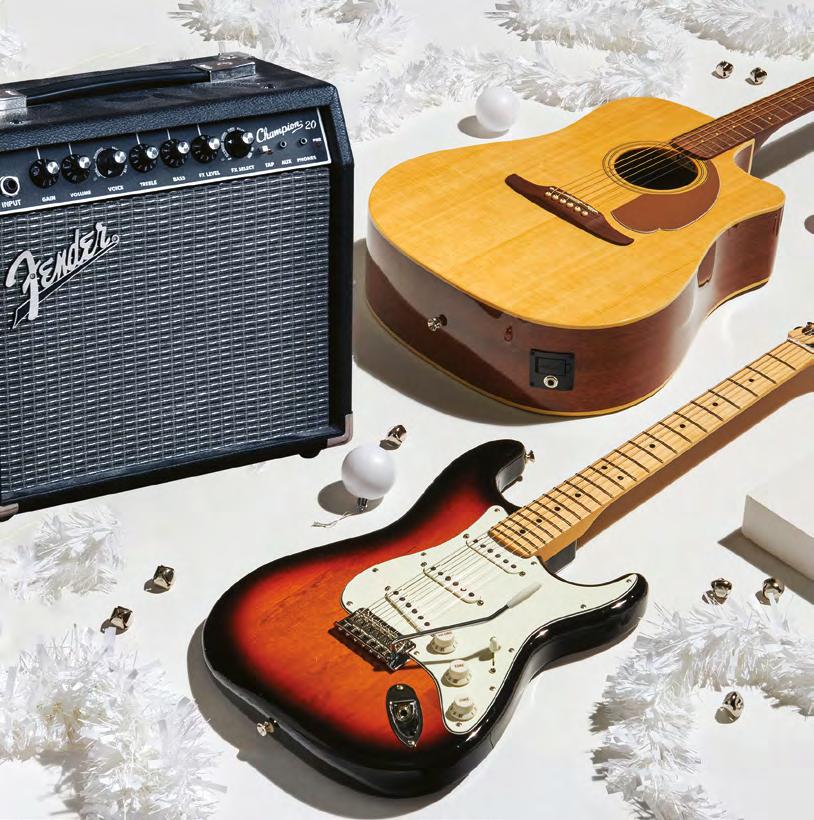



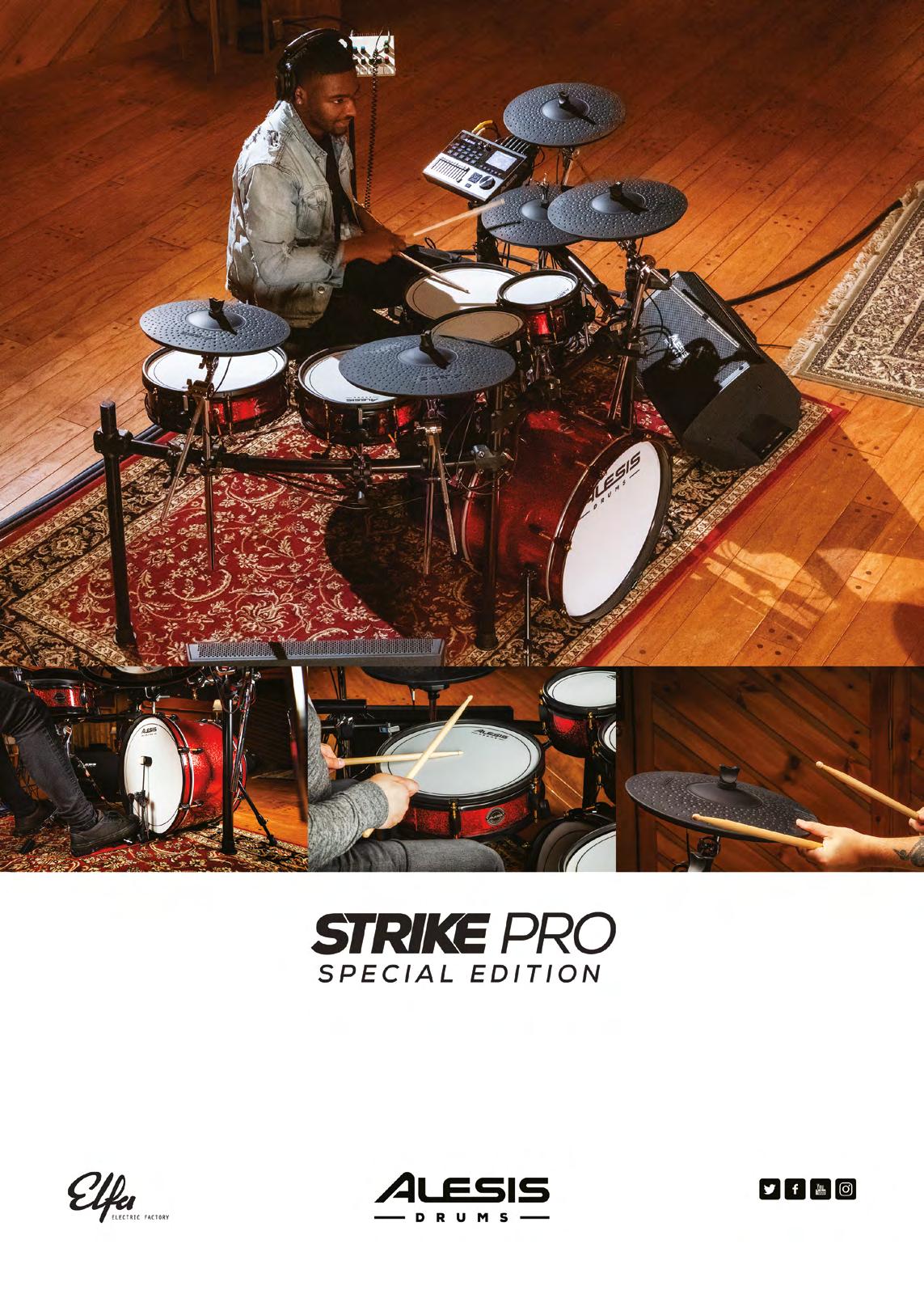

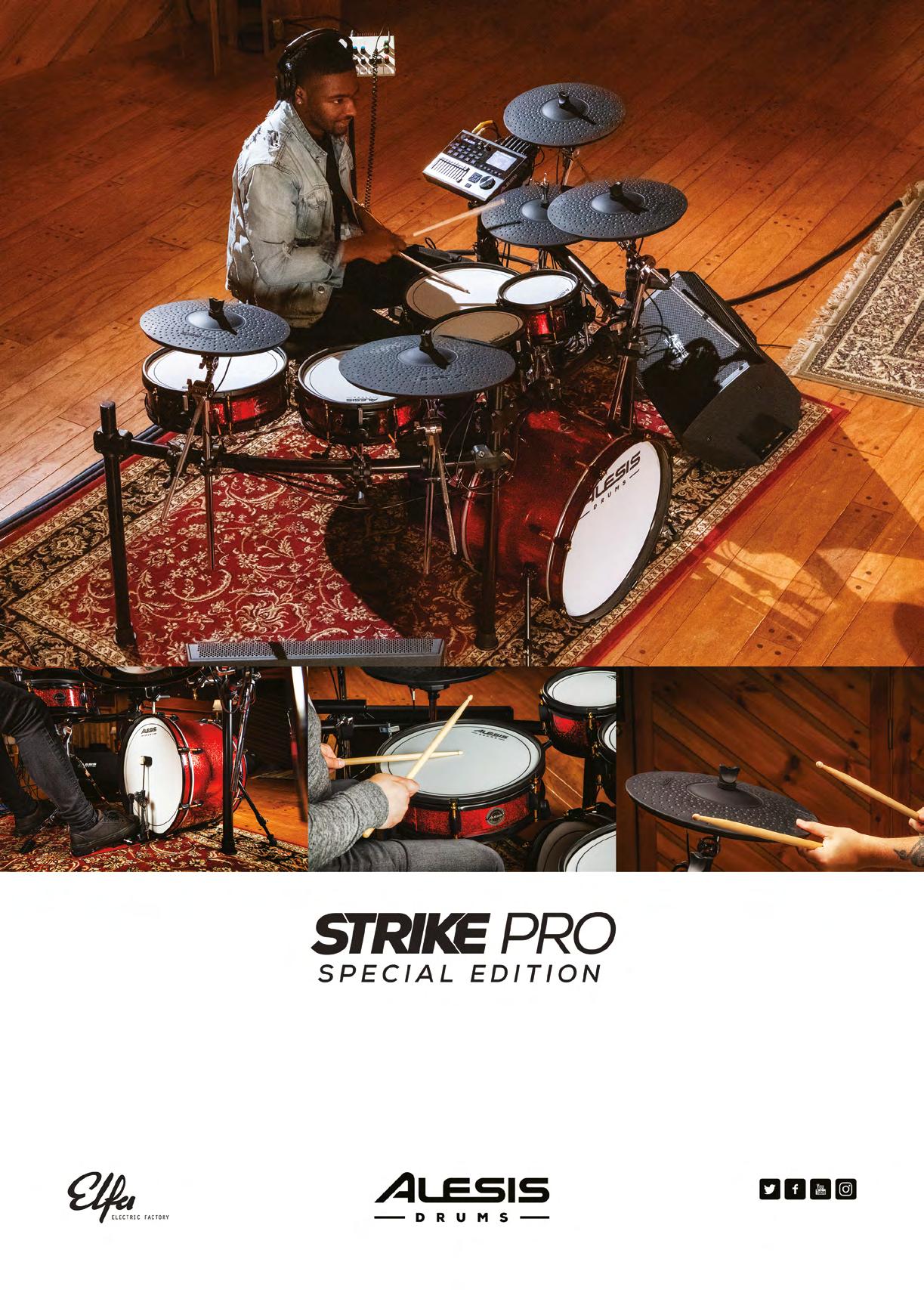



 Hand Made Effects Pedals | Akron, Ohio
Hand Made Effects Pedals | Akron, Ohio

























































































































 BY: FENDER MUSIC
BY: FENDER MUSIC


































 DISTRIBUTED BY: YAMAHA MUSIC AUSTRALIA | ENQUIRE FOR PRICING
DISTRIBUTED BY: YAMAHA MUSIC AUSTRALIA | ENQUIRE FOR PRICING



 DISTRIBUTED BY: FOCUSRITE AUSTRALIA | RRP: $299
DISTRIBUTED BY: FOCUSRITE AUSTRALIA | RRP: $299







































































 DISTRIBUTED BY: DYNAMIC MUSIC | ENQUIRE FOR PRICING
DISTRIBUTED BY: DYNAMIC MUSIC | ENQUIRE FOR PRICING













 BY ANDY LLOYD-RUSSELL
BY ANDY LLOYD-RUSSELL




























 LINK AUDIO | RRP: $59 (FOUR PACK)
LINK AUDIO | RRP: $59 (FOUR PACK)



















